CHCPOL003 Research and Apply Evidence to Practice - Written Report
VerifiedAdded on 2023/04/20
|32
|10153
|237
Report
AI Summary
This document presents a student's written report for the CHCPOL003 unit, focusing on researching and applying evidence to practice in healthcare. The assignment involves researching infection control, identifying areas for improvement in nursing practice, and formulating a research question related to hand hygiene effectiveness in hospitals. The research objective aims to evaluate the impact of hand hygiene practices on preventing hospital-acquired infections, drawing comparisons with practices where hand hygiene is not followed. The report also connects the research to patient safety, emphasizing the prevention of avoidable harm and the importance of a safety culture. Desklib provides a platform for students to access this and similar solved assignments, aiding in their studies and academic endeavors.
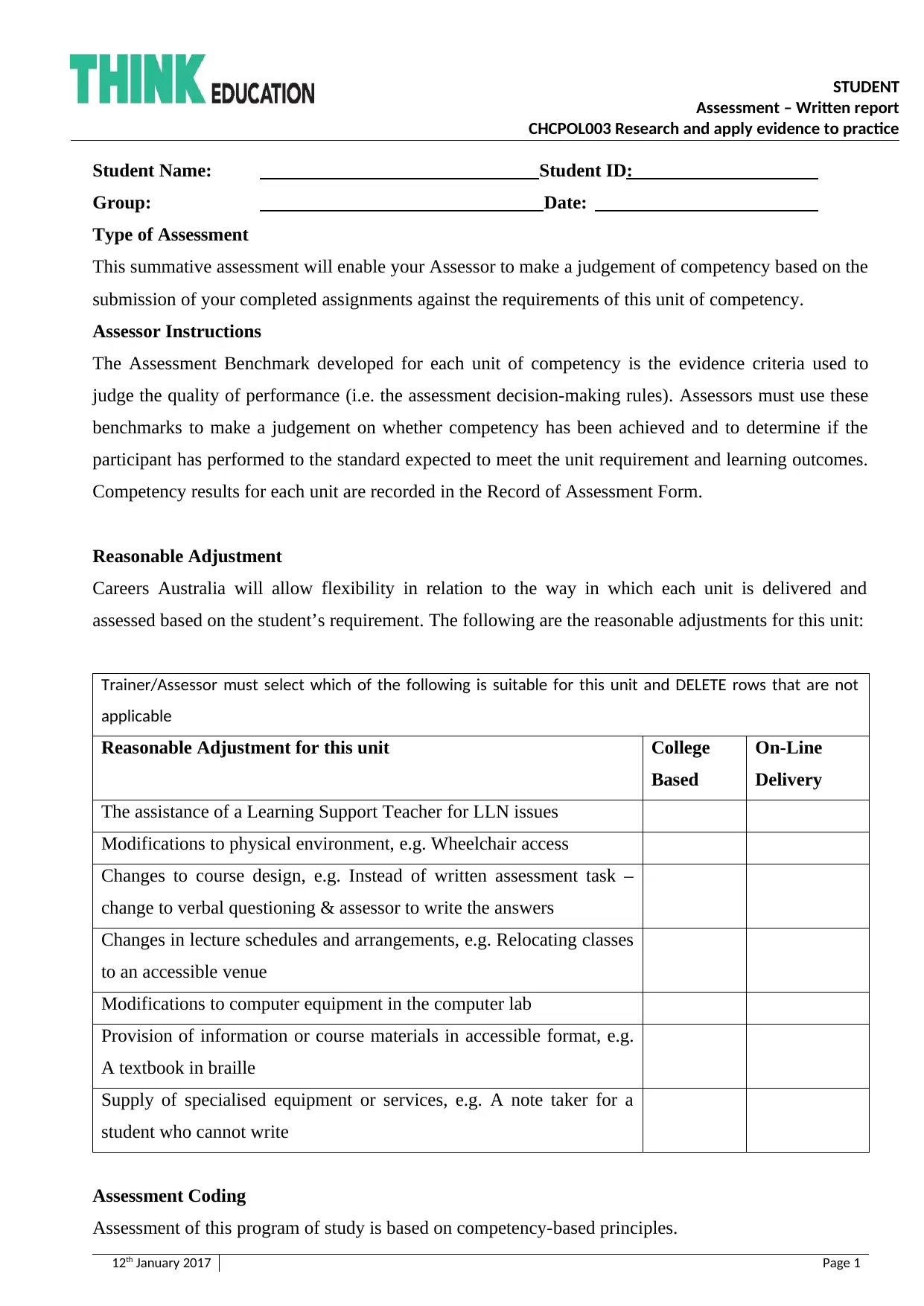
STUDENT
Assessment – Written report
CHCPOL003 Research and apply evidence to practice
Student Name: Student ID:
Group: Date:
Type of Assessment
This summative assessment will enable your Assessor to make a judgement of competency based on the
submission of your completed assignments against the requirements of this unit of competency.
Assessor Instructions
The Assessment Benchmark developed for each unit of competency is the evidence criteria used to
judge the quality of performance (i.e. the assessment decision-making rules). Assessors must use these
benchmarks to make a judgement on whether competency has been achieved and to determine if the
participant has performed to the standard expected to meet the unit requirement and learning outcomes.
Competency results for each unit are recorded in the Record of Assessment Form.
Reasonable Adjustment
Careers Australia will allow flexibility in relation to the way in which each unit is delivered and
assessed based on the student’s requirement. The following are the reasonable adjustments for this unit:
Trainer/Assessor must select which of the following is suitable for this unit and DELETE rows that are not
applicable
Reasonable Adjustment for this unit College
Based
On-Line
Delivery
The assistance of a Learning Support Teacher for LLN issues
Modifications to physical environment, e.g. Wheelchair access
Changes to course design, e.g. Instead of written assessment task –
change to verbal questioning & assessor to write the answers
Changes in lecture schedules and arrangements, e.g. Relocating classes
to an accessible venue
Modifications to computer equipment in the computer lab
Provision of information or course materials in accessible format, e.g.
A textbook in braille
Supply of specialised equipment or services, e.g. A note taker for a
student who cannot write
Assessment Coding
Assessment of this program of study is based on competency-based principles.
12th January 2017 Page 1
Assessment – Written report
CHCPOL003 Research and apply evidence to practice
Student Name: Student ID:
Group: Date:
Type of Assessment
This summative assessment will enable your Assessor to make a judgement of competency based on the
submission of your completed assignments against the requirements of this unit of competency.
Assessor Instructions
The Assessment Benchmark developed for each unit of competency is the evidence criteria used to
judge the quality of performance (i.e. the assessment decision-making rules). Assessors must use these
benchmarks to make a judgement on whether competency has been achieved and to determine if the
participant has performed to the standard expected to meet the unit requirement and learning outcomes.
Competency results for each unit are recorded in the Record of Assessment Form.
Reasonable Adjustment
Careers Australia will allow flexibility in relation to the way in which each unit is delivered and
assessed based on the student’s requirement. The following are the reasonable adjustments for this unit:
Trainer/Assessor must select which of the following is suitable for this unit and DELETE rows that are not
applicable
Reasonable Adjustment for this unit College
Based
On-Line
Delivery
The assistance of a Learning Support Teacher for LLN issues
Modifications to physical environment, e.g. Wheelchair access
Changes to course design, e.g. Instead of written assessment task –
change to verbal questioning & assessor to write the answers
Changes in lecture schedules and arrangements, e.g. Relocating classes
to an accessible venue
Modifications to computer equipment in the computer lab
Provision of information or course materials in accessible format, e.g.
A textbook in braille
Supply of specialised equipment or services, e.g. A note taker for a
student who cannot write
Assessment Coding
Assessment of this program of study is based on competency-based principles.
12th January 2017 Page 1
Secure Best Marks with AI Grader
Need help grading? Try our AI Grader for instant feedback on your assignments.
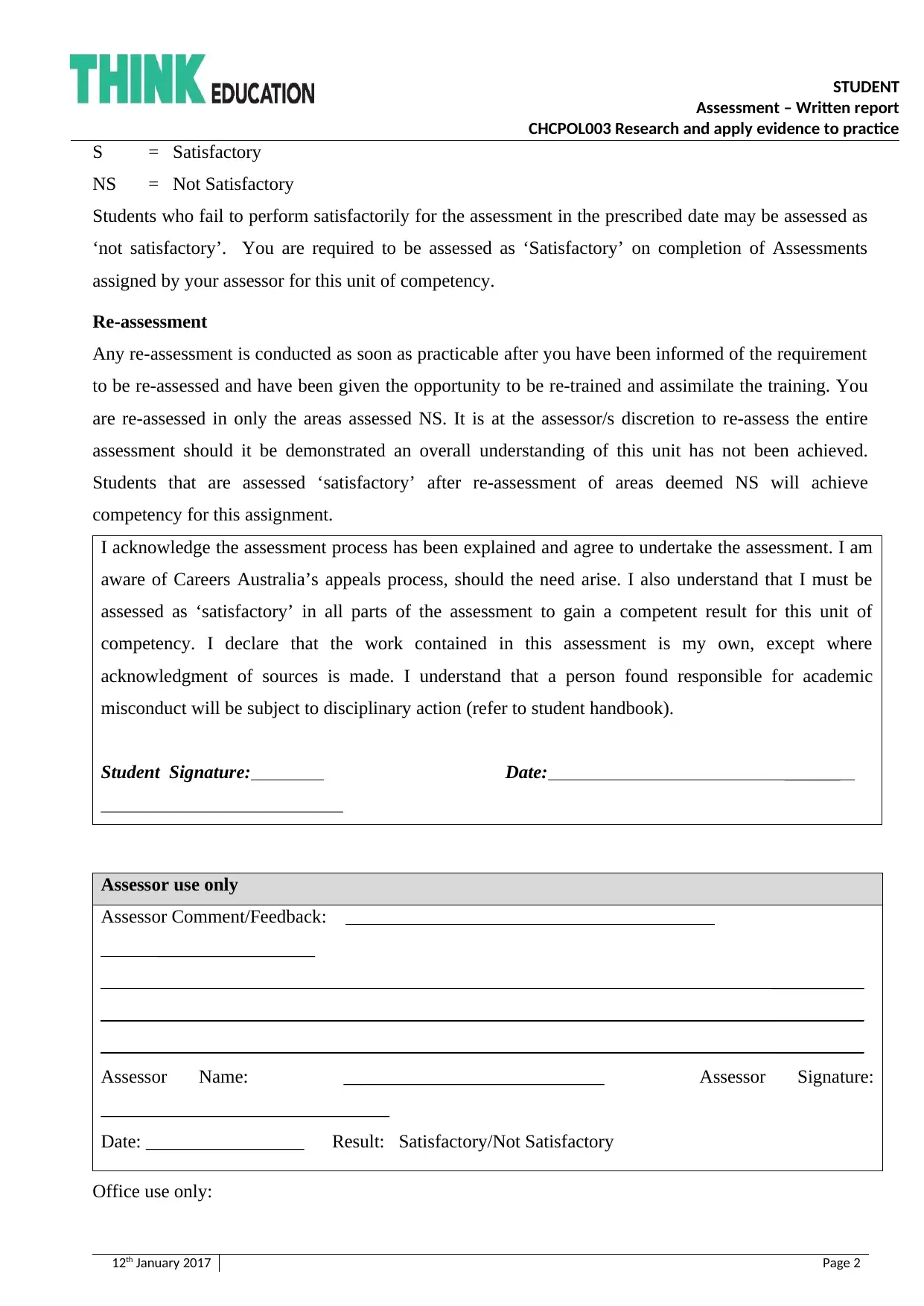
STUDENT
Assessment – Written report
CHCPOL003 Research and apply evidence to practice
S = Satisfactory
NS = Not Satisfactory
Students who fail to perform satisfactorily for the assessment in the prescribed date may be assessed as
‘not satisfactory’. You are required to be assessed as ‘Satisfactory’ on completion of Assessments
assigned by your assessor for this unit of competency.
Re-assessment
Any re-assessment is conducted as soon as practicable after you have been informed of the requirement
to be re-assessed and have been given the opportunity to be re-trained and assimilate the training. You
are re-assessed in only the areas assessed NS. It is at the assessor/s discretion to re-assess the entire
assessment should it be demonstrated an overall understanding of this unit has not been achieved.
Students that are assessed ‘satisfactory’ after re-assessment of areas deemed NS will achieve
competency for this assignment.
I acknowledge the assessment process has been explained and agree to undertake the assessment. I am
aware of Careers Australia’s appeals process, should the need arise. I also understand that I must be
assessed as ‘satisfactory’ in all parts of the assessment to gain a competent result for this unit of
competency. I declare that the work contained in this assessment is my own, except where
acknowledgment of sources is made. I understand that a person found responsible for academic
misconduct will be subject to disciplinary action (refer to student handbook).
Student Signature:
__________________________
Date: ______
Assessor use only
Assessor Comment/Feedback:
_________________
__________
__________
__________
Assessor Name: ____________________________ Assessor Signature:
_______________________________
Date: _________________ Result: Satisfactory/Not Satisfactory
Office use only:
12th January 2017 Page 2
Assessment – Written report
CHCPOL003 Research and apply evidence to practice
S = Satisfactory
NS = Not Satisfactory
Students who fail to perform satisfactorily for the assessment in the prescribed date may be assessed as
‘not satisfactory’. You are required to be assessed as ‘Satisfactory’ on completion of Assessments
assigned by your assessor for this unit of competency.
Re-assessment
Any re-assessment is conducted as soon as practicable after you have been informed of the requirement
to be re-assessed and have been given the opportunity to be re-trained and assimilate the training. You
are re-assessed in only the areas assessed NS. It is at the assessor/s discretion to re-assess the entire
assessment should it be demonstrated an overall understanding of this unit has not been achieved.
Students that are assessed ‘satisfactory’ after re-assessment of areas deemed NS will achieve
competency for this assignment.
I acknowledge the assessment process has been explained and agree to undertake the assessment. I am
aware of Careers Australia’s appeals process, should the need arise. I also understand that I must be
assessed as ‘satisfactory’ in all parts of the assessment to gain a competent result for this unit of
competency. I declare that the work contained in this assessment is my own, except where
acknowledgment of sources is made. I understand that a person found responsible for academic
misconduct will be subject to disciplinary action (refer to student handbook).
Student Signature:
__________________________
Date: ______
Assessor use only
Assessor Comment/Feedback:
_________________
__________
__________
__________
Assessor Name: ____________________________ Assessor Signature:
_______________________________
Date: _________________ Result: Satisfactory/Not Satisfactory
Office use only:
12th January 2017 Page 2
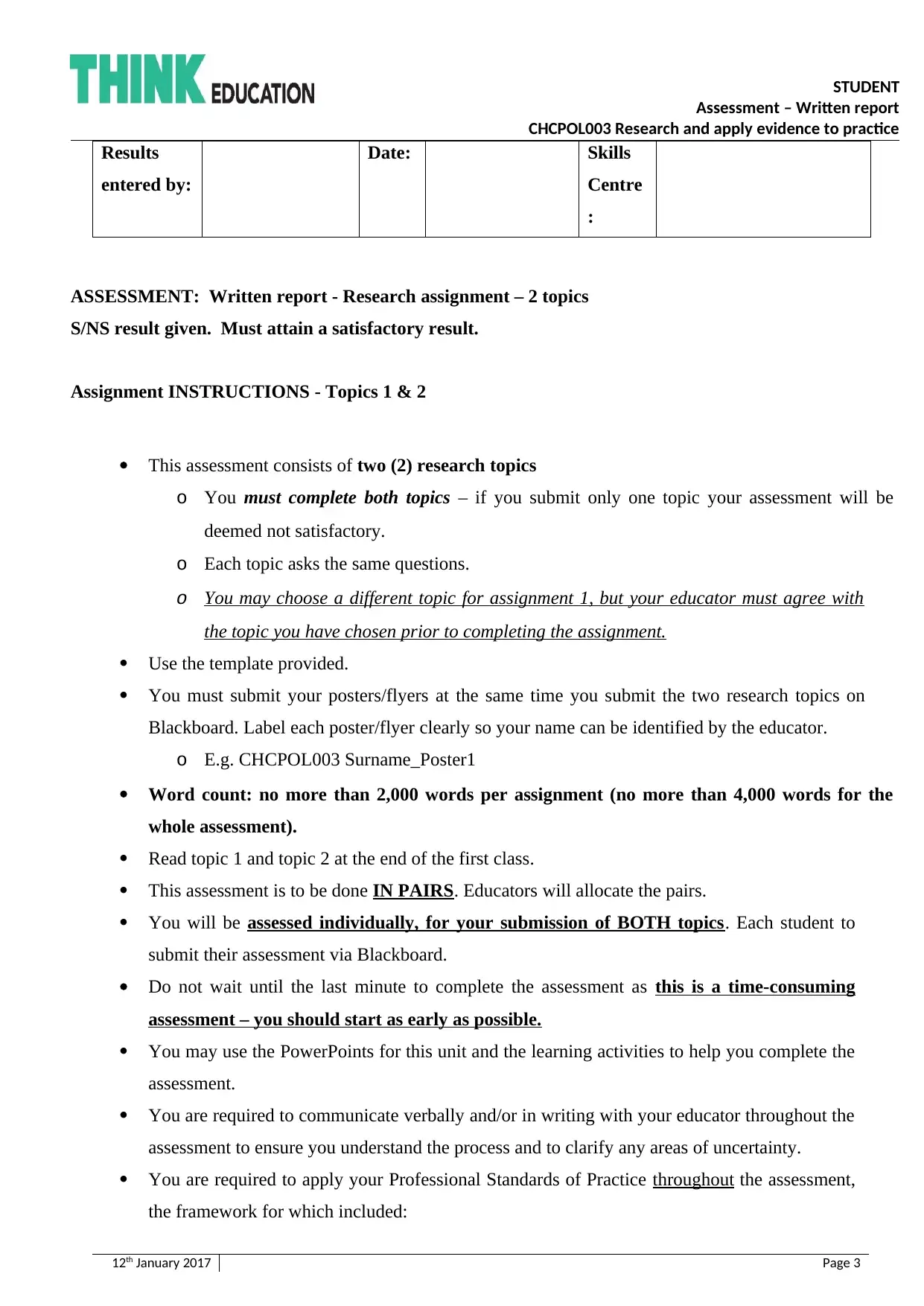
STUDENT
Assessment – Written report
CHCPOL003 Research and apply evidence to practice
Results
entered by:
Date: Skills
Centre
:
ASSESSMENT: Written report - Research assignment – 2 topics
S/NS result given. Must attain a satisfactory result.
Assignment INSTRUCTIONS - Topics 1 & 2
This assessment consists of two (2) research topics
o You must complete both topics – if you submit only one topic your assessment will be
deemed not satisfactory.
o Each topic asks the same questions.
o You may choose a different topic for assignment 1, but your educator must agree with
the topic you have chosen prior to completing the assignment.
Use the template provided.
You must submit your posters/flyers at the same time you submit the two research topics on
Blackboard. Label each poster/flyer clearly so your name can be identified by the educator.
o E.g. CHCPOL003 Surname_Poster1
Word count: no more than 2,000 words per assignment (no more than 4,000 words for the
whole assessment).
Read topic 1 and topic 2 at the end of the first class.
This assessment is to be done IN PAIRS. Educators will allocate the pairs.
You will be assessed individually, for your submission of BOTH topics. Each student to
submit their assessment via Blackboard.
Do not wait until the last minute to complete the assessment as this is a time-consuming
assessment – you should start as early as possible.
You may use the PowerPoints for this unit and the learning activities to help you complete the
assessment.
You are required to communicate verbally and/or in writing with your educator throughout the
assessment to ensure you understand the process and to clarify any areas of uncertainty.
You are required to apply your Professional Standards of Practice throughout the assessment,
the framework for which included:
12th January 2017 Page 3
Assessment – Written report
CHCPOL003 Research and apply evidence to practice
Results
entered by:
Date: Skills
Centre
:
ASSESSMENT: Written report - Research assignment – 2 topics
S/NS result given. Must attain a satisfactory result.
Assignment INSTRUCTIONS - Topics 1 & 2
This assessment consists of two (2) research topics
o You must complete both topics – if you submit only one topic your assessment will be
deemed not satisfactory.
o Each topic asks the same questions.
o You may choose a different topic for assignment 1, but your educator must agree with
the topic you have chosen prior to completing the assignment.
Use the template provided.
You must submit your posters/flyers at the same time you submit the two research topics on
Blackboard. Label each poster/flyer clearly so your name can be identified by the educator.
o E.g. CHCPOL003 Surname_Poster1
Word count: no more than 2,000 words per assignment (no more than 4,000 words for the
whole assessment).
Read topic 1 and topic 2 at the end of the first class.
This assessment is to be done IN PAIRS. Educators will allocate the pairs.
You will be assessed individually, for your submission of BOTH topics. Each student to
submit their assessment via Blackboard.
Do not wait until the last minute to complete the assessment as this is a time-consuming
assessment – you should start as early as possible.
You may use the PowerPoints for this unit and the learning activities to help you complete the
assessment.
You are required to communicate verbally and/or in writing with your educator throughout the
assessment to ensure you understand the process and to clarify any areas of uncertainty.
You are required to apply your Professional Standards of Practice throughout the assessment,
the framework for which included:
12th January 2017 Page 3
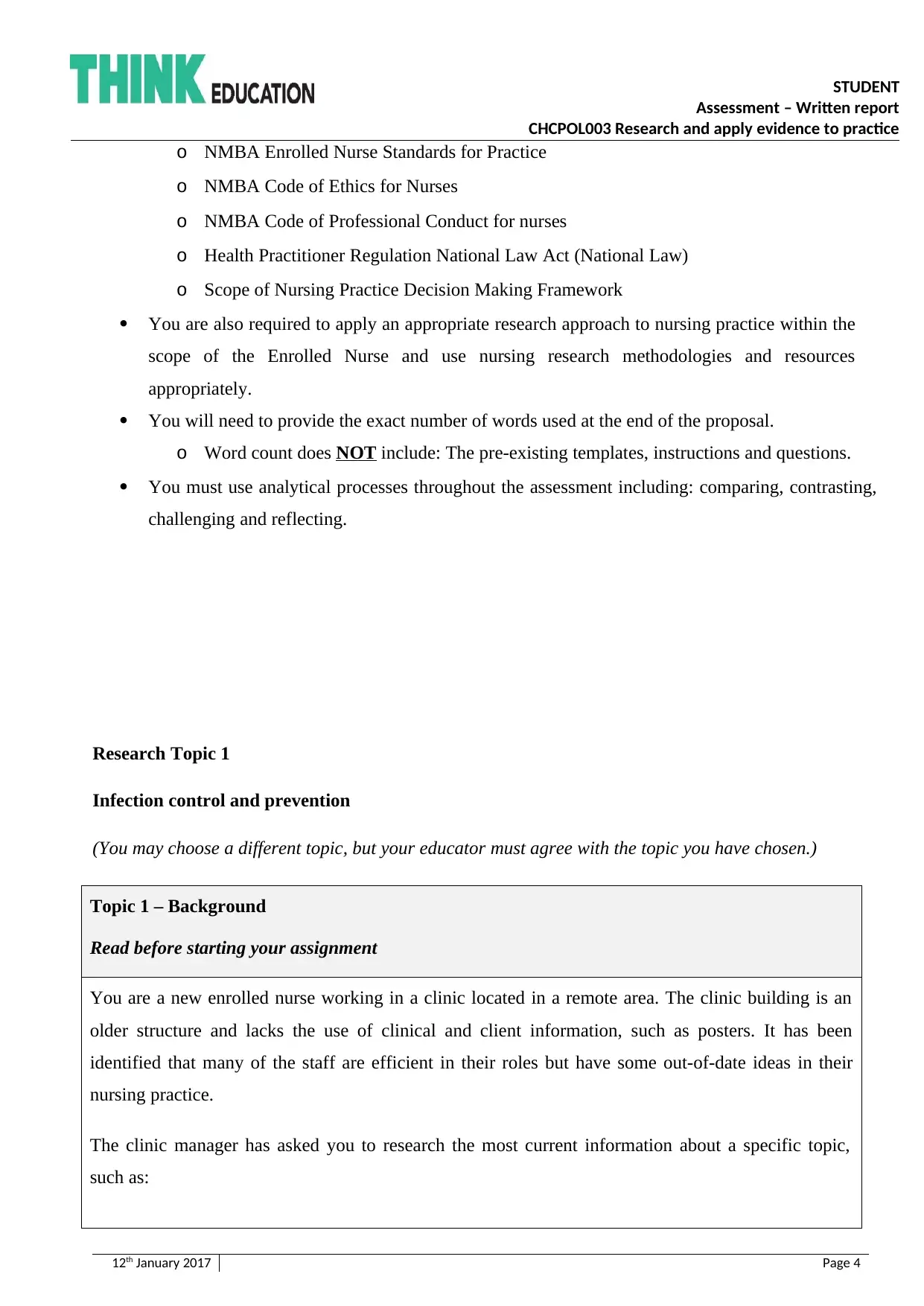
STUDENT
Assessment – Written report
CHCPOL003 Research and apply evidence to practice
o NMBA Enrolled Nurse Standards for Practice
o NMBA Code of Ethics for Nurses
o NMBA Code of Professional Conduct for nurses
o Health Practitioner Regulation National Law Act (National Law)
o Scope of Nursing Practice Decision Making Framework
You are also required to apply an appropriate research approach to nursing practice within the
scope of the Enrolled Nurse and use nursing research methodologies and resources
appropriately.
You will need to provide the exact number of words used at the end of the proposal.
o Word count does NOT include: The pre-existing templates, instructions and questions.
You must use analytical processes throughout the assessment including: comparing, contrasting,
challenging and reflecting.
Research Topic 1
Infection control and prevention
(You may choose a different topic, but your educator must agree with the topic you have chosen.)
Topic 1 – Background
Read before starting your assignment
You are a new enrolled nurse working in a clinic located in a remote area. The clinic building is an
older structure and lacks the use of clinical and client information, such as posters. It has been
identified that many of the staff are efficient in their roles but have some out-of-date ideas in their
nursing practice.
The clinic manager has asked you to research the most current information about a specific topic,
such as:
12th January 2017 Page 4
Assessment – Written report
CHCPOL003 Research and apply evidence to practice
o NMBA Enrolled Nurse Standards for Practice
o NMBA Code of Ethics for Nurses
o NMBA Code of Professional Conduct for nurses
o Health Practitioner Regulation National Law Act (National Law)
o Scope of Nursing Practice Decision Making Framework
You are also required to apply an appropriate research approach to nursing practice within the
scope of the Enrolled Nurse and use nursing research methodologies and resources
appropriately.
You will need to provide the exact number of words used at the end of the proposal.
o Word count does NOT include: The pre-existing templates, instructions and questions.
You must use analytical processes throughout the assessment including: comparing, contrasting,
challenging and reflecting.
Research Topic 1
Infection control and prevention
(You may choose a different topic, but your educator must agree with the topic you have chosen.)
Topic 1 – Background
Read before starting your assignment
You are a new enrolled nurse working in a clinic located in a remote area. The clinic building is an
older structure and lacks the use of clinical and client information, such as posters. It has been
identified that many of the staff are efficient in their roles but have some out-of-date ideas in their
nursing practice.
The clinic manager has asked you to research the most current information about a specific topic,
such as:
12th January 2017 Page 4
Secure Best Marks with AI Grader
Need help grading? Try our AI Grader for instant feedback on your assignments.
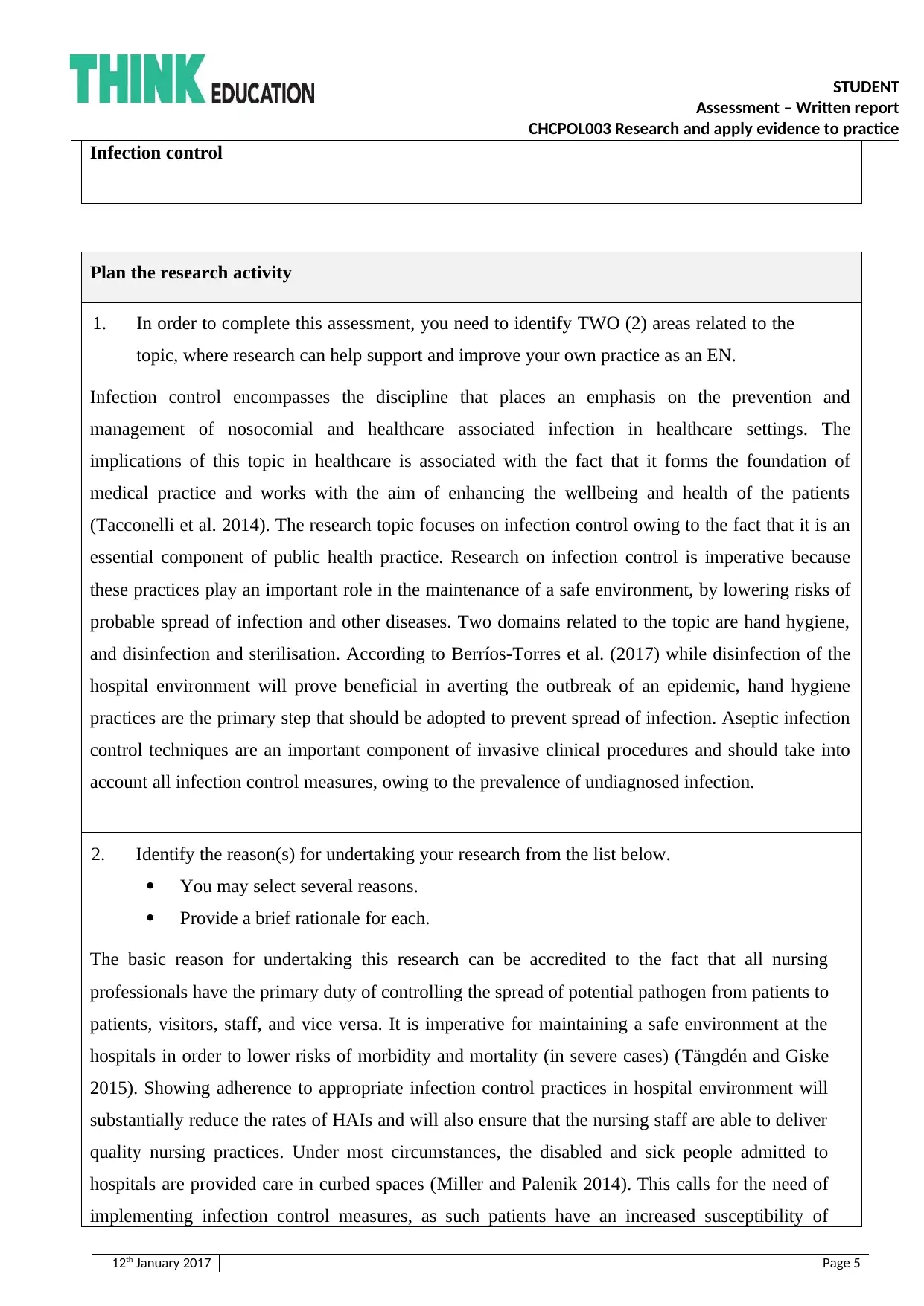
STUDENT
Assessment – Written report
CHCPOL003 Research and apply evidence to practice
Infection control
Plan the research activity
1. In order to complete this assessment, you need to identify TWO (2) areas related to the
topic, where research can help support and improve your own practice as an EN.
Infection control encompasses the discipline that places an emphasis on the prevention and
management of nosocomial and healthcare associated infection in healthcare settings. The
implications of this topic in healthcare is associated with the fact that it forms the foundation of
medical practice and works with the aim of enhancing the wellbeing and health of the patients
(Tacconelli et al. 2014). The research topic focuses on infection control owing to the fact that it is an
essential component of public health practice. Research on infection control is imperative because
these practices play an important role in the maintenance of a safe environment, by lowering risks of
probable spread of infection and other diseases. Two domains related to the topic are hand hygiene,
and disinfection and sterilisation. According to Berríos-Torres et al. (2017) while disinfection of the
hospital environment will prove beneficial in averting the outbreak of an epidemic, hand hygiene
practices are the primary step that should be adopted to prevent spread of infection. Aseptic infection
control techniques are an important component of invasive clinical procedures and should take into
account all infection control measures, owing to the prevalence of undiagnosed infection.
2. Identify the reason(s) for undertaking your research from the list below.
You may select several reasons.
Provide a brief rationale for each.
The basic reason for undertaking this research can be accredited to the fact that all nursing
professionals have the primary duty of controlling the spread of potential pathogen from patients to
patients, visitors, staff, and vice versa. It is imperative for maintaining a safe environment at the
hospitals in order to lower risks of morbidity and mortality (in severe cases) (Tängdén and Giske
2015). Showing adherence to appropriate infection control practices in hospital environment will
substantially reduce the rates of HAIs and will also ensure that the nursing staff are able to deliver
quality nursing practices. Under most circumstances, the disabled and sick people admitted to
hospitals are provided care in curbed spaces (Miller and Palenik 2014). This calls for the need of
implementing infection control measures, as such patients have an increased susceptibility of
12th January 2017 Page 5
Assessment – Written report
CHCPOL003 Research and apply evidence to practice
Infection control
Plan the research activity
1. In order to complete this assessment, you need to identify TWO (2) areas related to the
topic, where research can help support and improve your own practice as an EN.
Infection control encompasses the discipline that places an emphasis on the prevention and
management of nosocomial and healthcare associated infection in healthcare settings. The
implications of this topic in healthcare is associated with the fact that it forms the foundation of
medical practice and works with the aim of enhancing the wellbeing and health of the patients
(Tacconelli et al. 2014). The research topic focuses on infection control owing to the fact that it is an
essential component of public health practice. Research on infection control is imperative because
these practices play an important role in the maintenance of a safe environment, by lowering risks of
probable spread of infection and other diseases. Two domains related to the topic are hand hygiene,
and disinfection and sterilisation. According to Berríos-Torres et al. (2017) while disinfection of the
hospital environment will prove beneficial in averting the outbreak of an epidemic, hand hygiene
practices are the primary step that should be adopted to prevent spread of infection. Aseptic infection
control techniques are an important component of invasive clinical procedures and should take into
account all infection control measures, owing to the prevalence of undiagnosed infection.
2. Identify the reason(s) for undertaking your research from the list below.
You may select several reasons.
Provide a brief rationale for each.
The basic reason for undertaking this research can be accredited to the fact that all nursing
professionals have the primary duty of controlling the spread of potential pathogen from patients to
patients, visitors, staff, and vice versa. It is imperative for maintaining a safe environment at the
hospitals in order to lower risks of morbidity and mortality (in severe cases) (Tängdén and Giske
2015). Showing adherence to appropriate infection control practices in hospital environment will
substantially reduce the rates of HAIs and will also ensure that the nursing staff are able to deliver
quality nursing practices. Under most circumstances, the disabled and sick people admitted to
hospitals are provided care in curbed spaces (Miller and Palenik 2014). This calls for the need of
implementing infection control measures, as such patients have an increased susceptibility of
12th January 2017 Page 5
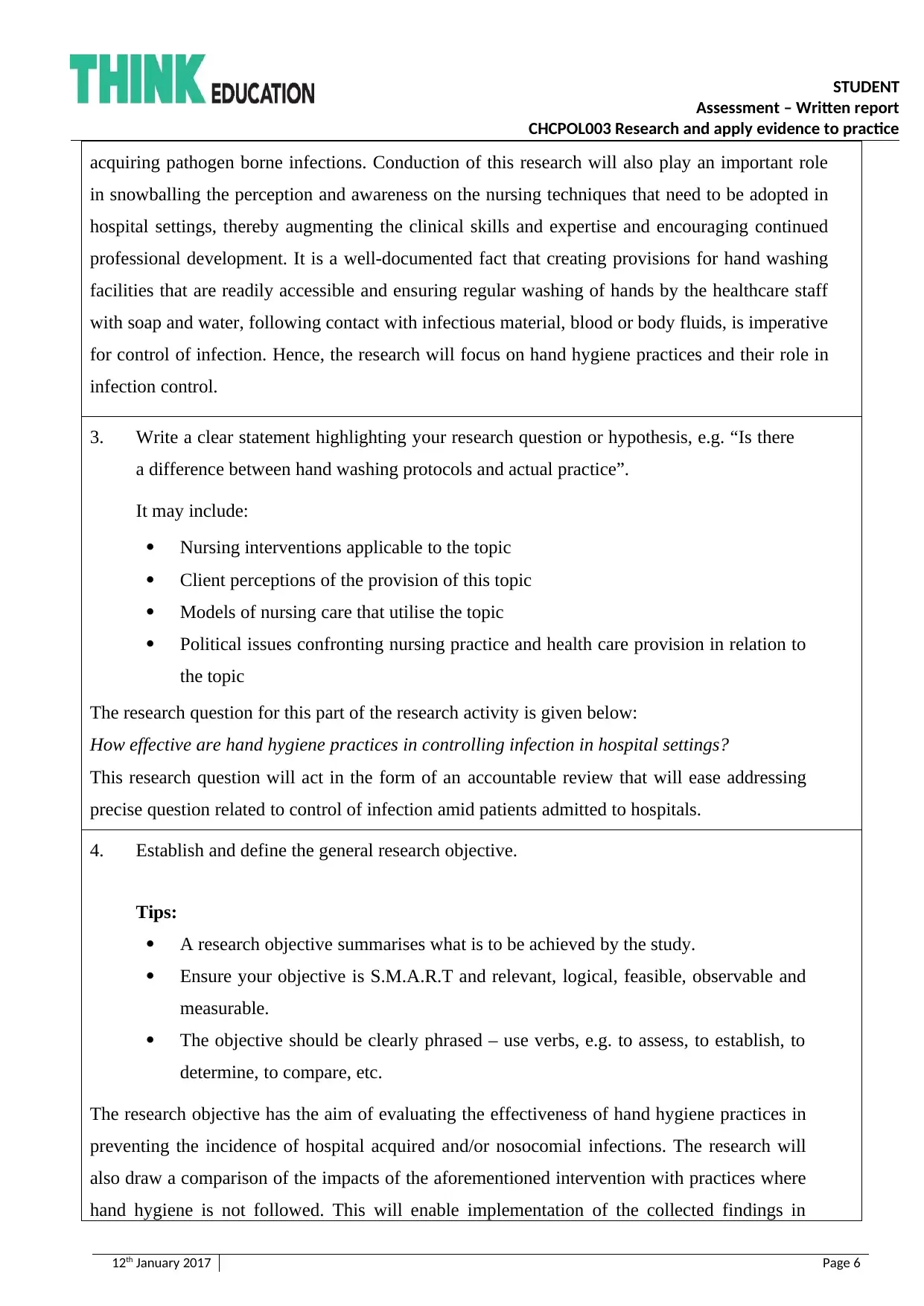
STUDENT
Assessment – Written report
CHCPOL003 Research and apply evidence to practice
acquiring pathogen borne infections. Conduction of this research will also play an important role
in snowballing the perception and awareness on the nursing techniques that need to be adopted in
hospital settings, thereby augmenting the clinical skills and expertise and encouraging continued
professional development. It is a well-documented fact that creating provisions for hand washing
facilities that are readily accessible and ensuring regular washing of hands by the healthcare staff
with soap and water, following contact with infectious material, blood or body fluids, is imperative
for control of infection. Hence, the research will focus on hand hygiene practices and their role in
infection control.
3. Write a clear statement highlighting your research question or hypothesis, e.g. “Is there
a difference between hand washing protocols and actual practice”.
It may include:
Nursing interventions applicable to the topic
Client perceptions of the provision of this topic
Models of nursing care that utilise the topic
Political issues confronting nursing practice and health care provision in relation to
the topic
The research question for this part of the research activity is given below:
How effective are hand hygiene practices in controlling infection in hospital settings?
This research question will act in the form of an accountable review that will ease addressing
precise question related to control of infection amid patients admitted to hospitals.
4. Establish and define the general research objective.
Tips:
A research objective summarises what is to be achieved by the study.
Ensure your objective is S.M.A.R.T and relevant, logical, feasible, observable and
measurable.
The objective should be clearly phrased – use verbs, e.g. to assess, to establish, to
determine, to compare, etc.
The research objective has the aim of evaluating the effectiveness of hand hygiene practices in
preventing the incidence of hospital acquired and/or nosocomial infections. The research will
also draw a comparison of the impacts of the aforementioned intervention with practices where
hand hygiene is not followed. This will enable implementation of the collected findings in
12th January 2017 Page 6
Assessment – Written report
CHCPOL003 Research and apply evidence to practice
acquiring pathogen borne infections. Conduction of this research will also play an important role
in snowballing the perception and awareness on the nursing techniques that need to be adopted in
hospital settings, thereby augmenting the clinical skills and expertise and encouraging continued
professional development. It is a well-documented fact that creating provisions for hand washing
facilities that are readily accessible and ensuring regular washing of hands by the healthcare staff
with soap and water, following contact with infectious material, blood or body fluids, is imperative
for control of infection. Hence, the research will focus on hand hygiene practices and their role in
infection control.
3. Write a clear statement highlighting your research question or hypothesis, e.g. “Is there
a difference between hand washing protocols and actual practice”.
It may include:
Nursing interventions applicable to the topic
Client perceptions of the provision of this topic
Models of nursing care that utilise the topic
Political issues confronting nursing practice and health care provision in relation to
the topic
The research question for this part of the research activity is given below:
How effective are hand hygiene practices in controlling infection in hospital settings?
This research question will act in the form of an accountable review that will ease addressing
precise question related to control of infection amid patients admitted to hospitals.
4. Establish and define the general research objective.
Tips:
A research objective summarises what is to be achieved by the study.
Ensure your objective is S.M.A.R.T and relevant, logical, feasible, observable and
measurable.
The objective should be clearly phrased – use verbs, e.g. to assess, to establish, to
determine, to compare, etc.
The research objective has the aim of evaluating the effectiveness of hand hygiene practices in
preventing the incidence of hospital acquired and/or nosocomial infections. The research will
also draw a comparison of the impacts of the aforementioned intervention with practices where
hand hygiene is not followed. This will enable implementation of the collected findings in
12th January 2017 Page 6
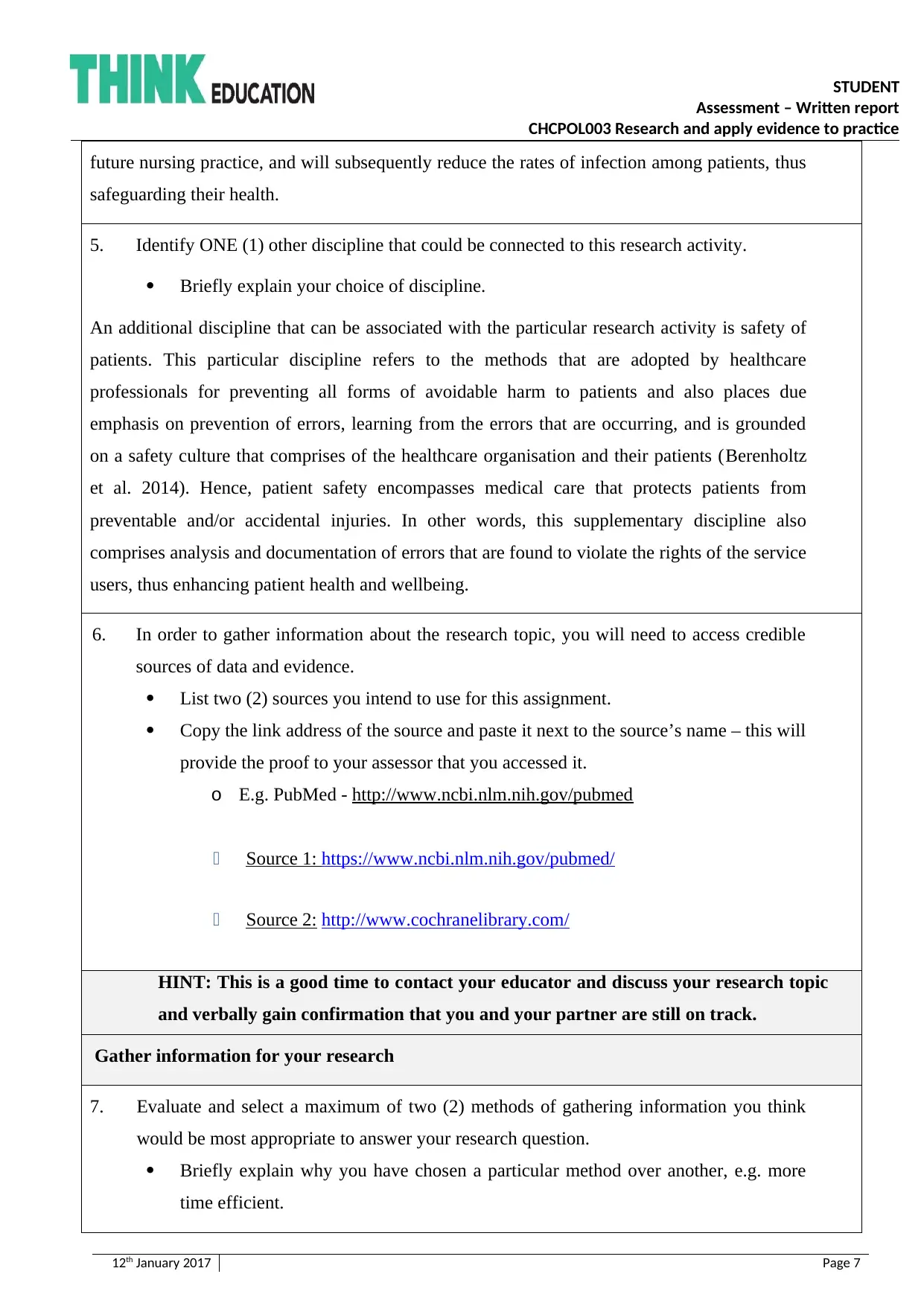
STUDENT
Assessment – Written report
CHCPOL003 Research and apply evidence to practice
future nursing practice, and will subsequently reduce the rates of infection among patients, thus
safeguarding their health.
5. Identify ONE (1) other discipline that could be connected to this research activity.
Briefly explain your choice of discipline.
An additional discipline that can be associated with the particular research activity is safety of
patients. This particular discipline refers to the methods that are adopted by healthcare
professionals for preventing all forms of avoidable harm to patients and also places due
emphasis on prevention of errors, learning from the errors that are occurring, and is grounded
on a safety culture that comprises of the healthcare organisation and their patients (Berenholtz
et al. 2014). Hence, patient safety encompasses medical care that protects patients from
preventable and/or accidental injuries. In other words, this supplementary discipline also
comprises analysis and documentation of errors that are found to violate the rights of the service
users, thus enhancing patient health and wellbeing.
6. In order to gather information about the research topic, you will need to access credible
sources of data and evidence.
List two (2) sources you intend to use for this assignment.
Copy the link address of the source and paste it next to the source’s name – this will
provide the proof to your assessor that you accessed it.
o E.g. PubMed - http://www.ncbi.nlm.nih.gov/pubmed
Source 1: https://www.ncbi.nlm.nih.gov/pubmed/
Source 2: http://www.cochranelibrary.com/
HINT: This is a good time to contact your educator and discuss your research topic
and verbally gain confirmation that you and your partner are still on track.
Gather information for your research
7. Evaluate and select a maximum of two (2) methods of gathering information you think
would be most appropriate to answer your research question.
Briefly explain why you have chosen a particular method over another, e.g. more
time efficient.
12th January 2017 Page 7
Assessment – Written report
CHCPOL003 Research and apply evidence to practice
future nursing practice, and will subsequently reduce the rates of infection among patients, thus
safeguarding their health.
5. Identify ONE (1) other discipline that could be connected to this research activity.
Briefly explain your choice of discipline.
An additional discipline that can be associated with the particular research activity is safety of
patients. This particular discipline refers to the methods that are adopted by healthcare
professionals for preventing all forms of avoidable harm to patients and also places due
emphasis on prevention of errors, learning from the errors that are occurring, and is grounded
on a safety culture that comprises of the healthcare organisation and their patients (Berenholtz
et al. 2014). Hence, patient safety encompasses medical care that protects patients from
preventable and/or accidental injuries. In other words, this supplementary discipline also
comprises analysis and documentation of errors that are found to violate the rights of the service
users, thus enhancing patient health and wellbeing.
6. In order to gather information about the research topic, you will need to access credible
sources of data and evidence.
List two (2) sources you intend to use for this assignment.
Copy the link address of the source and paste it next to the source’s name – this will
provide the proof to your assessor that you accessed it.
o E.g. PubMed - http://www.ncbi.nlm.nih.gov/pubmed
Source 1: https://www.ncbi.nlm.nih.gov/pubmed/
Source 2: http://www.cochranelibrary.com/
HINT: This is a good time to contact your educator and discuss your research topic
and verbally gain confirmation that you and your partner are still on track.
Gather information for your research
7. Evaluate and select a maximum of two (2) methods of gathering information you think
would be most appropriate to answer your research question.
Briefly explain why you have chosen a particular method over another, e.g. more
time efficient.
12th January 2017 Page 7
Paraphrase This Document
Need a fresh take? Get an instant paraphrase of this document with our AI Paraphraser
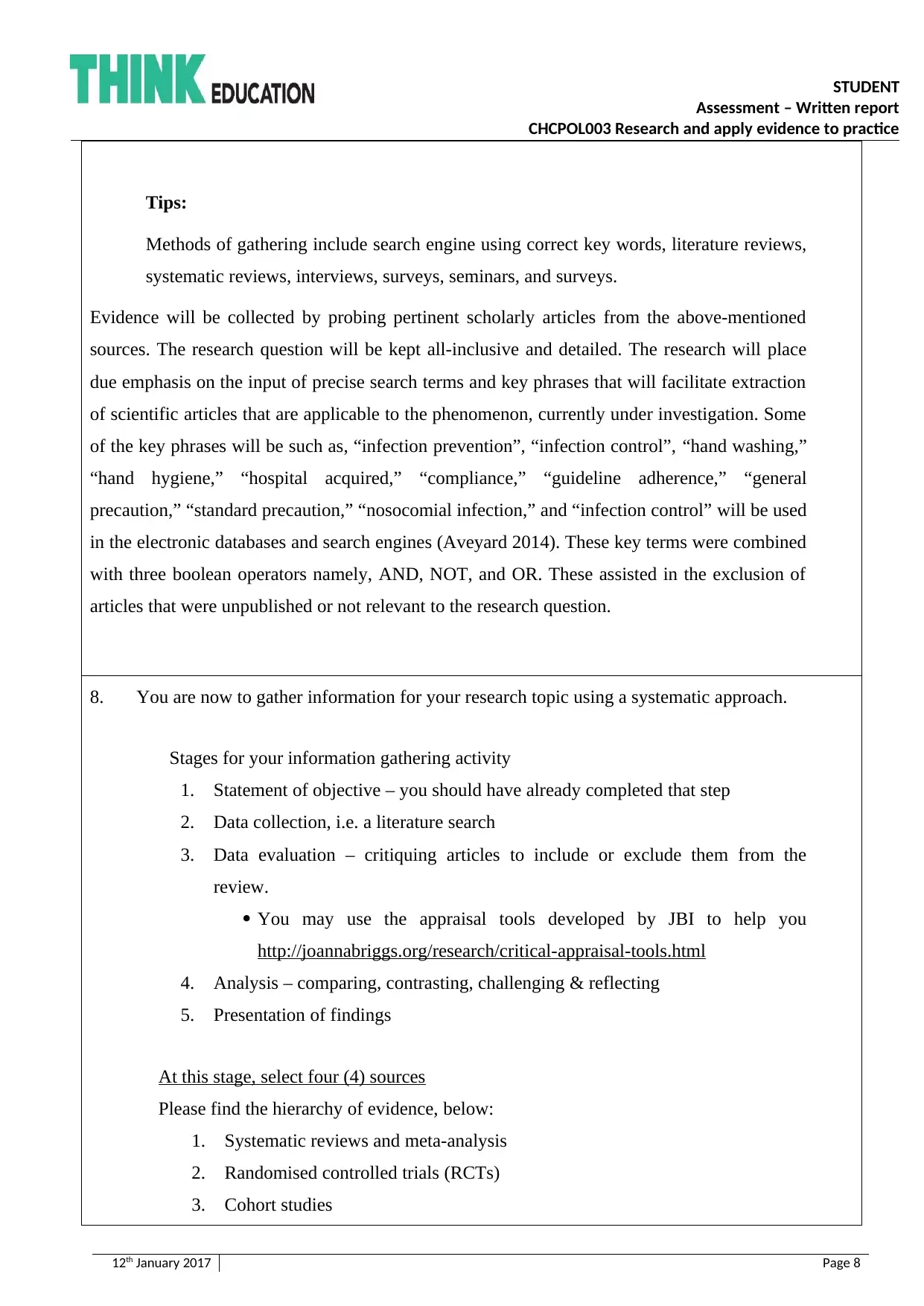
STUDENT
Assessment – Written report
CHCPOL003 Research and apply evidence to practice
Tips:
Methods of gathering include search engine using correct key words, literature reviews,
systematic reviews, interviews, surveys, seminars, and surveys.
Evidence will be collected by probing pertinent scholarly articles from the above-mentioned
sources. The research question will be kept all-inclusive and detailed. The research will place
due emphasis on the input of precise search terms and key phrases that will facilitate extraction
of scientific articles that are applicable to the phenomenon, currently under investigation. Some
of the key phrases will be such as, “infection prevention”, “infection control”, “hand washing,”
“hand hygiene,” “hospital acquired,” “compliance,” “guideline adherence,” “general
precaution,” “standard precaution,” “nosocomial infection,” and “infection control” will be used
in the electronic databases and search engines (Aveyard 2014). These key terms were combined
with three boolean operators namely, AND, NOT, and OR. These assisted in the exclusion of
articles that were unpublished or not relevant to the research question.
8. You are now to gather information for your research topic using a systematic approach.
Stages for your information gathering activity
1. Statement of objective – you should have already completed that step
2. Data collection, i.e. a literature search
3. Data evaluation – critiquing articles to include or exclude them from the
review.
You may use the appraisal tools developed by JBI to help you
http://joannabriggs.org/research/critical-appraisal-tools.html
4. Analysis – comparing, contrasting, challenging & reflecting
5. Presentation of findings
At this stage, select four (4) sources
Please find the hierarchy of evidence, below:
1. Systematic reviews and meta-analysis
2. Randomised controlled trials (RCTs)
3. Cohort studies
12th January 2017 Page 8
Assessment – Written report
CHCPOL003 Research and apply evidence to practice
Tips:
Methods of gathering include search engine using correct key words, literature reviews,
systematic reviews, interviews, surveys, seminars, and surveys.
Evidence will be collected by probing pertinent scholarly articles from the above-mentioned
sources. The research question will be kept all-inclusive and detailed. The research will place
due emphasis on the input of precise search terms and key phrases that will facilitate extraction
of scientific articles that are applicable to the phenomenon, currently under investigation. Some
of the key phrases will be such as, “infection prevention”, “infection control”, “hand washing,”
“hand hygiene,” “hospital acquired,” “compliance,” “guideline adherence,” “general
precaution,” “standard precaution,” “nosocomial infection,” and “infection control” will be used
in the electronic databases and search engines (Aveyard 2014). These key terms were combined
with three boolean operators namely, AND, NOT, and OR. These assisted in the exclusion of
articles that were unpublished or not relevant to the research question.
8. You are now to gather information for your research topic using a systematic approach.
Stages for your information gathering activity
1. Statement of objective – you should have already completed that step
2. Data collection, i.e. a literature search
3. Data evaluation – critiquing articles to include or exclude them from the
review.
You may use the appraisal tools developed by JBI to help you
http://joannabriggs.org/research/critical-appraisal-tools.html
4. Analysis – comparing, contrasting, challenging & reflecting
5. Presentation of findings
At this stage, select four (4) sources
Please find the hierarchy of evidence, below:
1. Systematic reviews and meta-analysis
2. Randomised controlled trials (RCTs)
3. Cohort studies
12th January 2017 Page 8
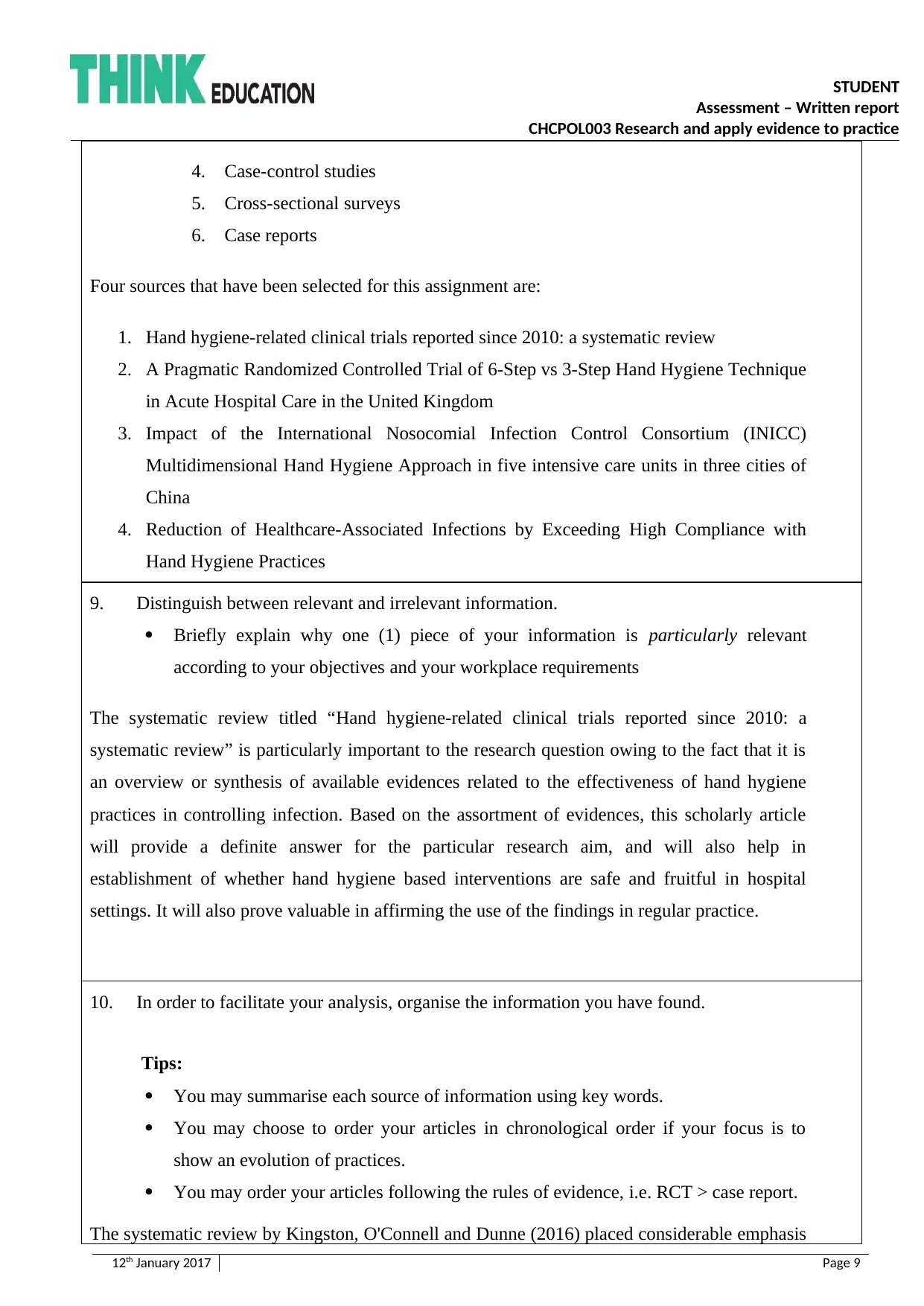
STUDENT
Assessment – Written report
CHCPOL003 Research and apply evidence to practice
4. Case-control studies
5. Cross-sectional surveys
6. Case reports
Four sources that have been selected for this assignment are:
1. Hand hygiene-related clinical trials reported since 2010: a systematic review
2. A Pragmatic Randomized Controlled Trial of 6-Step vs 3-Step Hand Hygiene Technique
in Acute Hospital Care in the United Kingdom
3. Impact of the International Nosocomial Infection Control Consortium (INICC)
Multidimensional Hand Hygiene Approach in five intensive care units in three cities of
China
4. Reduction of Healthcare-Associated Infections by Exceeding High Compliance with
Hand Hygiene Practices
9. Distinguish between relevant and irrelevant information.
Briefly explain why one (1) piece of your information is particularly relevant
according to your objectives and your workplace requirements
The systematic review titled “Hand hygiene-related clinical trials reported since 2010: a
systematic review” is particularly important to the research question owing to the fact that it is
an overview or synthesis of available evidences related to the effectiveness of hand hygiene
practices in controlling infection. Based on the assortment of evidences, this scholarly article
will provide a definite answer for the particular research aim, and will also help in
establishment of whether hand hygiene based interventions are safe and fruitful in hospital
settings. It will also prove valuable in affirming the use of the findings in regular practice.
10. In order to facilitate your analysis, organise the information you have found.
Tips:
You may summarise each source of information using key words.
You may choose to order your articles in chronological order if your focus is to
show an evolution of practices.
You may order your articles following the rules of evidence, i.e. RCT > case report.
The systematic review by Kingston, O'Connell and Dunne (2016) placed considerable emphasis
12th January 2017 Page 9
Assessment – Written report
CHCPOL003 Research and apply evidence to practice
4. Case-control studies
5. Cross-sectional surveys
6. Case reports
Four sources that have been selected for this assignment are:
1. Hand hygiene-related clinical trials reported since 2010: a systematic review
2. A Pragmatic Randomized Controlled Trial of 6-Step vs 3-Step Hand Hygiene Technique
in Acute Hospital Care in the United Kingdom
3. Impact of the International Nosocomial Infection Control Consortium (INICC)
Multidimensional Hand Hygiene Approach in five intensive care units in three cities of
China
4. Reduction of Healthcare-Associated Infections by Exceeding High Compliance with
Hand Hygiene Practices
9. Distinguish between relevant and irrelevant information.
Briefly explain why one (1) piece of your information is particularly relevant
according to your objectives and your workplace requirements
The systematic review titled “Hand hygiene-related clinical trials reported since 2010: a
systematic review” is particularly important to the research question owing to the fact that it is
an overview or synthesis of available evidences related to the effectiveness of hand hygiene
practices in controlling infection. Based on the assortment of evidences, this scholarly article
will provide a definite answer for the particular research aim, and will also help in
establishment of whether hand hygiene based interventions are safe and fruitful in hospital
settings. It will also prove valuable in affirming the use of the findings in regular practice.
10. In order to facilitate your analysis, organise the information you have found.
Tips:
You may summarise each source of information using key words.
You may choose to order your articles in chronological order if your focus is to
show an evolution of practices.
You may order your articles following the rules of evidence, i.e. RCT > case report.
The systematic review by Kingston, O'Connell and Dunne (2016) placed considerable emphasis
12th January 2017 Page 9
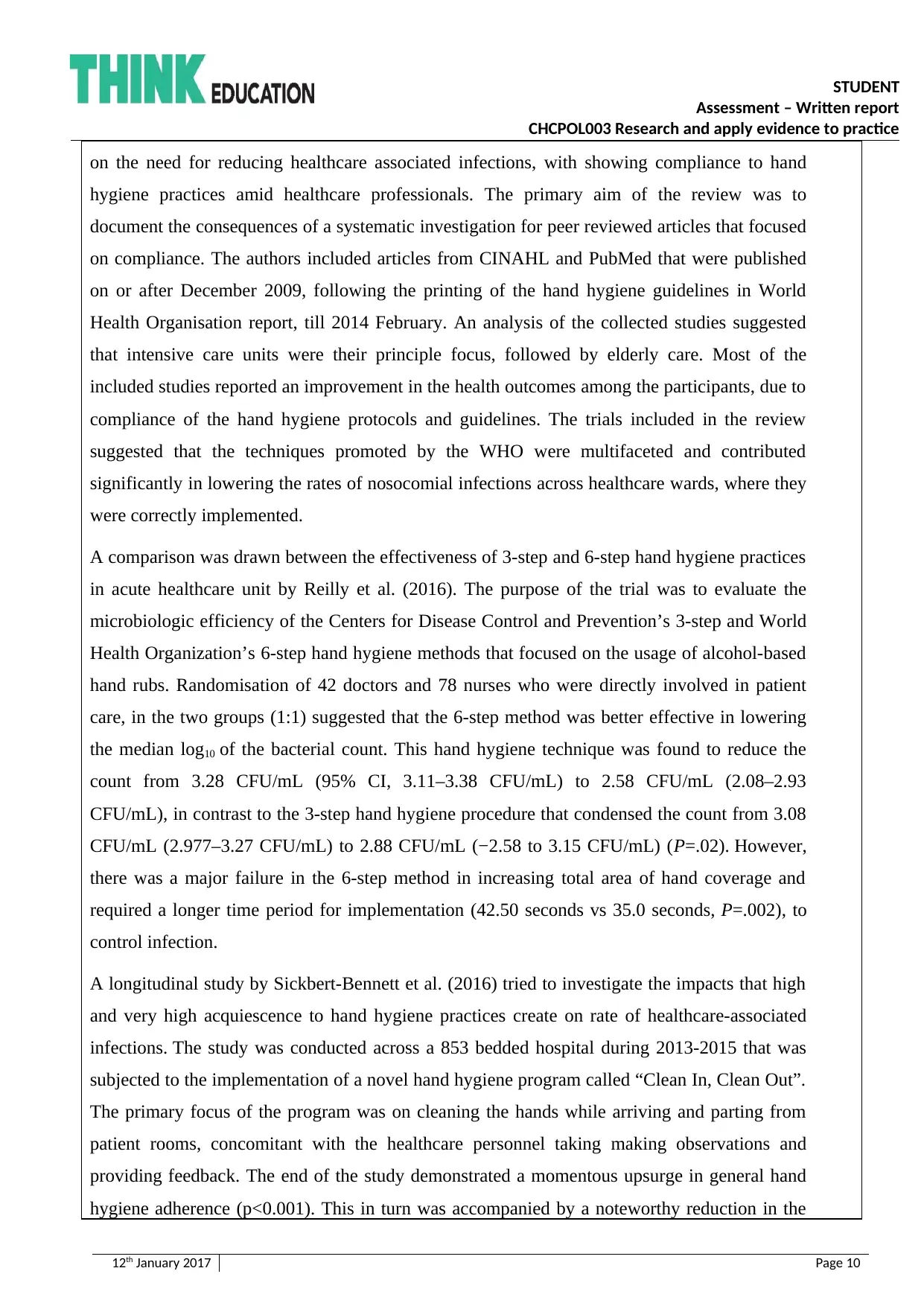
STUDENT
Assessment – Written report
CHCPOL003 Research and apply evidence to practice
on the need for reducing healthcare associated infections, with showing compliance to hand
hygiene practices amid healthcare professionals. The primary aim of the review was to
document the consequences of a systematic investigation for peer reviewed articles that focused
on compliance. The authors included articles from CINAHL and PubMed that were published
on or after December 2009, following the printing of the hand hygiene guidelines in World
Health Organisation report, till 2014 February. An analysis of the collected studies suggested
that intensive care units were their principle focus, followed by elderly care. Most of the
included studies reported an improvement in the health outcomes among the participants, due to
compliance of the hand hygiene protocols and guidelines. The trials included in the review
suggested that the techniques promoted by the WHO were multifaceted and contributed
significantly in lowering the rates of nosocomial infections across healthcare wards, where they
were correctly implemented.
A comparison was drawn between the effectiveness of 3-step and 6-step hand hygiene practices
in acute healthcare unit by Reilly et al. (2016). The purpose of the trial was to evaluate the
microbiologic efficiency of the Centers for Disease Control and Prevention’s 3-step and World
Health Organization’s 6-step hand hygiene methods that focused on the usage of alcohol-based
hand rubs. Randomisation of 42 doctors and 78 nurses who were directly involved in patient
care, in the two groups (1:1) suggested that the 6-step method was better effective in lowering
the median log10 of the bacterial count. This hand hygiene technique was found to reduce the
count from 3.28 CFU/mL (95% CI, 3.11–3.38 CFU/mL) to 2.58 CFU/mL (2.08–2.93
CFU/mL), in contrast to the 3-step hand hygiene procedure that condensed the count from 3.08
CFU/mL (2.977–3.27 CFU/mL) to 2.88 CFU/mL (−2.58 to 3.15 CFU/mL) (P=.02). However,
there was a major failure in the 6-step method in increasing total area of hand coverage and
required a longer time period for implementation (42.50 seconds vs 35.0 seconds, P=.002), to
control infection.
A longitudinal study by Sickbert-Bennett et al. (2016) tried to investigate the impacts that high
and very high acquiescence to hand hygiene practices create on rate of healthcare-associated
infections. The study was conducted across a 853 bedded hospital during 2013-2015 that was
subjected to the implementation of a novel hand hygiene program called “Clean In, Clean Out”.
The primary focus of the program was on cleaning the hands while arriving and parting from
patient rooms, concomitant with the healthcare personnel taking making observations and
providing feedback. The end of the study demonstrated a momentous upsurge in general hand
hygiene adherence (p<0.001). This in turn was accompanied by a noteworthy reduction in the
12th January 2017 Page 10
Assessment – Written report
CHCPOL003 Research and apply evidence to practice
on the need for reducing healthcare associated infections, with showing compliance to hand
hygiene practices amid healthcare professionals. The primary aim of the review was to
document the consequences of a systematic investigation for peer reviewed articles that focused
on compliance. The authors included articles from CINAHL and PubMed that were published
on or after December 2009, following the printing of the hand hygiene guidelines in World
Health Organisation report, till 2014 February. An analysis of the collected studies suggested
that intensive care units were their principle focus, followed by elderly care. Most of the
included studies reported an improvement in the health outcomes among the participants, due to
compliance of the hand hygiene protocols and guidelines. The trials included in the review
suggested that the techniques promoted by the WHO were multifaceted and contributed
significantly in lowering the rates of nosocomial infections across healthcare wards, where they
were correctly implemented.
A comparison was drawn between the effectiveness of 3-step and 6-step hand hygiene practices
in acute healthcare unit by Reilly et al. (2016). The purpose of the trial was to evaluate the
microbiologic efficiency of the Centers for Disease Control and Prevention’s 3-step and World
Health Organization’s 6-step hand hygiene methods that focused on the usage of alcohol-based
hand rubs. Randomisation of 42 doctors and 78 nurses who were directly involved in patient
care, in the two groups (1:1) suggested that the 6-step method was better effective in lowering
the median log10 of the bacterial count. This hand hygiene technique was found to reduce the
count from 3.28 CFU/mL (95% CI, 3.11–3.38 CFU/mL) to 2.58 CFU/mL (2.08–2.93
CFU/mL), in contrast to the 3-step hand hygiene procedure that condensed the count from 3.08
CFU/mL (2.977–3.27 CFU/mL) to 2.88 CFU/mL (−2.58 to 3.15 CFU/mL) (P=.02). However,
there was a major failure in the 6-step method in increasing total area of hand coverage and
required a longer time period for implementation (42.50 seconds vs 35.0 seconds, P=.002), to
control infection.
A longitudinal study by Sickbert-Bennett et al. (2016) tried to investigate the impacts that high
and very high acquiescence to hand hygiene practices create on rate of healthcare-associated
infections. The study was conducted across a 853 bedded hospital during 2013-2015 that was
subjected to the implementation of a novel hand hygiene program called “Clean In, Clean Out”.
The primary focus of the program was on cleaning the hands while arriving and parting from
patient rooms, concomitant with the healthcare personnel taking making observations and
providing feedback. The end of the study demonstrated a momentous upsurge in general hand
hygiene adherence (p<0.001). This in turn was accompanied by a noteworthy reduction in the
12th January 2017 Page 10
Secure Best Marks with AI Grader
Need help grading? Try our AI Grader for instant feedback on your assignments.
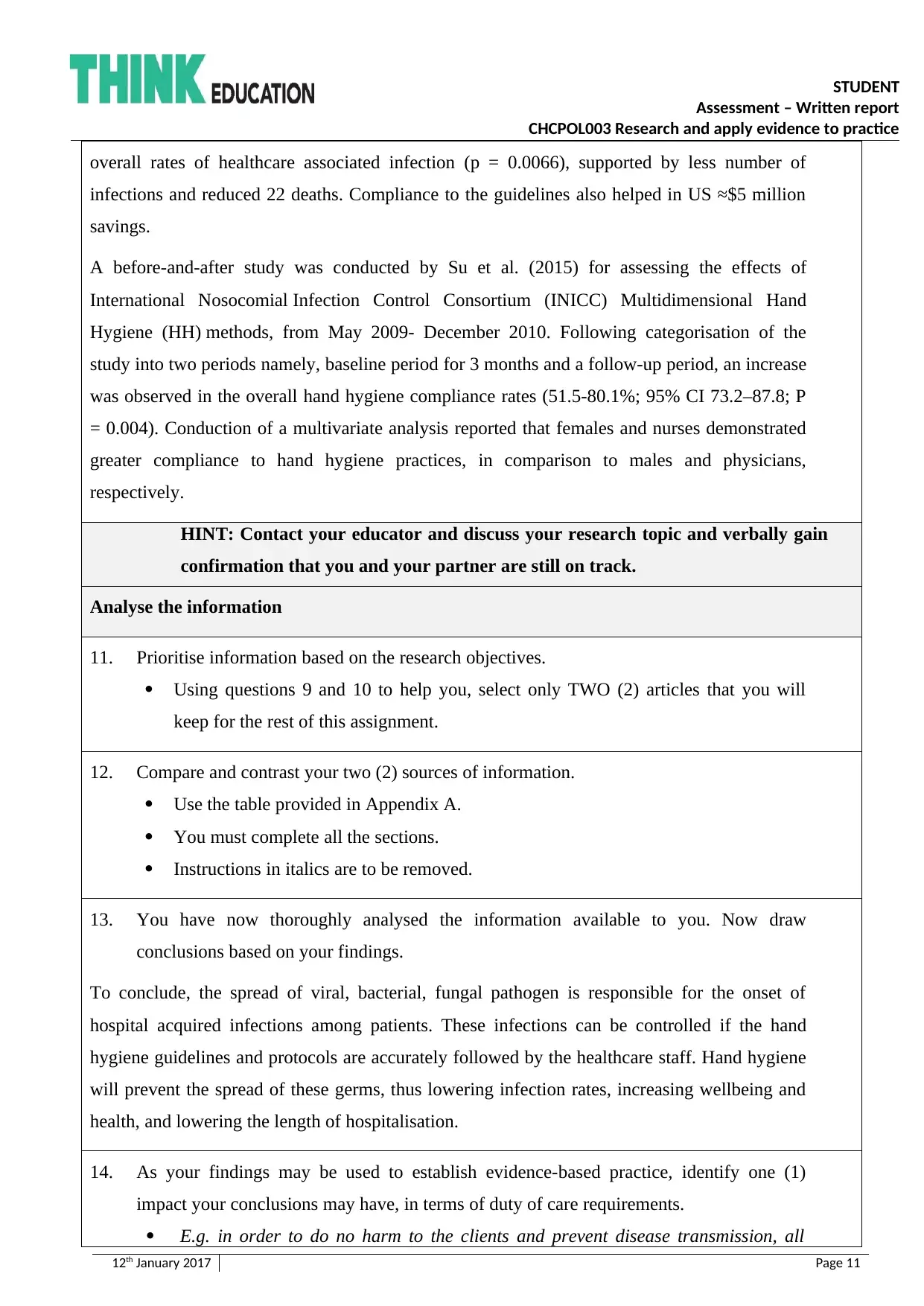
STUDENT
Assessment – Written report
CHCPOL003 Research and apply evidence to practice
overall rates of healthcare associated infection (p = 0.0066), supported by less number of
infections and reduced 22 deaths. Compliance to the guidelines also helped in US ≈$5 million
savings.
A before-and-after study was conducted by Su et al. (2015) for assessing the effects of
International Nosocomial Infection Control Consortium (INICC) Multidimensional Hand
Hygiene (HH) methods, from May 2009- December 2010. Following categorisation of the
study into two periods namely, baseline period for 3 months and a follow-up period, an increase
was observed in the overall hand hygiene compliance rates (51.5-80.1%; 95% CI 73.2–87.8; P
= 0.004). Conduction of a multivariate analysis reported that females and nurses demonstrated
greater compliance to hand hygiene practices, in comparison to males and physicians,
respectively.
HINT: Contact your educator and discuss your research topic and verbally gain
confirmation that you and your partner are still on track.
Analyse the information
11. Prioritise information based on the research objectives.
Using questions 9 and 10 to help you, select only TWO (2) articles that you will
keep for the rest of this assignment.
12. Compare and contrast your two (2) sources of information.
Use the table provided in Appendix A.
You must complete all the sections.
Instructions in italics are to be removed.
13. You have now thoroughly analysed the information available to you. Now draw
conclusions based on your findings.
To conclude, the spread of viral, bacterial, fungal pathogen is responsible for the onset of
hospital acquired infections among patients. These infections can be controlled if the hand
hygiene guidelines and protocols are accurately followed by the healthcare staff. Hand hygiene
will prevent the spread of these germs, thus lowering infection rates, increasing wellbeing and
health, and lowering the length of hospitalisation.
14. As your findings may be used to establish evidence-based practice, identify one (1)
impact your conclusions may have, in terms of duty of care requirements.
E.g. in order to do no harm to the clients and prevent disease transmission, all
12th January 2017 Page 11
Assessment – Written report
CHCPOL003 Research and apply evidence to practice
overall rates of healthcare associated infection (p = 0.0066), supported by less number of
infections and reduced 22 deaths. Compliance to the guidelines also helped in US ≈$5 million
savings.
A before-and-after study was conducted by Su et al. (2015) for assessing the effects of
International Nosocomial Infection Control Consortium (INICC) Multidimensional Hand
Hygiene (HH) methods, from May 2009- December 2010. Following categorisation of the
study into two periods namely, baseline period for 3 months and a follow-up period, an increase
was observed in the overall hand hygiene compliance rates (51.5-80.1%; 95% CI 73.2–87.8; P
= 0.004). Conduction of a multivariate analysis reported that females and nurses demonstrated
greater compliance to hand hygiene practices, in comparison to males and physicians,
respectively.
HINT: Contact your educator and discuss your research topic and verbally gain
confirmation that you and your partner are still on track.
Analyse the information
11. Prioritise information based on the research objectives.
Using questions 9 and 10 to help you, select only TWO (2) articles that you will
keep for the rest of this assignment.
12. Compare and contrast your two (2) sources of information.
Use the table provided in Appendix A.
You must complete all the sections.
Instructions in italics are to be removed.
13. You have now thoroughly analysed the information available to you. Now draw
conclusions based on your findings.
To conclude, the spread of viral, bacterial, fungal pathogen is responsible for the onset of
hospital acquired infections among patients. These infections can be controlled if the hand
hygiene guidelines and protocols are accurately followed by the healthcare staff. Hand hygiene
will prevent the spread of these germs, thus lowering infection rates, increasing wellbeing and
health, and lowering the length of hospitalisation.
14. As your findings may be used to establish evidence-based practice, identify one (1)
impact your conclusions may have, in terms of duty of care requirements.
E.g. in order to do no harm to the clients and prevent disease transmission, all
12th January 2017 Page 11
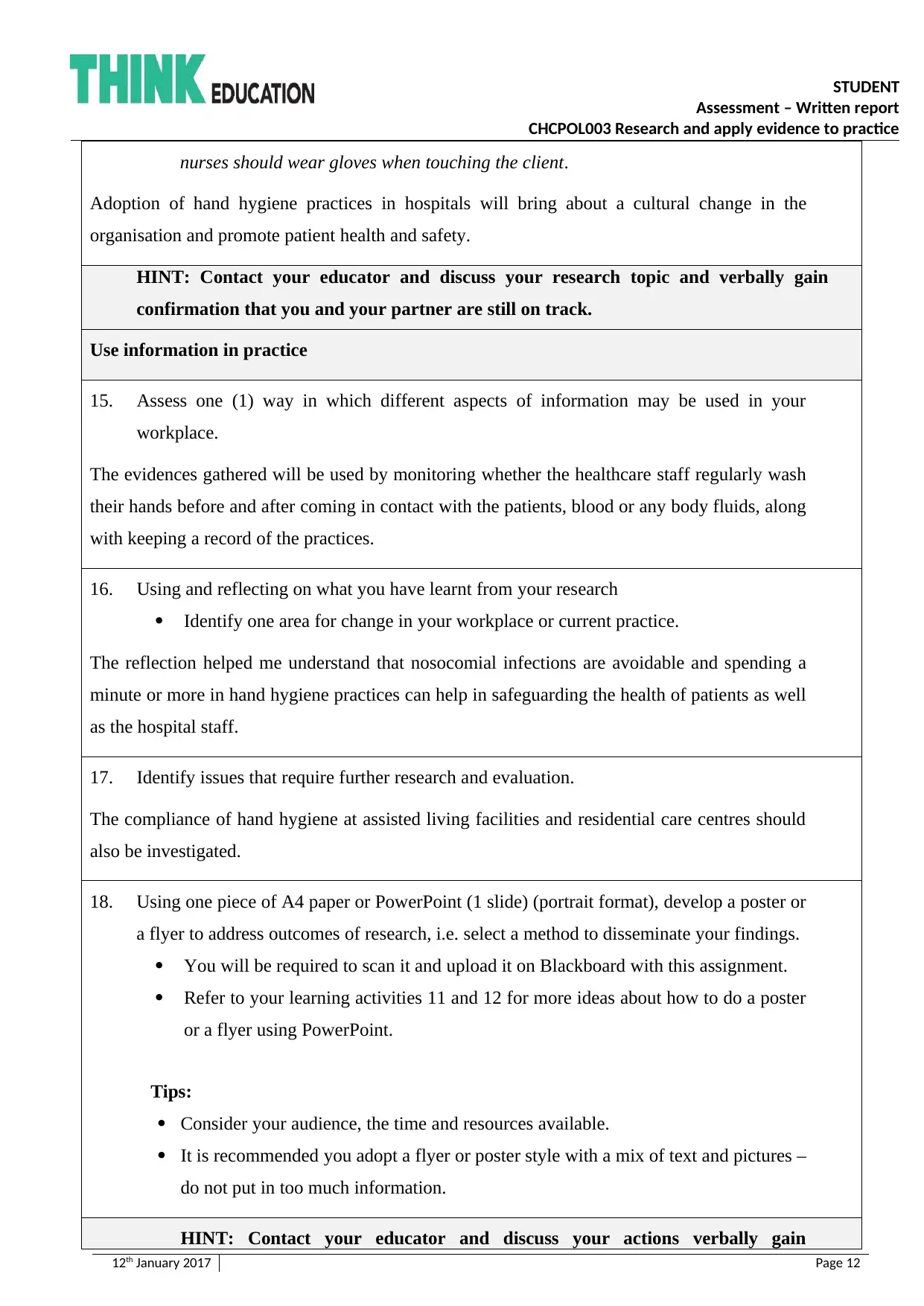
STUDENT
Assessment – Written report
CHCPOL003 Research and apply evidence to practice
nurses should wear gloves when touching the client.
Adoption of hand hygiene practices in hospitals will bring about a cultural change in the
organisation and promote patient health and safety.
HINT: Contact your educator and discuss your research topic and verbally gain
confirmation that you and your partner are still on track.
Use information in practice
15. Assess one (1) way in which different aspects of information may be used in your
workplace.
The evidences gathered will be used by monitoring whether the healthcare staff regularly wash
their hands before and after coming in contact with the patients, blood or any body fluids, along
with keeping a record of the practices.
16. Using and reflecting on what you have learnt from your research
Identify one area for change in your workplace or current practice.
The reflection helped me understand that nosocomial infections are avoidable and spending a
minute or more in hand hygiene practices can help in safeguarding the health of patients as well
as the hospital staff.
17. Identify issues that require further research and evaluation.
The compliance of hand hygiene at assisted living facilities and residential care centres should
also be investigated.
18. Using one piece of A4 paper or PowerPoint (1 slide) (portrait format), develop a poster or
a flyer to address outcomes of research, i.e. select a method to disseminate your findings.
You will be required to scan it and upload it on Blackboard with this assignment.
Refer to your learning activities 11 and 12 for more ideas about how to do a poster
or a flyer using PowerPoint.
Tips:
Consider your audience, the time and resources available.
It is recommended you adopt a flyer or poster style with a mix of text and pictures –
do not put in too much information.
HINT: Contact your educator and discuss your actions verbally gain
12th January 2017 Page 12
Assessment – Written report
CHCPOL003 Research and apply evidence to practice
nurses should wear gloves when touching the client.
Adoption of hand hygiene practices in hospitals will bring about a cultural change in the
organisation and promote patient health and safety.
HINT: Contact your educator and discuss your research topic and verbally gain
confirmation that you and your partner are still on track.
Use information in practice
15. Assess one (1) way in which different aspects of information may be used in your
workplace.
The evidences gathered will be used by monitoring whether the healthcare staff regularly wash
their hands before and after coming in contact with the patients, blood or any body fluids, along
with keeping a record of the practices.
16. Using and reflecting on what you have learnt from your research
Identify one area for change in your workplace or current practice.
The reflection helped me understand that nosocomial infections are avoidable and spending a
minute or more in hand hygiene practices can help in safeguarding the health of patients as well
as the hospital staff.
17. Identify issues that require further research and evaluation.
The compliance of hand hygiene at assisted living facilities and residential care centres should
also be investigated.
18. Using one piece of A4 paper or PowerPoint (1 slide) (portrait format), develop a poster or
a flyer to address outcomes of research, i.e. select a method to disseminate your findings.
You will be required to scan it and upload it on Blackboard with this assignment.
Refer to your learning activities 11 and 12 for more ideas about how to do a poster
or a flyer using PowerPoint.
Tips:
Consider your audience, the time and resources available.
It is recommended you adopt a flyer or poster style with a mix of text and pictures –
do not put in too much information.
HINT: Contact your educator and discuss your actions verbally gain
12th January 2017 Page 12
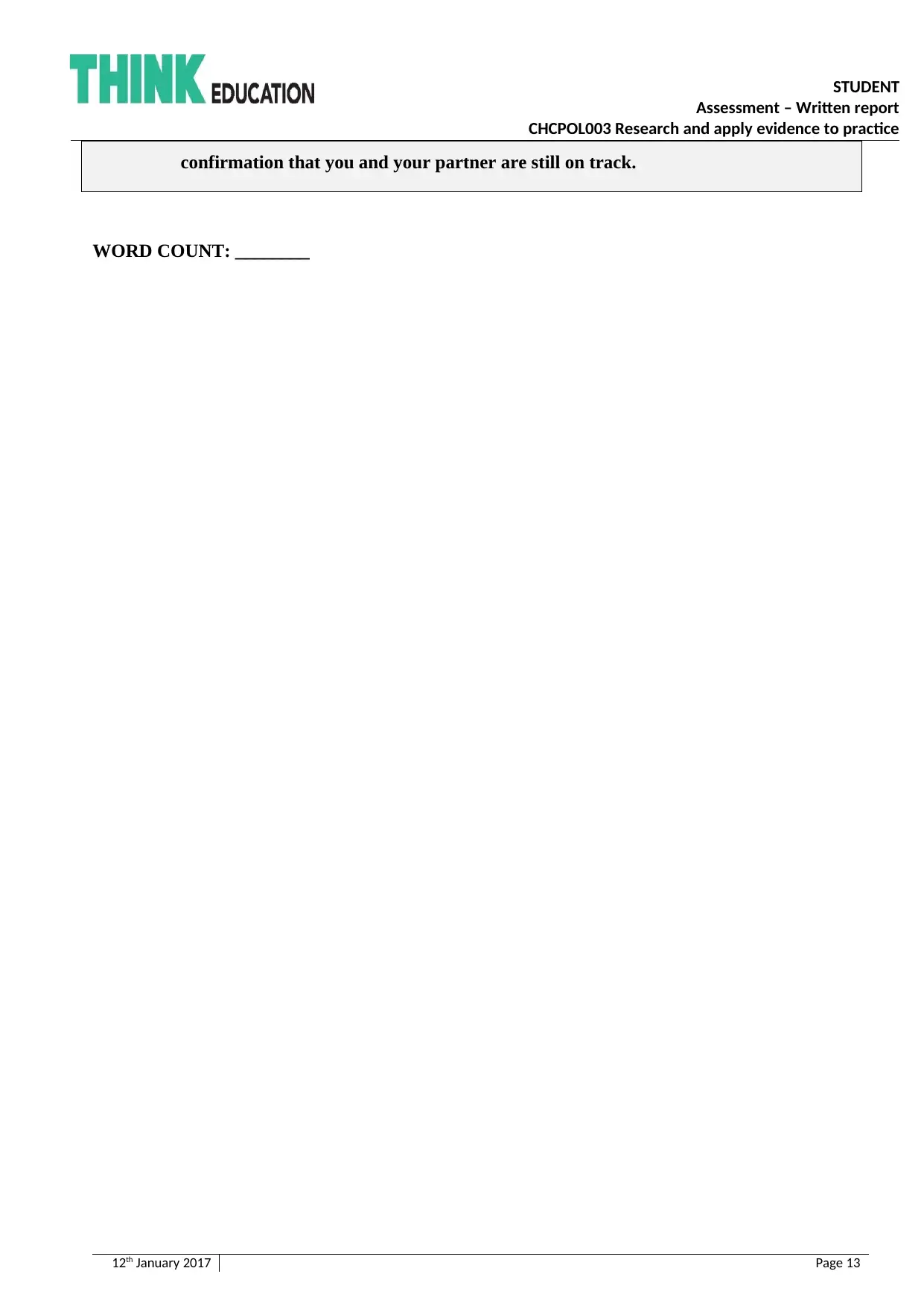
STUDENT
Assessment – Written report
CHCPOL003 Research and apply evidence to practice
confirmation that you and your partner are still on track.
WORD COUNT: ________
12th January 2017 Page 13
Assessment – Written report
CHCPOL003 Research and apply evidence to practice
confirmation that you and your partner are still on track.
WORD COUNT: ________
12th January 2017 Page 13
Paraphrase This Document
Need a fresh take? Get an instant paraphrase of this document with our AI Paraphraser
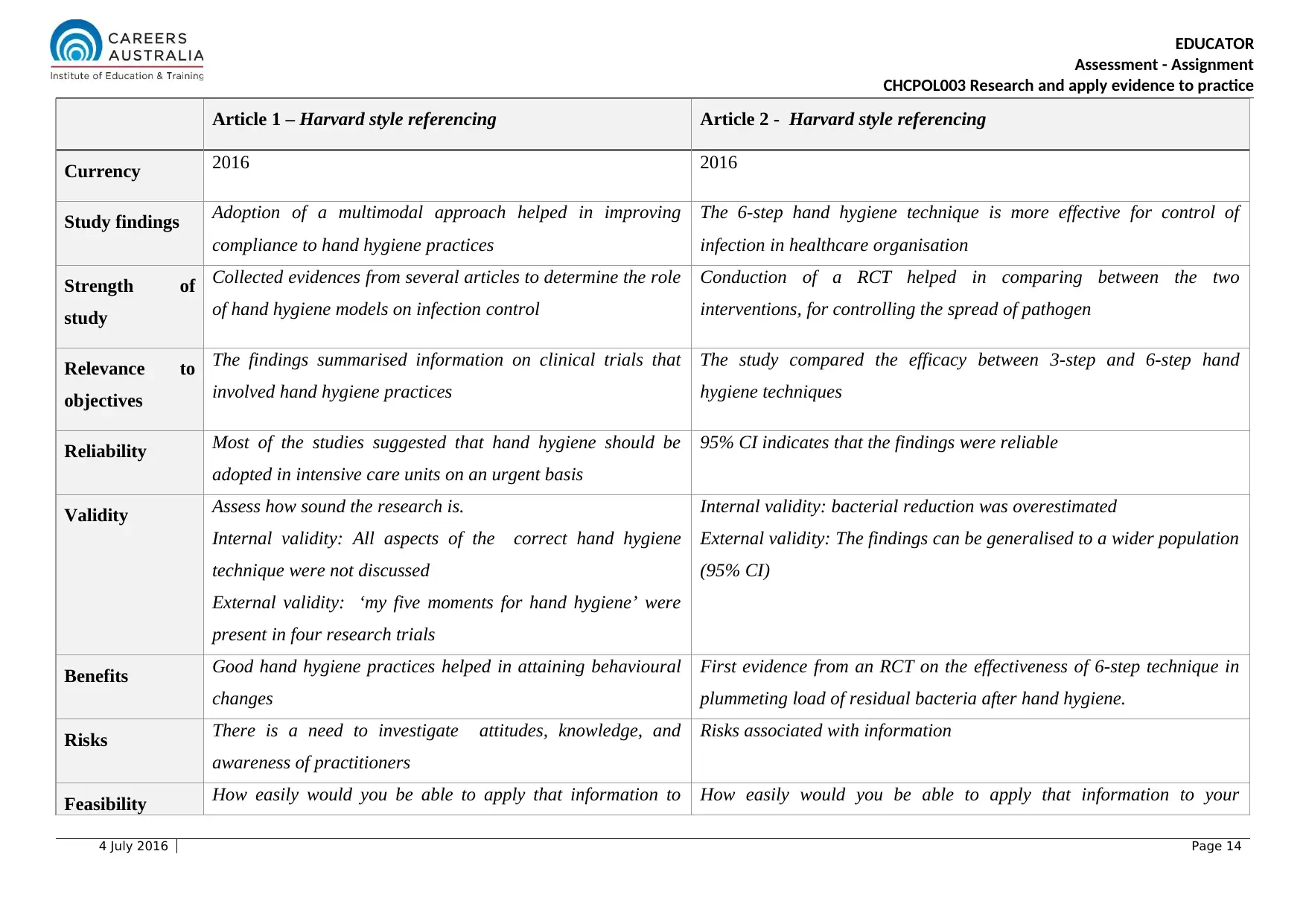
EDUCATOR
Assessment - Assignment
CHCPOL003 Research and apply evidence to practice
Article 1 – Harvard style referencing Article 2 - Harvard style referencing
Currency 2016 2016
Study findings Adoption of a multimodal approach helped in improving
compliance to hand hygiene practices
The 6-step hand hygiene technique is more effective for control of
infection in healthcare organisation
Strength of
study
Collected evidences from several articles to determine the role
of hand hygiene models on infection control
Conduction of a RCT helped in comparing between the two
interventions, for controlling the spread of pathogen
Relevance to
objectives
The findings summarised information on clinical trials that
involved hand hygiene practices
The study compared the efficacy between 3-step and 6-step hand
hygiene techniques
Reliability Most of the studies suggested that hand hygiene should be
adopted in intensive care units on an urgent basis
95% CI indicates that the findings were reliable
Validity Assess how sound the research is.
Internal validity: All aspects of the correct hand hygiene
technique were not discussed
External validity: ‘my five moments for hand hygiene’ were
present in four research trials
Internal validity: bacterial reduction was overestimated
External validity: The findings can be generalised to a wider population
(95% CI)
Benefits Good hand hygiene practices helped in attaining behavioural
changes
First evidence from an RCT on the effectiveness of 6-step technique in
plummeting load of residual bacteria after hand hygiene.
Risks There is a need to investigate attitudes, knowledge, and
awareness of practitioners
Risks associated with information
Feasibility How easily would you be able to apply that information to How easily would you be able to apply that information to your
4 July 2016 Page 14
Assessment - Assignment
CHCPOL003 Research and apply evidence to practice
Article 1 – Harvard style referencing Article 2 - Harvard style referencing
Currency 2016 2016
Study findings Adoption of a multimodal approach helped in improving
compliance to hand hygiene practices
The 6-step hand hygiene technique is more effective for control of
infection in healthcare organisation
Strength of
study
Collected evidences from several articles to determine the role
of hand hygiene models on infection control
Conduction of a RCT helped in comparing between the two
interventions, for controlling the spread of pathogen
Relevance to
objectives
The findings summarised information on clinical trials that
involved hand hygiene practices
The study compared the efficacy between 3-step and 6-step hand
hygiene techniques
Reliability Most of the studies suggested that hand hygiene should be
adopted in intensive care units on an urgent basis
95% CI indicates that the findings were reliable
Validity Assess how sound the research is.
Internal validity: All aspects of the correct hand hygiene
technique were not discussed
External validity: ‘my five moments for hand hygiene’ were
present in four research trials
Internal validity: bacterial reduction was overestimated
External validity: The findings can be generalised to a wider population
(95% CI)
Benefits Good hand hygiene practices helped in attaining behavioural
changes
First evidence from an RCT on the effectiveness of 6-step technique in
plummeting load of residual bacteria after hand hygiene.
Risks There is a need to investigate attitudes, knowledge, and
awareness of practitioners
Risks associated with information
Feasibility How easily would you be able to apply that information to How easily would you be able to apply that information to your
4 July 2016 Page 14
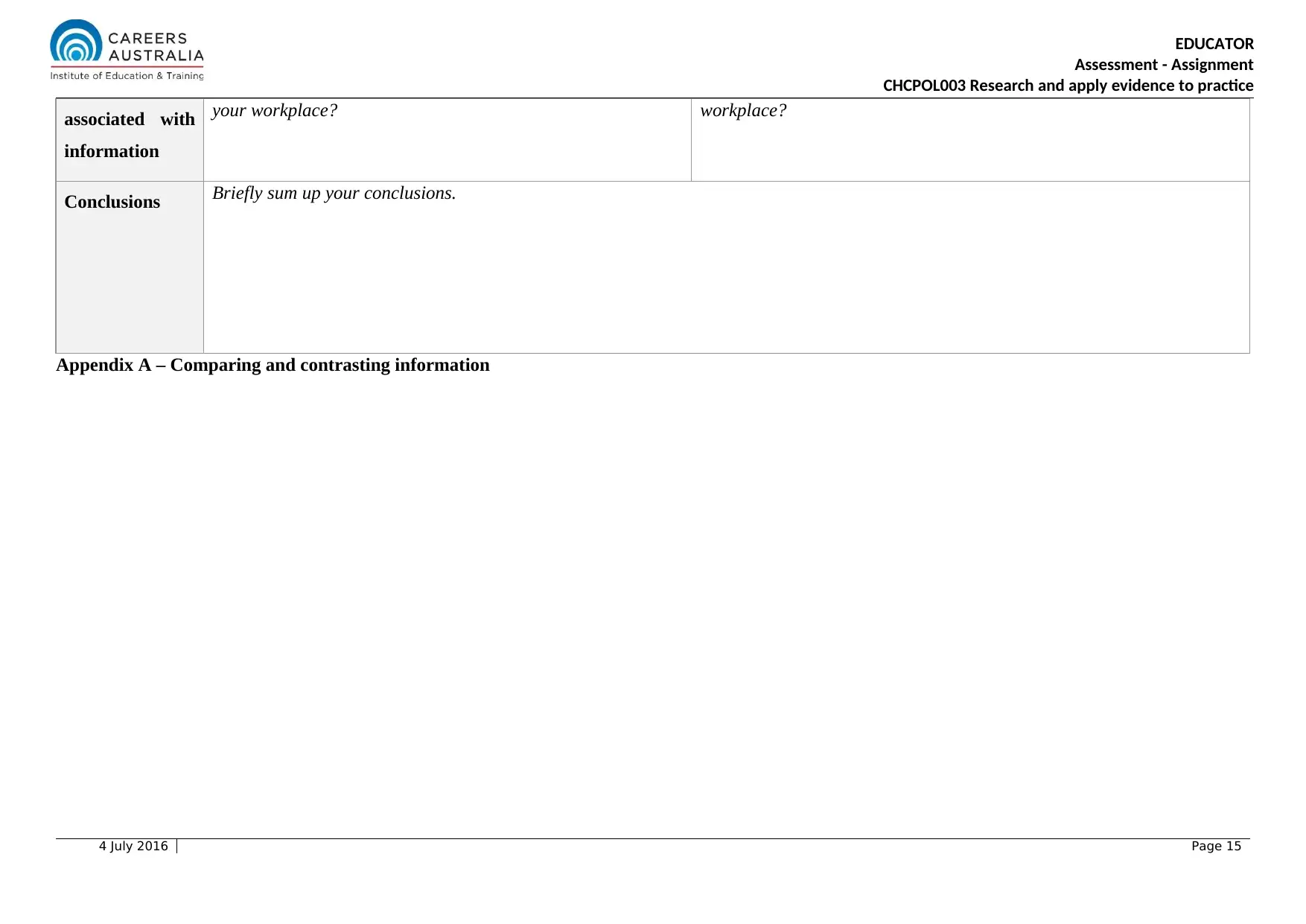
EDUCATOR
Assessment - Assignment
CHCPOL003 Research and apply evidence to practice
associated with
information
your workplace? workplace?
Conclusions Briefly sum up your conclusions.
Appendix A – Comparing and contrasting information
4 July 2016 Page 15
Assessment - Assignment
CHCPOL003 Research and apply evidence to practice
associated with
information
your workplace? workplace?
Conclusions Briefly sum up your conclusions.
Appendix A – Comparing and contrasting information
4 July 2016 Page 15
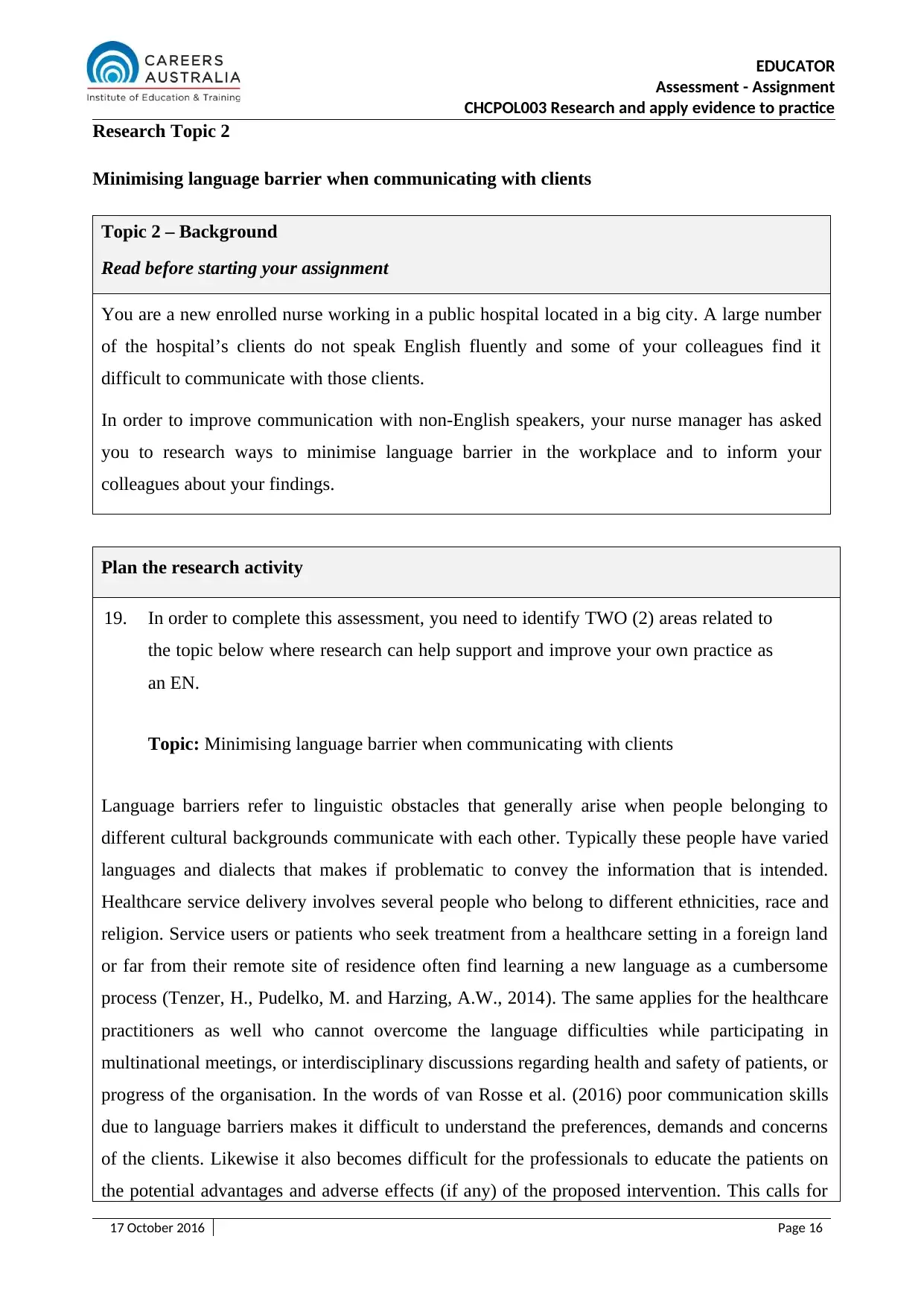
EDUCATOR
Assessment - Assignment
CHCPOL003 Research and apply evidence to practice
Research Topic 2
Minimising language barrier when communicating with clients
Topic 2 – Background
Read before starting your assignment
You are a new enrolled nurse working in a public hospital located in a big city. A large number
of the hospital’s clients do not speak English fluently and some of your colleagues find it
difficult to communicate with those clients.
In order to improve communication with non-English speakers, your nurse manager has asked
you to research ways to minimise language barrier in the workplace and to inform your
colleagues about your findings.
Plan the research activity
19. In order to complete this assessment, you need to identify TWO (2) areas related to
the topic below where research can help support and improve your own practice as
an EN.
Topic: Minimising language barrier when communicating with clients
Language barriers refer to linguistic obstacles that generally arise when people belonging to
different cultural backgrounds communicate with each other. Typically these people have varied
languages and dialects that makes if problematic to convey the information that is intended.
Healthcare service delivery involves several people who belong to different ethnicities, race and
religion. Service users or patients who seek treatment from a healthcare setting in a foreign land
or far from their remote site of residence often find learning a new language as a cumbersome
process (Tenzer, H., Pudelko, M. and Harzing, A.W., 2014). The same applies for the healthcare
practitioners as well who cannot overcome the language difficulties while participating in
multinational meetings, or interdisciplinary discussions regarding health and safety of patients, or
progress of the organisation. In the words of van Rosse et al. (2016) poor communication skills
due to language barriers makes it difficult to understand the preferences, demands and concerns
of the clients. Likewise it also becomes difficult for the professionals to educate the patients on
the potential advantages and adverse effects (if any) of the proposed intervention. This calls for
17 October 2016 Page 16
Assessment - Assignment
CHCPOL003 Research and apply evidence to practice
Research Topic 2
Minimising language barrier when communicating with clients
Topic 2 – Background
Read before starting your assignment
You are a new enrolled nurse working in a public hospital located in a big city. A large number
of the hospital’s clients do not speak English fluently and some of your colleagues find it
difficult to communicate with those clients.
In order to improve communication with non-English speakers, your nurse manager has asked
you to research ways to minimise language barrier in the workplace and to inform your
colleagues about your findings.
Plan the research activity
19. In order to complete this assessment, you need to identify TWO (2) areas related to
the topic below where research can help support and improve your own practice as
an EN.
Topic: Minimising language barrier when communicating with clients
Language barriers refer to linguistic obstacles that generally arise when people belonging to
different cultural backgrounds communicate with each other. Typically these people have varied
languages and dialects that makes if problematic to convey the information that is intended.
Healthcare service delivery involves several people who belong to different ethnicities, race and
religion. Service users or patients who seek treatment from a healthcare setting in a foreign land
or far from their remote site of residence often find learning a new language as a cumbersome
process (Tenzer, H., Pudelko, M. and Harzing, A.W., 2014). The same applies for the healthcare
practitioners as well who cannot overcome the language difficulties while participating in
multinational meetings, or interdisciplinary discussions regarding health and safety of patients, or
progress of the organisation. In the words of van Rosse et al. (2016) poor communication skills
due to language barriers makes it difficult to understand the preferences, demands and concerns
of the clients. Likewise it also becomes difficult for the professionals to educate the patients on
the potential advantages and adverse effects (if any) of the proposed intervention. This calls for
17 October 2016 Page 16
Secure Best Marks with AI Grader
Need help grading? Try our AI Grader for instant feedback on your assignments.
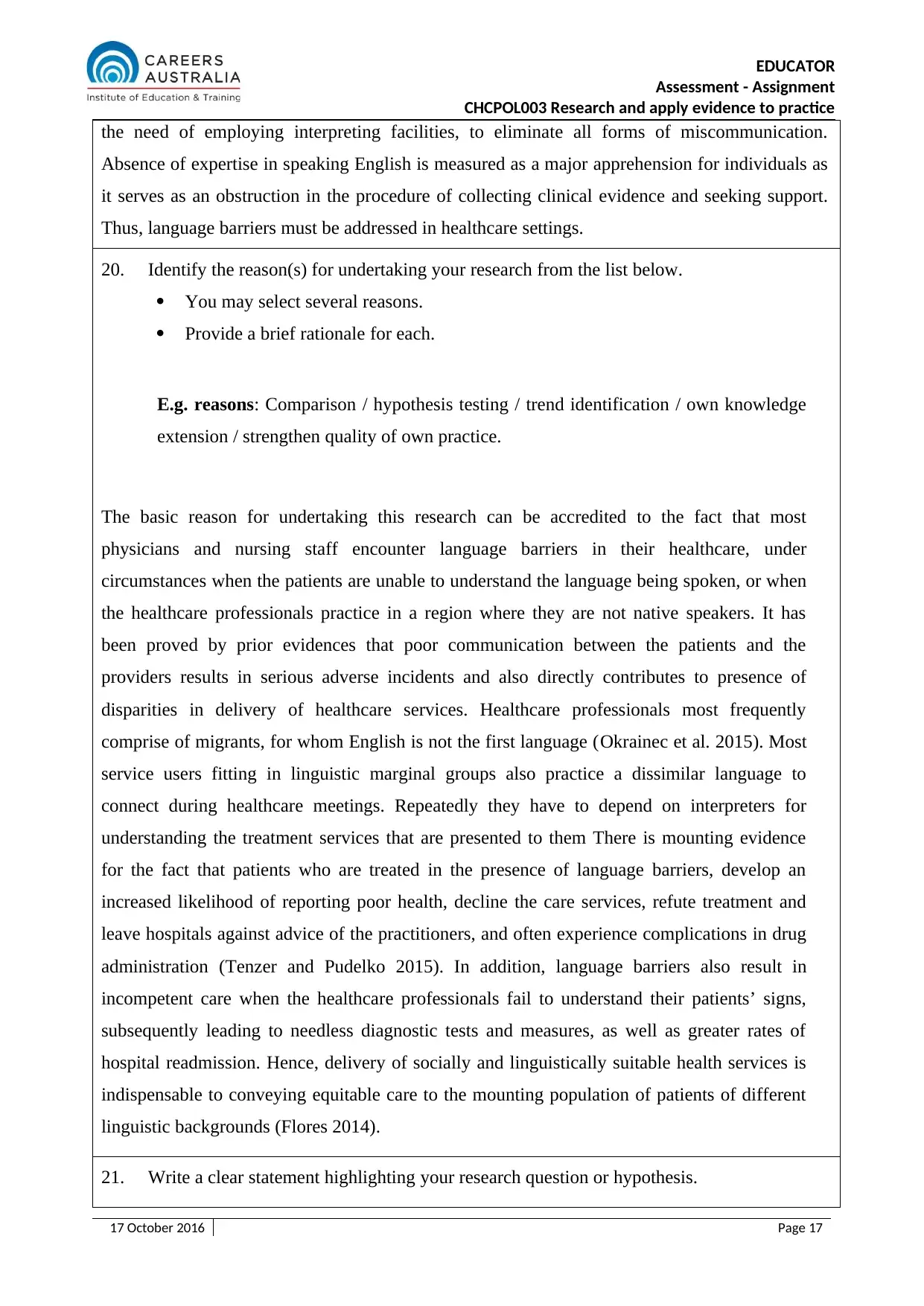
EDUCATOR
Assessment - Assignment
CHCPOL003 Research and apply evidence to practice
the need of employing interpreting facilities, to eliminate all forms of miscommunication.
Absence of expertise in speaking English is measured as a major apprehension for individuals as
it serves as an obstruction in the procedure of collecting clinical evidence and seeking support.
Thus, language barriers must be addressed in healthcare settings.
20. Identify the reason(s) for undertaking your research from the list below.
You may select several reasons.
Provide a brief rationale for each.
E.g. reasons: Comparison / hypothesis testing / trend identification / own knowledge
extension / strengthen quality of own practice.
The basic reason for undertaking this research can be accredited to the fact that most
physicians and nursing staff encounter language barriers in their healthcare, under
circumstances when the patients are unable to understand the language being spoken, or when
the healthcare professionals practice in a region where they are not native speakers. It has
been proved by prior evidences that poor communication between the patients and the
providers results in serious adverse incidents and also directly contributes to presence of
disparities in delivery of healthcare services. Healthcare professionals most frequently
comprise of migrants, for whom English is not the first language (Okrainec et al. 2015). Most
service users fitting in linguistic marginal groups also practice a dissimilar language to
connect during healthcare meetings. Repeatedly they have to depend on interpreters for
understanding the treatment services that are presented to them There is mounting evidence
for the fact that patients who are treated in the presence of language barriers, develop an
increased likelihood of reporting poor health, decline the care services, refute treatment and
leave hospitals against advice of the practitioners, and often experience complications in drug
administration (Tenzer and Pudelko 2015). In addition, language barriers also result in
incompetent care when the healthcare professionals fail to understand their patients’ signs,
subsequently leading to needless diagnostic tests and measures, as well as greater rates of
hospital readmission. Hence, delivery of socially and linguistically suitable health services is
indispensable to conveying equitable care to the mounting population of patients of different
linguistic backgrounds (Flores 2014).
21. Write a clear statement highlighting your research question or hypothesis.
17 October 2016 Page 17
Assessment - Assignment
CHCPOL003 Research and apply evidence to practice
the need of employing interpreting facilities, to eliminate all forms of miscommunication.
Absence of expertise in speaking English is measured as a major apprehension for individuals as
it serves as an obstruction in the procedure of collecting clinical evidence and seeking support.
Thus, language barriers must be addressed in healthcare settings.
20. Identify the reason(s) for undertaking your research from the list below.
You may select several reasons.
Provide a brief rationale for each.
E.g. reasons: Comparison / hypothesis testing / trend identification / own knowledge
extension / strengthen quality of own practice.
The basic reason for undertaking this research can be accredited to the fact that most
physicians and nursing staff encounter language barriers in their healthcare, under
circumstances when the patients are unable to understand the language being spoken, or when
the healthcare professionals practice in a region where they are not native speakers. It has
been proved by prior evidences that poor communication between the patients and the
providers results in serious adverse incidents and also directly contributes to presence of
disparities in delivery of healthcare services. Healthcare professionals most frequently
comprise of migrants, for whom English is not the first language (Okrainec et al. 2015). Most
service users fitting in linguistic marginal groups also practice a dissimilar language to
connect during healthcare meetings. Repeatedly they have to depend on interpreters for
understanding the treatment services that are presented to them There is mounting evidence
for the fact that patients who are treated in the presence of language barriers, develop an
increased likelihood of reporting poor health, decline the care services, refute treatment and
leave hospitals against advice of the practitioners, and often experience complications in drug
administration (Tenzer and Pudelko 2015). In addition, language barriers also result in
incompetent care when the healthcare professionals fail to understand their patients’ signs,
subsequently leading to needless diagnostic tests and measures, as well as greater rates of
hospital readmission. Hence, delivery of socially and linguistically suitable health services is
indispensable to conveying equitable care to the mounting population of patients of different
linguistic backgrounds (Flores 2014).
21. Write a clear statement highlighting your research question or hypothesis.
17 October 2016 Page 17
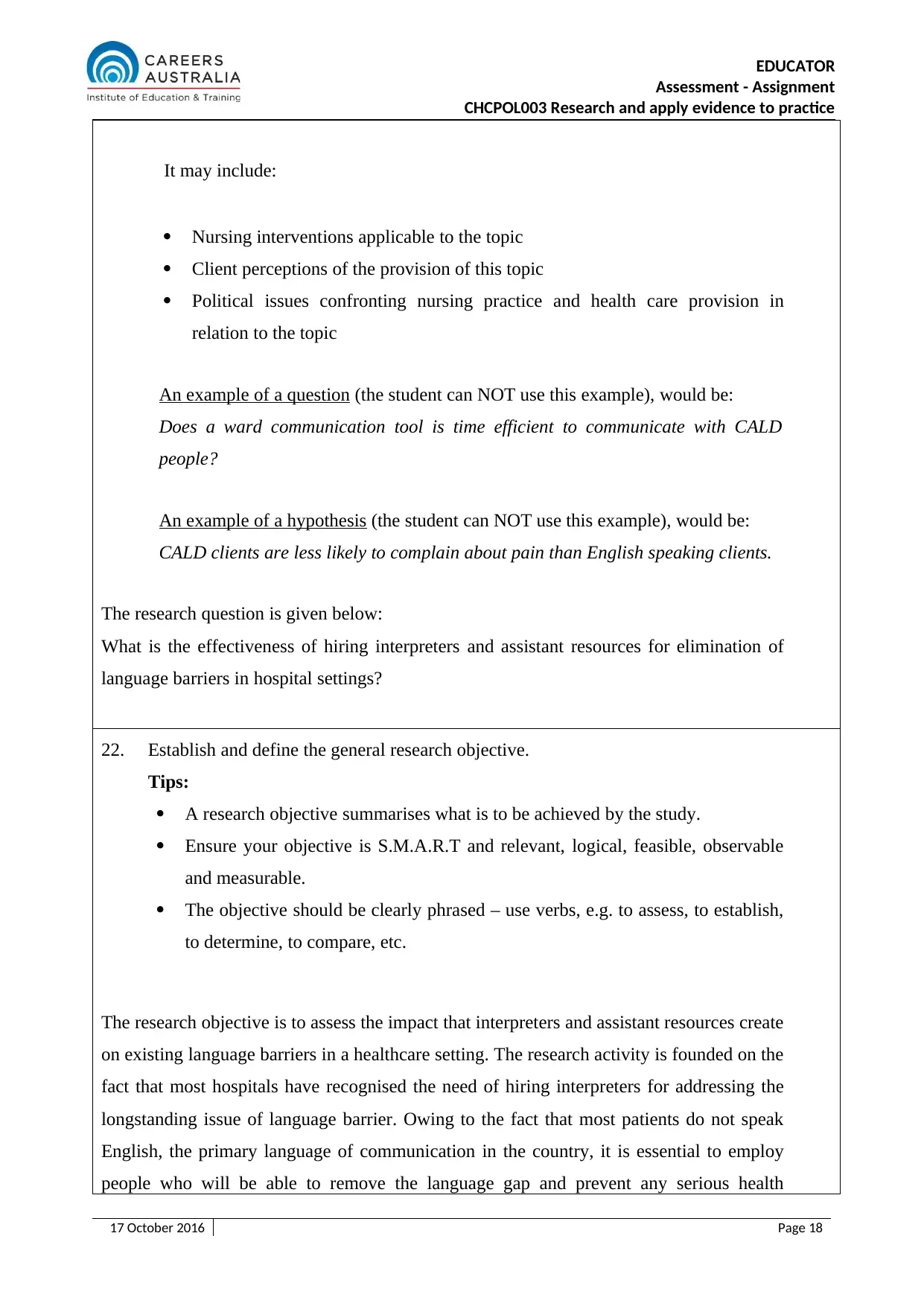
EDUCATOR
Assessment - Assignment
CHCPOL003 Research and apply evidence to practice
It may include:
Nursing interventions applicable to the topic
Client perceptions of the provision of this topic
Political issues confronting nursing practice and health care provision in
relation to the topic
An example of a question (the student can NOT use this example), would be:
Does a ward communication tool is time efficient to communicate with CALD
people?
An example of a hypothesis (the student can NOT use this example), would be:
CALD clients are less likely to complain about pain than English speaking clients.
The research question is given below:
What is the effectiveness of hiring interpreters and assistant resources for elimination of
language barriers in hospital settings?
22. Establish and define the general research objective.
Tips:
A research objective summarises what is to be achieved by the study.
Ensure your objective is S.M.A.R.T and relevant, logical, feasible, observable
and measurable.
The objective should be clearly phrased – use verbs, e.g. to assess, to establish,
to determine, to compare, etc.
The research objective is to assess the impact that interpreters and assistant resources create
on existing language barriers in a healthcare setting. The research activity is founded on the
fact that most hospitals have recognised the need of hiring interpreters for addressing the
longstanding issue of language barrier. Owing to the fact that most patients do not speak
English, the primary language of communication in the country, it is essential to employ
people who will be able to remove the language gap and prevent any serious health
17 October 2016 Page 18
Assessment - Assignment
CHCPOL003 Research and apply evidence to practice
It may include:
Nursing interventions applicable to the topic
Client perceptions of the provision of this topic
Political issues confronting nursing practice and health care provision in
relation to the topic
An example of a question (the student can NOT use this example), would be:
Does a ward communication tool is time efficient to communicate with CALD
people?
An example of a hypothesis (the student can NOT use this example), would be:
CALD clients are less likely to complain about pain than English speaking clients.
The research question is given below:
What is the effectiveness of hiring interpreters and assistant resources for elimination of
language barriers in hospital settings?
22. Establish and define the general research objective.
Tips:
A research objective summarises what is to be achieved by the study.
Ensure your objective is S.M.A.R.T and relevant, logical, feasible, observable
and measurable.
The objective should be clearly phrased – use verbs, e.g. to assess, to establish,
to determine, to compare, etc.
The research objective is to assess the impact that interpreters and assistant resources create
on existing language barriers in a healthcare setting. The research activity is founded on the
fact that most hospitals have recognised the need of hiring interpreters for addressing the
longstanding issue of language barrier. Owing to the fact that most patients do not speak
English, the primary language of communication in the country, it is essential to employ
people who will be able to remove the language gap and prevent any serious health
17 October 2016 Page 18
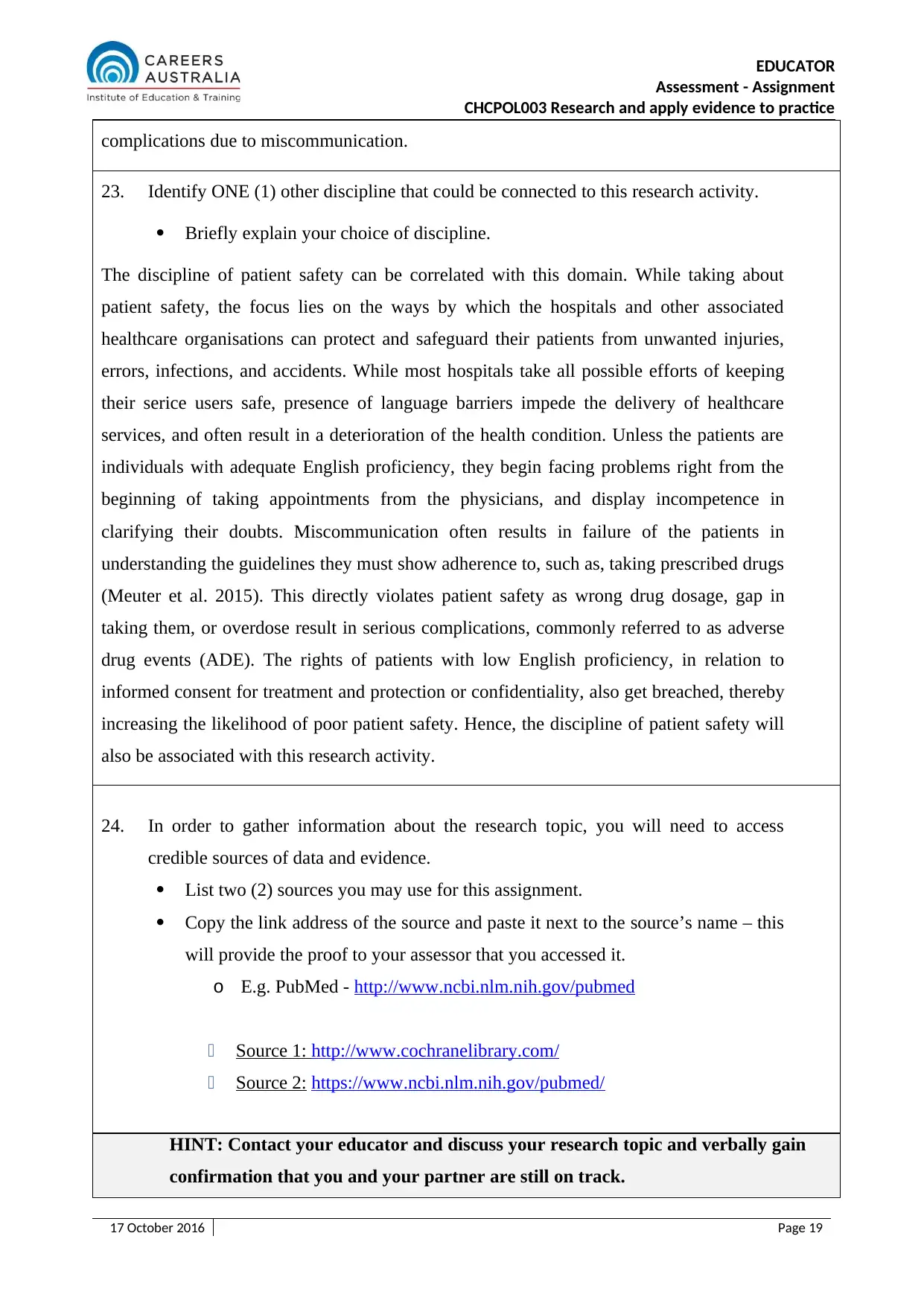
EDUCATOR
Assessment - Assignment
CHCPOL003 Research and apply evidence to practice
complications due to miscommunication.
23. Identify ONE (1) other discipline that could be connected to this research activity.
Briefly explain your choice of discipline.
The discipline of patient safety can be correlated with this domain. While taking about
patient safety, the focus lies on the ways by which the hospitals and other associated
healthcare organisations can protect and safeguard their patients from unwanted injuries,
errors, infections, and accidents. While most hospitals take all possible efforts of keeping
their serice users safe, presence of language barriers impede the delivery of healthcare
services, and often result in a deterioration of the health condition. Unless the patients are
individuals with adequate English proficiency, they begin facing problems right from the
beginning of taking appointments from the physicians, and display incompetence in
clarifying their doubts. Miscommunication often results in failure of the patients in
understanding the guidelines they must show adherence to, such as, taking prescribed drugs
(Meuter et al. 2015). This directly violates patient safety as wrong drug dosage, gap in
taking them, or overdose result in serious complications, commonly referred to as adverse
drug events (ADE). The rights of patients with low English proficiency, in relation to
informed consent for treatment and protection or confidentiality, also get breached, thereby
increasing the likelihood of poor patient safety. Hence, the discipline of patient safety will
also be associated with this research activity.
24. In order to gather information about the research topic, you will need to access
credible sources of data and evidence.
List two (2) sources you may use for this assignment.
Copy the link address of the source and paste it next to the source’s name – this
will provide the proof to your assessor that you accessed it.
o E.g. PubMed - http://www.ncbi.nlm.nih.gov/pubmed
Source 1: http://www.cochranelibrary.com/
Source 2: https://www.ncbi.nlm.nih.gov/pubmed/
HINT: Contact your educator and discuss your research topic and verbally gain
confirmation that you and your partner are still on track.
17 October 2016 Page 19
Assessment - Assignment
CHCPOL003 Research and apply evidence to practice
complications due to miscommunication.
23. Identify ONE (1) other discipline that could be connected to this research activity.
Briefly explain your choice of discipline.
The discipline of patient safety can be correlated with this domain. While taking about
patient safety, the focus lies on the ways by which the hospitals and other associated
healthcare organisations can protect and safeguard their patients from unwanted injuries,
errors, infections, and accidents. While most hospitals take all possible efforts of keeping
their serice users safe, presence of language barriers impede the delivery of healthcare
services, and often result in a deterioration of the health condition. Unless the patients are
individuals with adequate English proficiency, they begin facing problems right from the
beginning of taking appointments from the physicians, and display incompetence in
clarifying their doubts. Miscommunication often results in failure of the patients in
understanding the guidelines they must show adherence to, such as, taking prescribed drugs
(Meuter et al. 2015). This directly violates patient safety as wrong drug dosage, gap in
taking them, or overdose result in serious complications, commonly referred to as adverse
drug events (ADE). The rights of patients with low English proficiency, in relation to
informed consent for treatment and protection or confidentiality, also get breached, thereby
increasing the likelihood of poor patient safety. Hence, the discipline of patient safety will
also be associated with this research activity.
24. In order to gather information about the research topic, you will need to access
credible sources of data and evidence.
List two (2) sources you may use for this assignment.
Copy the link address of the source and paste it next to the source’s name – this
will provide the proof to your assessor that you accessed it.
o E.g. PubMed - http://www.ncbi.nlm.nih.gov/pubmed
Source 1: http://www.cochranelibrary.com/
Source 2: https://www.ncbi.nlm.nih.gov/pubmed/
HINT: Contact your educator and discuss your research topic and verbally gain
confirmation that you and your partner are still on track.
17 October 2016 Page 19
Paraphrase This Document
Need a fresh take? Get an instant paraphrase of this document with our AI Paraphraser
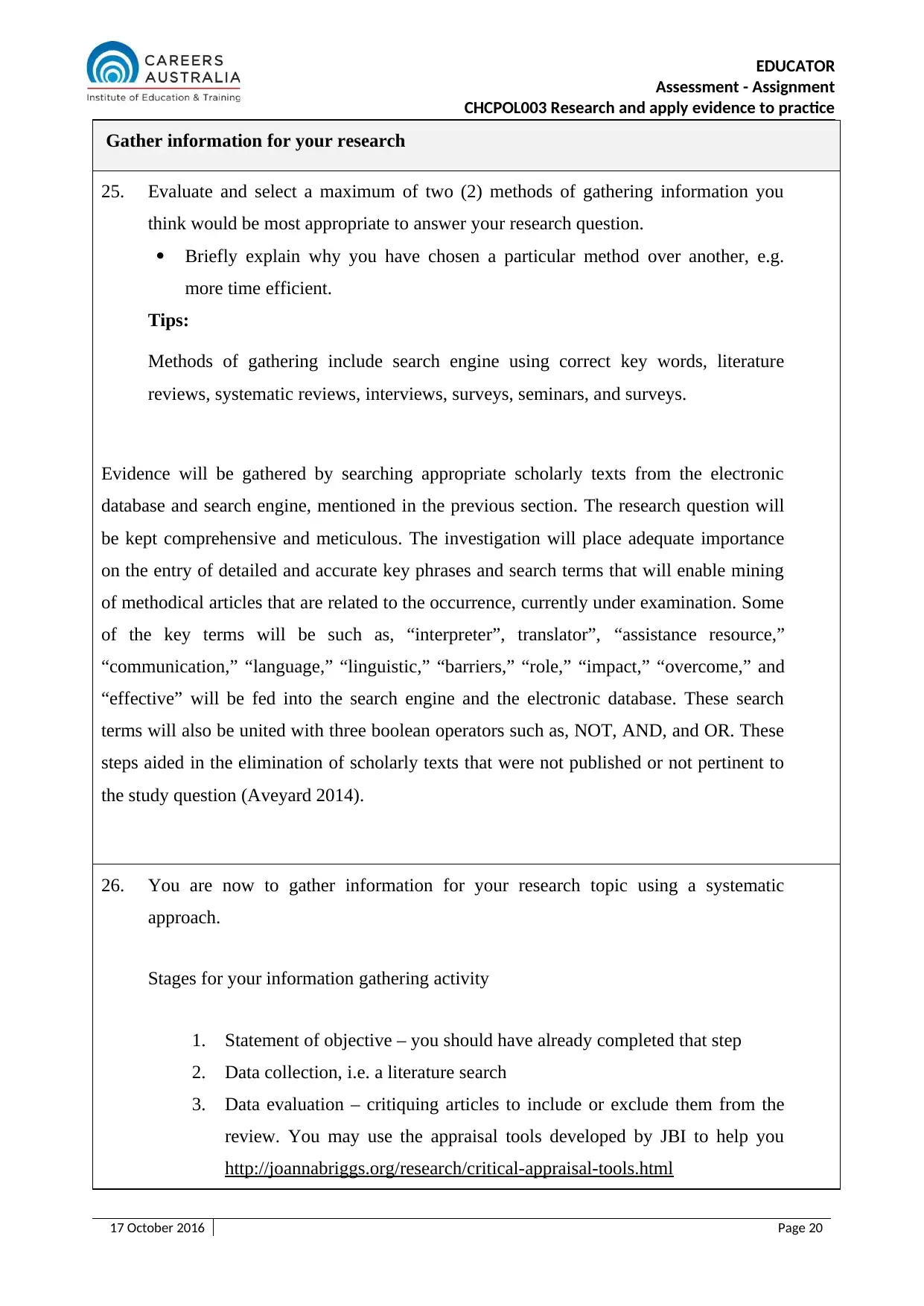
EDUCATOR
Assessment - Assignment
CHCPOL003 Research and apply evidence to practice
Gather information for your research
25. Evaluate and select a maximum of two (2) methods of gathering information you
think would be most appropriate to answer your research question.
Briefly explain why you have chosen a particular method over another, e.g.
more time efficient.
Tips:
Methods of gathering include search engine using correct key words, literature
reviews, systematic reviews, interviews, surveys, seminars, and surveys.
Evidence will be gathered by searching appropriate scholarly texts from the electronic
database and search engine, mentioned in the previous section. The research question will
be kept comprehensive and meticulous. The investigation will place adequate importance
on the entry of detailed and accurate key phrases and search terms that will enable mining
of methodical articles that are related to the occurrence, currently under examination. Some
of the key terms will be such as, “interpreter”, translator”, “assistance resource,”
“communication,” “language,” “linguistic,” “barriers,” “role,” “impact,” “overcome,” and
“effective” will be fed into the search engine and the electronic database. These search
terms will also be united with three boolean operators such as, NOT, AND, and OR. These
steps aided in the elimination of scholarly texts that were not published or not pertinent to
the study question (Aveyard 2014).
26. You are now to gather information for your research topic using a systematic
approach.
Stages for your information gathering activity
1. Statement of objective – you should have already completed that step
2. Data collection, i.e. a literature search
3. Data evaluation – critiquing articles to include or exclude them from the
review. You may use the appraisal tools developed by JBI to help you
http://joannabriggs.org/research/critical-appraisal-tools.html
17 October 2016 Page 20
Assessment - Assignment
CHCPOL003 Research and apply evidence to practice
Gather information for your research
25. Evaluate and select a maximum of two (2) methods of gathering information you
think would be most appropriate to answer your research question.
Briefly explain why you have chosen a particular method over another, e.g.
more time efficient.
Tips:
Methods of gathering include search engine using correct key words, literature
reviews, systematic reviews, interviews, surveys, seminars, and surveys.
Evidence will be gathered by searching appropriate scholarly texts from the electronic
database and search engine, mentioned in the previous section. The research question will
be kept comprehensive and meticulous. The investigation will place adequate importance
on the entry of detailed and accurate key phrases and search terms that will enable mining
of methodical articles that are related to the occurrence, currently under examination. Some
of the key terms will be such as, “interpreter”, translator”, “assistance resource,”
“communication,” “language,” “linguistic,” “barriers,” “role,” “impact,” “overcome,” and
“effective” will be fed into the search engine and the electronic database. These search
terms will also be united with three boolean operators such as, NOT, AND, and OR. These
steps aided in the elimination of scholarly texts that were not published or not pertinent to
the study question (Aveyard 2014).
26. You are now to gather information for your research topic using a systematic
approach.
Stages for your information gathering activity
1. Statement of objective – you should have already completed that step
2. Data collection, i.e. a literature search
3. Data evaluation – critiquing articles to include or exclude them from the
review. You may use the appraisal tools developed by JBI to help you
http://joannabriggs.org/research/critical-appraisal-tools.html
17 October 2016 Page 20
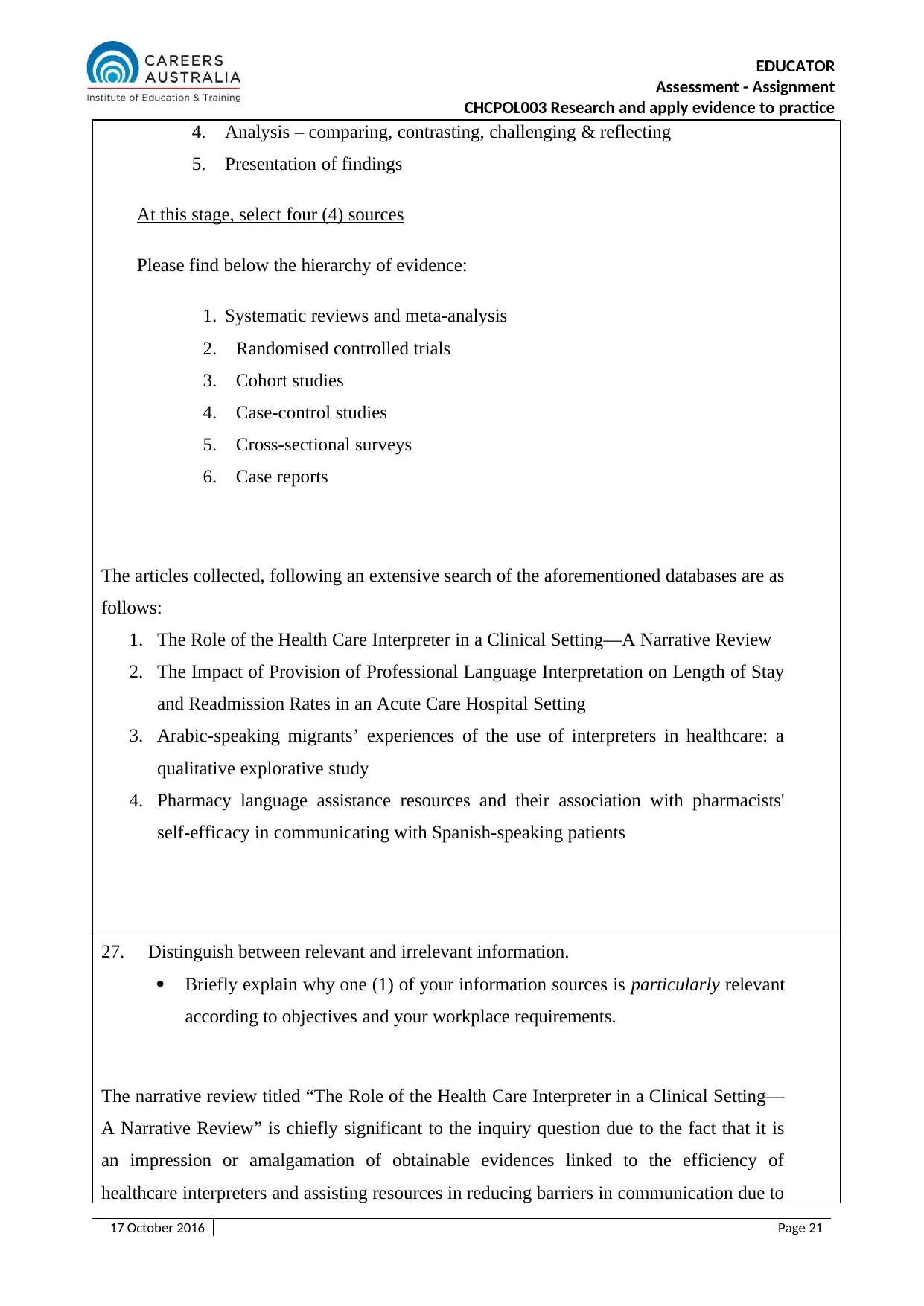
EDUCATOR
Assessment - Assignment
CHCPOL003 Research and apply evidence to practice
4. Analysis – comparing, contrasting, challenging & reflecting
5. Presentation of findings
At this stage, select four (4) sources
Please find below the hierarchy of evidence:
1. Systematic reviews and meta-analysis
2. Randomised controlled trials
3. Cohort studies
4. Case-control studies
5. Cross-sectional surveys
6. Case reports
The articles collected, following an extensive search of the aforementioned databases are as
follows:
1. The Role of the Health Care Interpreter in a Clinical Setting—A Narrative Review
2. The Impact of Provision of Professional Language Interpretation on Length of Stay
and Readmission Rates in an Acute Care Hospital Setting
3. Arabic-speaking migrants’ experiences of the use of interpreters in healthcare: a
qualitative explorative study
4. Pharmacy language assistance resources and their association with pharmacists'
self-efficacy in communicating with Spanish-speaking patients
27. Distinguish between relevant and irrelevant information.
Briefly explain why one (1) of your information sources is particularly relevant
according to objectives and your workplace requirements.
The narrative review titled “The Role of the Health Care Interpreter in a Clinical Setting—
A Narrative Review” is chiefly significant to the inquiry question due to the fact that it is
an impression or amalgamation of obtainable evidences linked to the efficiency of
healthcare interpreters and assisting resources in reducing barriers in communication due to
17 October 2016 Page 21
Assessment - Assignment
CHCPOL003 Research and apply evidence to practice
4. Analysis – comparing, contrasting, challenging & reflecting
5. Presentation of findings
At this stage, select four (4) sources
Please find below the hierarchy of evidence:
1. Systematic reviews and meta-analysis
2. Randomised controlled trials
3. Cohort studies
4. Case-control studies
5. Cross-sectional surveys
6. Case reports
The articles collected, following an extensive search of the aforementioned databases are as
follows:
1. The Role of the Health Care Interpreter in a Clinical Setting—A Narrative Review
2. The Impact of Provision of Professional Language Interpretation on Length of Stay
and Readmission Rates in an Acute Care Hospital Setting
3. Arabic-speaking migrants’ experiences of the use of interpreters in healthcare: a
qualitative explorative study
4. Pharmacy language assistance resources and their association with pharmacists'
self-efficacy in communicating with Spanish-speaking patients
27. Distinguish between relevant and irrelevant information.
Briefly explain why one (1) of your information sources is particularly relevant
according to objectives and your workplace requirements.
The narrative review titled “The Role of the Health Care Interpreter in a Clinical Setting—
A Narrative Review” is chiefly significant to the inquiry question due to the fact that it is
an impression or amalgamation of obtainable evidences linked to the efficiency of
healthcare interpreters and assisting resources in reducing barriers in communication due to
17 October 2016 Page 21
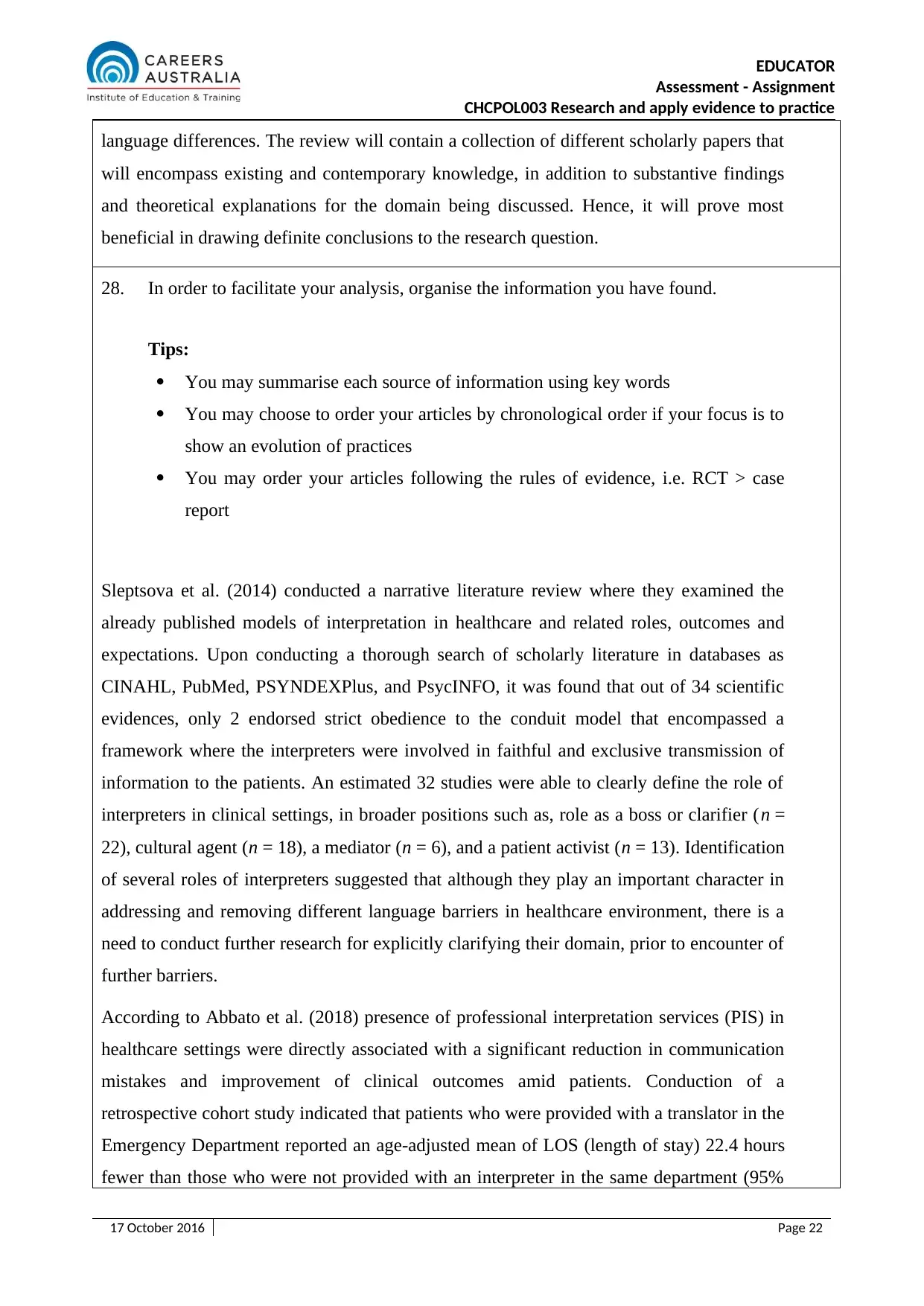
EDUCATOR
Assessment - Assignment
CHCPOL003 Research and apply evidence to practice
language differences. The review will contain a collection of different scholarly papers that
will encompass existing and contemporary knowledge, in addition to substantive findings
and theoretical explanations for the domain being discussed. Hence, it will prove most
beneficial in drawing definite conclusions to the research question.
28. In order to facilitate your analysis, organise the information you have found.
Tips:
You may summarise each source of information using key words
You may choose to order your articles by chronological order if your focus is to
show an evolution of practices
You may order your articles following the rules of evidence, i.e. RCT > case
report
Sleptsova et al. (2014) conducted a narrative literature review where they examined the
already published models of interpretation in healthcare and related roles, outcomes and
expectations. Upon conducting a thorough search of scholarly literature in databases as
CINAHL, PubMed, PSYNDEXPlus, and PsycINFO, it was found that out of 34 scientific
evidences, only 2 endorsed strict obedience to the conduit model that encompassed a
framework where the interpreters were involved in faithful and exclusive transmission of
information to the patients. An estimated 32 studies were able to clearly define the role of
interpreters in clinical settings, in broader positions such as, role as a boss or clarifier (n =
22), cultural agent (n = 18), a mediator (n = 6), and a patient activist (n = 13). Identification
of several roles of interpreters suggested that although they play an important character in
addressing and removing different language barriers in healthcare environment, there is a
need to conduct further research for explicitly clarifying their domain, prior to encounter of
further barriers.
According to Abbato et al. (2018) presence of professional interpretation services (PIS) in
healthcare settings were directly associated with a significant reduction in communication
mistakes and improvement of clinical outcomes amid patients. Conduction of a
retrospective cohort study indicated that patients who were provided with a translator in the
Emergency Department reported an age-adjusted mean of LOS (length of stay) 22.4 hours
fewer than those who were not provided with an interpreter in the same department (95%
17 October 2016 Page 22
Assessment - Assignment
CHCPOL003 Research and apply evidence to practice
language differences. The review will contain a collection of different scholarly papers that
will encompass existing and contemporary knowledge, in addition to substantive findings
and theoretical explanations for the domain being discussed. Hence, it will prove most
beneficial in drawing definite conclusions to the research question.
28. In order to facilitate your analysis, organise the information you have found.
Tips:
You may summarise each source of information using key words
You may choose to order your articles by chronological order if your focus is to
show an evolution of practices
You may order your articles following the rules of evidence, i.e. RCT > case
report
Sleptsova et al. (2014) conducted a narrative literature review where they examined the
already published models of interpretation in healthcare and related roles, outcomes and
expectations. Upon conducting a thorough search of scholarly literature in databases as
CINAHL, PubMed, PSYNDEXPlus, and PsycINFO, it was found that out of 34 scientific
evidences, only 2 endorsed strict obedience to the conduit model that encompassed a
framework where the interpreters were involved in faithful and exclusive transmission of
information to the patients. An estimated 32 studies were able to clearly define the role of
interpreters in clinical settings, in broader positions such as, role as a boss or clarifier (n =
22), cultural agent (n = 18), a mediator (n = 6), and a patient activist (n = 13). Identification
of several roles of interpreters suggested that although they play an important character in
addressing and removing different language barriers in healthcare environment, there is a
need to conduct further research for explicitly clarifying their domain, prior to encounter of
further barriers.
According to Abbato et al. (2018) presence of professional interpretation services (PIS) in
healthcare settings were directly associated with a significant reduction in communication
mistakes and improvement of clinical outcomes amid patients. Conduction of a
retrospective cohort study indicated that patients who were provided with a translator in the
Emergency Department reported an age-adjusted mean of LOS (length of stay) 22.4 hours
fewer than those who were not provided with an interpreter in the same department (95%
17 October 2016 Page 22
Secure Best Marks with AI Grader
Need help grading? Try our AI Grader for instant feedback on your assignments.
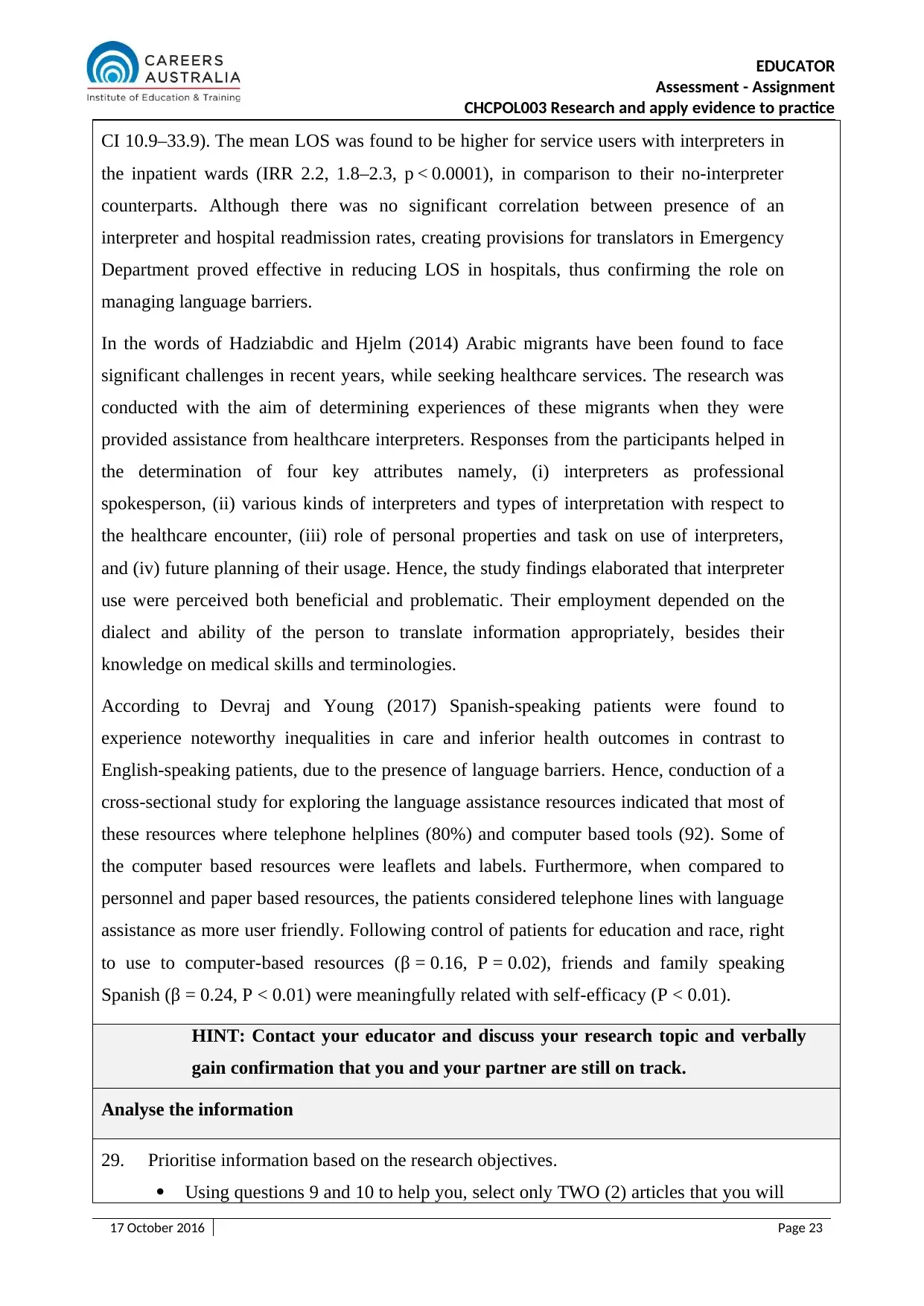
EDUCATOR
Assessment - Assignment
CHCPOL003 Research and apply evidence to practice
CI 10.9–33.9). The mean LOS was found to be higher for service users with interpreters in
the inpatient wards (IRR 2.2, 1.8–2.3, p < 0.0001), in comparison to their no-interpreter
counterparts. Although there was no significant correlation between presence of an
interpreter and hospital readmission rates, creating provisions for translators in Emergency
Department proved effective in reducing LOS in hospitals, thus confirming the role on
managing language barriers.
In the words of Hadziabdic and Hjelm (2014) Arabic migrants have been found to face
significant challenges in recent years, while seeking healthcare services. The research was
conducted with the aim of determining experiences of these migrants when they were
provided assistance from healthcare interpreters. Responses from the participants helped in
the determination of four key attributes namely, (i) interpreters as professional
spokesperson, (ii) various kinds of interpreters and types of interpretation with respect to
the healthcare encounter, (iii) role of personal properties and task on use of interpreters,
and (iv) future planning of their usage. Hence, the study findings elaborated that interpreter
use were perceived both beneficial and problematic. Their employment depended on the
dialect and ability of the person to translate information appropriately, besides their
knowledge on medical skills and terminologies.
According to Devraj and Young (2017) Spanish-speaking patients were found to
experience noteworthy inequalities in care and inferior health outcomes in contrast to
English-speaking patients, due to the presence of language barriers. Hence, conduction of a
cross-sectional study for exploring the language assistance resources indicated that most of
these resources where telephone helplines (80%) and computer based tools (92). Some of
the computer based resources were leaflets and labels. Furthermore, when compared to
personnel and paper based resources, the patients considered telephone lines with language
assistance as more user friendly. Following control of patients for education and race, right
to use to computer-based resources (β = 0.16, P = 0.02), friends and family speaking
Spanish (β = 0.24, P < 0.01) were meaningfully related with self-efficacy (P < 0.01).
HINT: Contact your educator and discuss your research topic and verbally
gain confirmation that you and your partner are still on track.
Analyse the information
29. Prioritise information based on the research objectives.
Using questions 9 and 10 to help you, select only TWO (2) articles that you will
17 October 2016 Page 23
Assessment - Assignment
CHCPOL003 Research and apply evidence to practice
CI 10.9–33.9). The mean LOS was found to be higher for service users with interpreters in
the inpatient wards (IRR 2.2, 1.8–2.3, p < 0.0001), in comparison to their no-interpreter
counterparts. Although there was no significant correlation between presence of an
interpreter and hospital readmission rates, creating provisions for translators in Emergency
Department proved effective in reducing LOS in hospitals, thus confirming the role on
managing language barriers.
In the words of Hadziabdic and Hjelm (2014) Arabic migrants have been found to face
significant challenges in recent years, while seeking healthcare services. The research was
conducted with the aim of determining experiences of these migrants when they were
provided assistance from healthcare interpreters. Responses from the participants helped in
the determination of four key attributes namely, (i) interpreters as professional
spokesperson, (ii) various kinds of interpreters and types of interpretation with respect to
the healthcare encounter, (iii) role of personal properties and task on use of interpreters,
and (iv) future planning of their usage. Hence, the study findings elaborated that interpreter
use were perceived both beneficial and problematic. Their employment depended on the
dialect and ability of the person to translate information appropriately, besides their
knowledge on medical skills and terminologies.
According to Devraj and Young (2017) Spanish-speaking patients were found to
experience noteworthy inequalities in care and inferior health outcomes in contrast to
English-speaking patients, due to the presence of language barriers. Hence, conduction of a
cross-sectional study for exploring the language assistance resources indicated that most of
these resources where telephone helplines (80%) and computer based tools (92). Some of
the computer based resources were leaflets and labels. Furthermore, when compared to
personnel and paper based resources, the patients considered telephone lines with language
assistance as more user friendly. Following control of patients for education and race, right
to use to computer-based resources (β = 0.16, P = 0.02), friends and family speaking
Spanish (β = 0.24, P < 0.01) were meaningfully related with self-efficacy (P < 0.01).
HINT: Contact your educator and discuss your research topic and verbally
gain confirmation that you and your partner are still on track.
Analyse the information
29. Prioritise information based on the research objectives.
Using questions 9 and 10 to help you, select only TWO (2) articles that you will
17 October 2016 Page 23
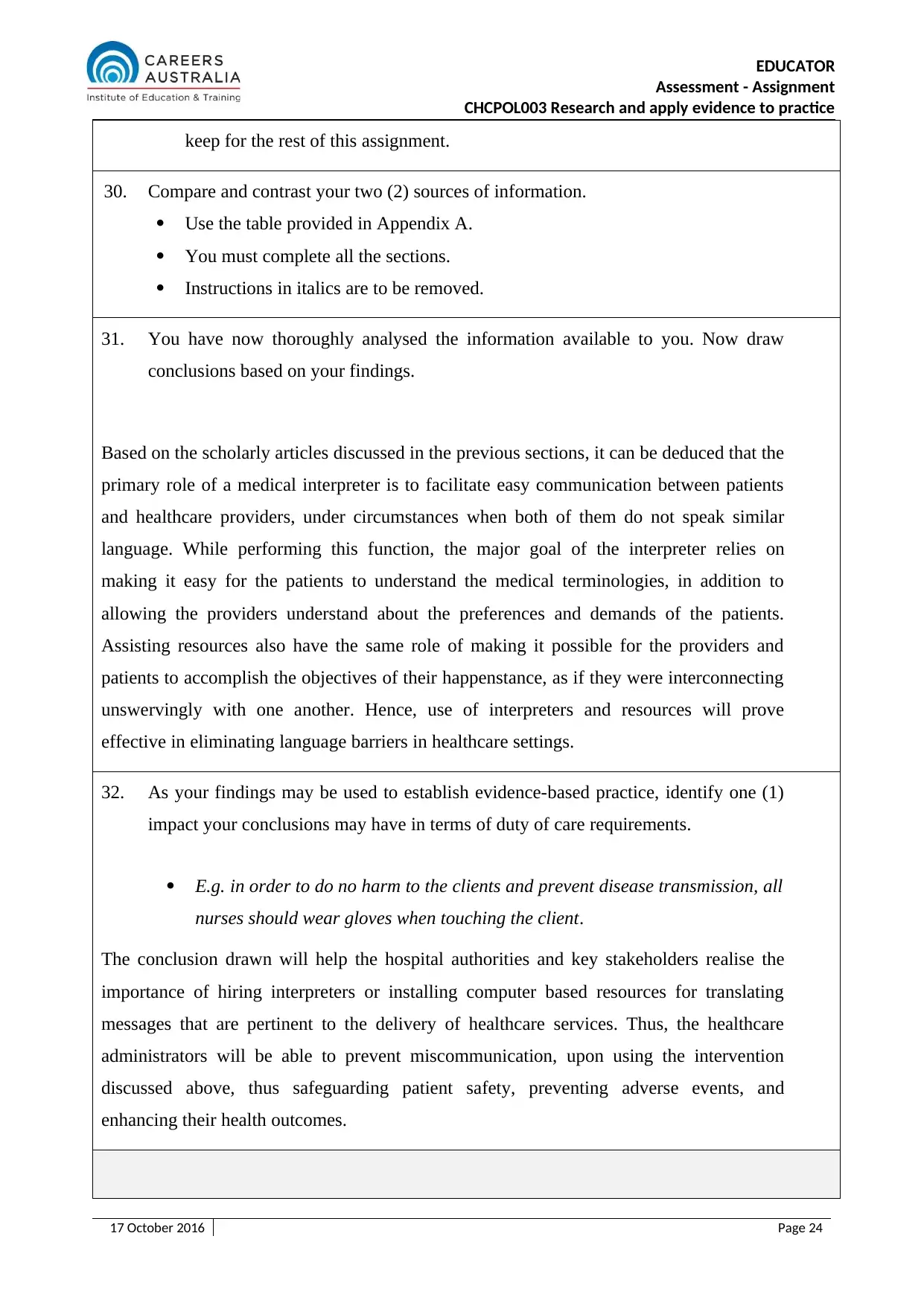
EDUCATOR
Assessment - Assignment
CHCPOL003 Research and apply evidence to practice
keep for the rest of this assignment.
30. Compare and contrast your two (2) sources of information.
Use the table provided in Appendix A.
You must complete all the sections.
Instructions in italics are to be removed.
31. You have now thoroughly analysed the information available to you. Now draw
conclusions based on your findings.
Based on the scholarly articles discussed in the previous sections, it can be deduced that the
primary role of a medical interpreter is to facilitate easy communication between patients
and healthcare providers, under circumstances when both of them do not speak similar
language. While performing this function, the major goal of the interpreter relies on
making it easy for the patients to understand the medical terminologies, in addition to
allowing the providers understand about the preferences and demands of the patients.
Assisting resources also have the same role of making it possible for the providers and
patients to accomplish the objectives of their happenstance, as if they were interconnecting
unswervingly with one another. Hence, use of interpreters and resources will prove
effective in eliminating language barriers in healthcare settings.
32. As your findings may be used to establish evidence-based practice, identify one (1)
impact your conclusions may have in terms of duty of care requirements.
E.g. in order to do no harm to the clients and prevent disease transmission, all
nurses should wear gloves when touching the client.
The conclusion drawn will help the hospital authorities and key stakeholders realise the
importance of hiring interpreters or installing computer based resources for translating
messages that are pertinent to the delivery of healthcare services. Thus, the healthcare
administrators will be able to prevent miscommunication, upon using the intervention
discussed above, thus safeguarding patient safety, preventing adverse events, and
enhancing their health outcomes.
17 October 2016 Page 24
Assessment - Assignment
CHCPOL003 Research and apply evidence to practice
keep for the rest of this assignment.
30. Compare and contrast your two (2) sources of information.
Use the table provided in Appendix A.
You must complete all the sections.
Instructions in italics are to be removed.
31. You have now thoroughly analysed the information available to you. Now draw
conclusions based on your findings.
Based on the scholarly articles discussed in the previous sections, it can be deduced that the
primary role of a medical interpreter is to facilitate easy communication between patients
and healthcare providers, under circumstances when both of them do not speak similar
language. While performing this function, the major goal of the interpreter relies on
making it easy for the patients to understand the medical terminologies, in addition to
allowing the providers understand about the preferences and demands of the patients.
Assisting resources also have the same role of making it possible for the providers and
patients to accomplish the objectives of their happenstance, as if they were interconnecting
unswervingly with one another. Hence, use of interpreters and resources will prove
effective in eliminating language barriers in healthcare settings.
32. As your findings may be used to establish evidence-based practice, identify one (1)
impact your conclusions may have in terms of duty of care requirements.
E.g. in order to do no harm to the clients and prevent disease transmission, all
nurses should wear gloves when touching the client.
The conclusion drawn will help the hospital authorities and key stakeholders realise the
importance of hiring interpreters or installing computer based resources for translating
messages that are pertinent to the delivery of healthcare services. Thus, the healthcare
administrators will be able to prevent miscommunication, upon using the intervention
discussed above, thus safeguarding patient safety, preventing adverse events, and
enhancing their health outcomes.
17 October 2016 Page 24
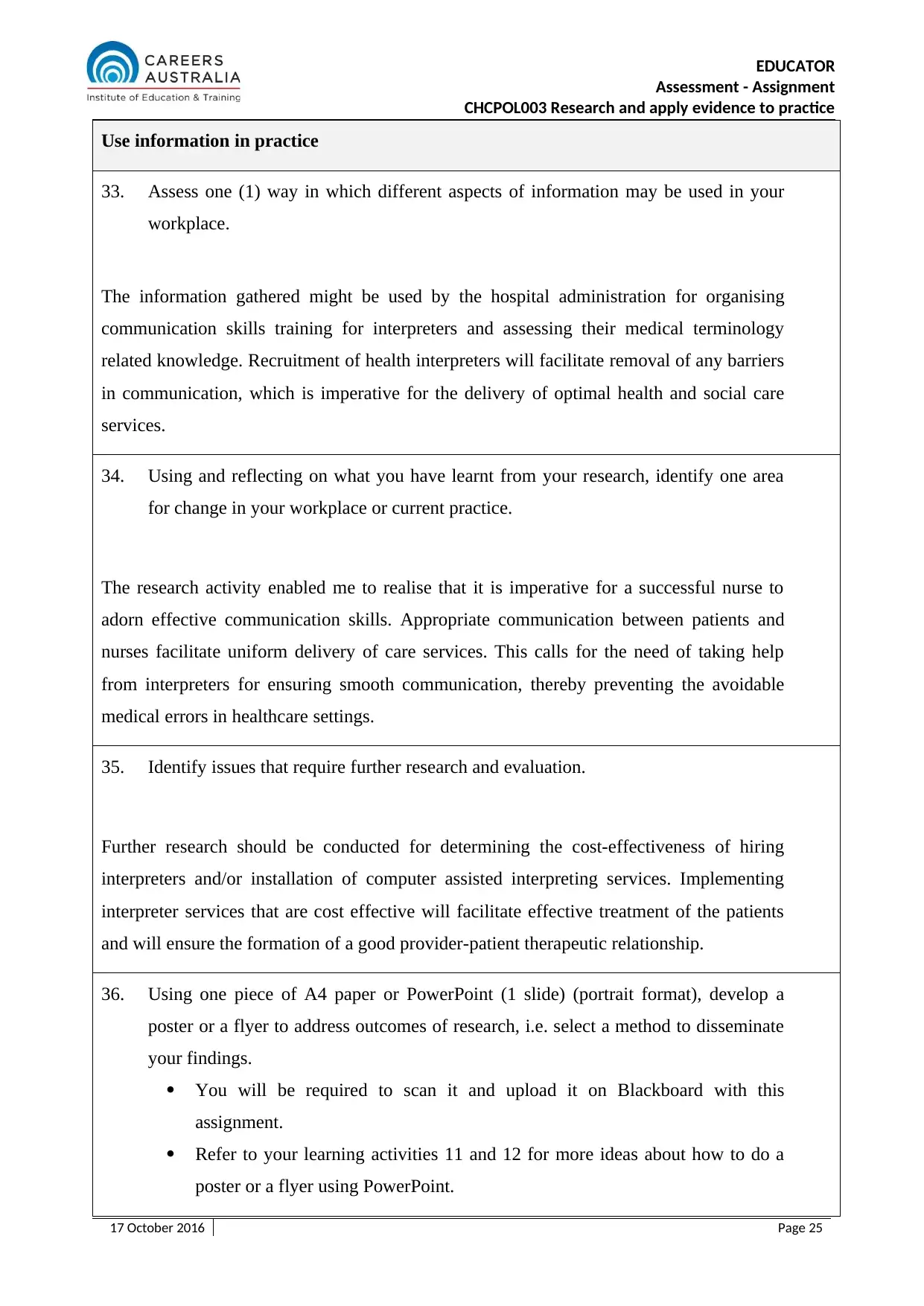
EDUCATOR
Assessment - Assignment
CHCPOL003 Research and apply evidence to practice
Use information in practice
33. Assess one (1) way in which different aspects of information may be used in your
workplace.
The information gathered might be used by the hospital administration for organising
communication skills training for interpreters and assessing their medical terminology
related knowledge. Recruitment of health interpreters will facilitate removal of any barriers
in communication, which is imperative for the delivery of optimal health and social care
services.
34. Using and reflecting on what you have learnt from your research, identify one area
for change in your workplace or current practice.
The research activity enabled me to realise that it is imperative for a successful nurse to
adorn effective communication skills. Appropriate communication between patients and
nurses facilitate uniform delivery of care services. This calls for the need of taking help
from interpreters for ensuring smooth communication, thereby preventing the avoidable
medical errors in healthcare settings.
35. Identify issues that require further research and evaluation.
Further research should be conducted for determining the cost-effectiveness of hiring
interpreters and/or installation of computer assisted interpreting services. Implementing
interpreter services that are cost effective will facilitate effective treatment of the patients
and will ensure the formation of a good provider-patient therapeutic relationship.
36. Using one piece of A4 paper or PowerPoint (1 slide) (portrait format), develop a
poster or a flyer to address outcomes of research, i.e. select a method to disseminate
your findings.
You will be required to scan it and upload it on Blackboard with this
assignment.
Refer to your learning activities 11 and 12 for more ideas about how to do a
poster or a flyer using PowerPoint.
17 October 2016 Page 25
Assessment - Assignment
CHCPOL003 Research and apply evidence to practice
Use information in practice
33. Assess one (1) way in which different aspects of information may be used in your
workplace.
The information gathered might be used by the hospital administration for organising
communication skills training for interpreters and assessing their medical terminology
related knowledge. Recruitment of health interpreters will facilitate removal of any barriers
in communication, which is imperative for the delivery of optimal health and social care
services.
34. Using and reflecting on what you have learnt from your research, identify one area
for change in your workplace or current practice.
The research activity enabled me to realise that it is imperative for a successful nurse to
adorn effective communication skills. Appropriate communication between patients and
nurses facilitate uniform delivery of care services. This calls for the need of taking help
from interpreters for ensuring smooth communication, thereby preventing the avoidable
medical errors in healthcare settings.
35. Identify issues that require further research and evaluation.
Further research should be conducted for determining the cost-effectiveness of hiring
interpreters and/or installation of computer assisted interpreting services. Implementing
interpreter services that are cost effective will facilitate effective treatment of the patients
and will ensure the formation of a good provider-patient therapeutic relationship.
36. Using one piece of A4 paper or PowerPoint (1 slide) (portrait format), develop a
poster or a flyer to address outcomes of research, i.e. select a method to disseminate
your findings.
You will be required to scan it and upload it on Blackboard with this
assignment.
Refer to your learning activities 11 and 12 for more ideas about how to do a
poster or a flyer using PowerPoint.
17 October 2016 Page 25
Paraphrase This Document
Need a fresh take? Get an instant paraphrase of this document with our AI Paraphraser
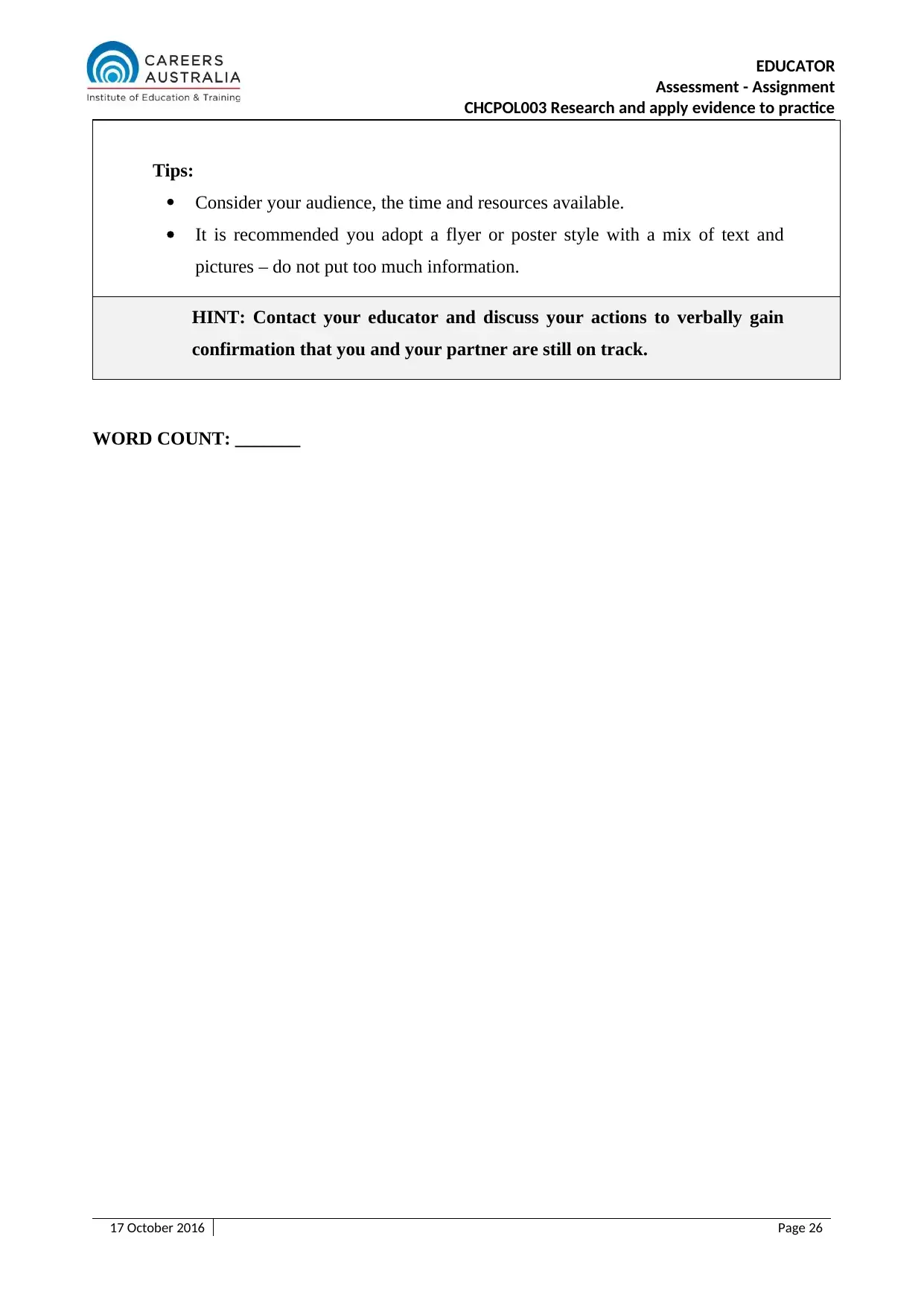
EDUCATOR
Assessment - Assignment
CHCPOL003 Research and apply evidence to practice
Tips:
Consider your audience, the time and resources available.
It is recommended you adopt a flyer or poster style with a mix of text and
pictures – do not put too much information.
HINT: Contact your educator and discuss your actions to verbally gain
confirmation that you and your partner are still on track.
WORD COUNT: _______
17 October 2016 Page 26
Assessment - Assignment
CHCPOL003 Research and apply evidence to practice
Tips:
Consider your audience, the time and resources available.
It is recommended you adopt a flyer or poster style with a mix of text and
pictures – do not put too much information.
HINT: Contact your educator and discuss your actions to verbally gain
confirmation that you and your partner are still on track.
WORD COUNT: _______
17 October 2016 Page 26
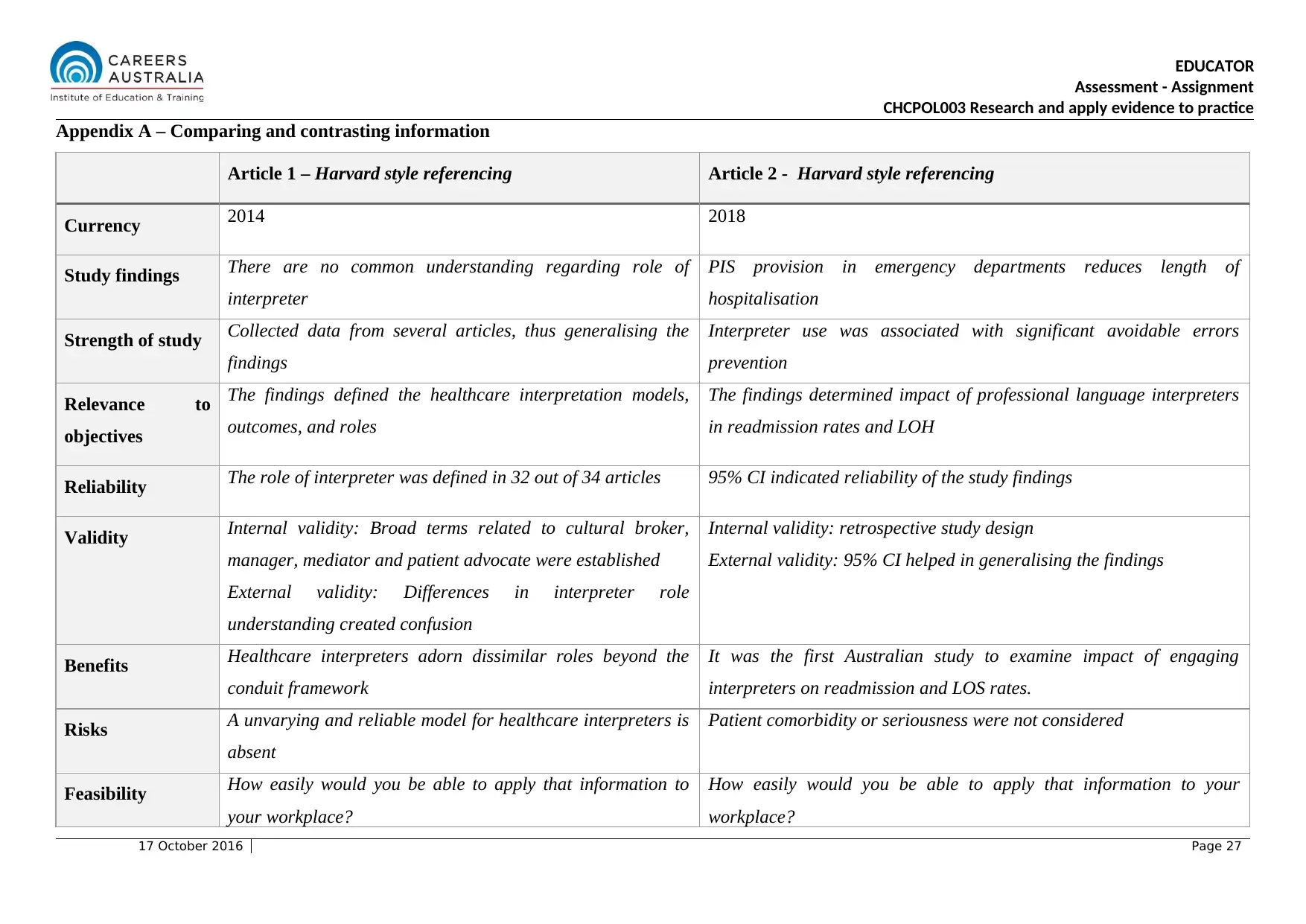
EDUCATOR
Assessment - Assignment
CHCPOL003 Research and apply evidence to practice
Appendix A – Comparing and contrasting information
Article 1 – Harvard style referencing Article 2 - Harvard style referencing
Currency 2014 2018
Study findings There are no common understanding regarding role of
interpreter
PIS provision in emergency departments reduces length of
hospitalisation
Strength of study Collected data from several articles, thus generalising the
findings
Interpreter use was associated with significant avoidable errors
prevention
Relevance to
objectives
The findings defined the healthcare interpretation models,
outcomes, and roles
The findings determined impact of professional language interpreters
in readmission rates and LOH
Reliability The role of interpreter was defined in 32 out of 34 articles 95% CI indicated reliability of the study findings
Validity Internal validity: Broad terms related to cultural broker,
manager, mediator and patient advocate were established
External validity: Differences in interpreter role
understanding created confusion
Internal validity: retrospective study design
External validity: 95% CI helped in generalising the findings
Benefits Healthcare interpreters adorn dissimilar roles beyond the
conduit framework
It was the first Australian study to examine impact of engaging
interpreters on readmission and LOS rates.
Risks A unvarying and reliable model for healthcare interpreters is
absent
Patient comorbidity or seriousness were not considered
Feasibility How easily would you be able to apply that information to
your workplace?
How easily would you be able to apply that information to your
workplace?
17 October 2016 Page 27
Assessment - Assignment
CHCPOL003 Research and apply evidence to practice
Appendix A – Comparing and contrasting information
Article 1 – Harvard style referencing Article 2 - Harvard style referencing
Currency 2014 2018
Study findings There are no common understanding regarding role of
interpreter
PIS provision in emergency departments reduces length of
hospitalisation
Strength of study Collected data from several articles, thus generalising the
findings
Interpreter use was associated with significant avoidable errors
prevention
Relevance to
objectives
The findings defined the healthcare interpretation models,
outcomes, and roles
The findings determined impact of professional language interpreters
in readmission rates and LOH
Reliability The role of interpreter was defined in 32 out of 34 articles 95% CI indicated reliability of the study findings
Validity Internal validity: Broad terms related to cultural broker,
manager, mediator and patient advocate were established
External validity: Differences in interpreter role
understanding created confusion
Internal validity: retrospective study design
External validity: 95% CI helped in generalising the findings
Benefits Healthcare interpreters adorn dissimilar roles beyond the
conduit framework
It was the first Australian study to examine impact of engaging
interpreters on readmission and LOS rates.
Risks A unvarying and reliable model for healthcare interpreters is
absent
Patient comorbidity or seriousness were not considered
Feasibility How easily would you be able to apply that information to
your workplace?
How easily would you be able to apply that information to your
workplace?
17 October 2016 Page 27
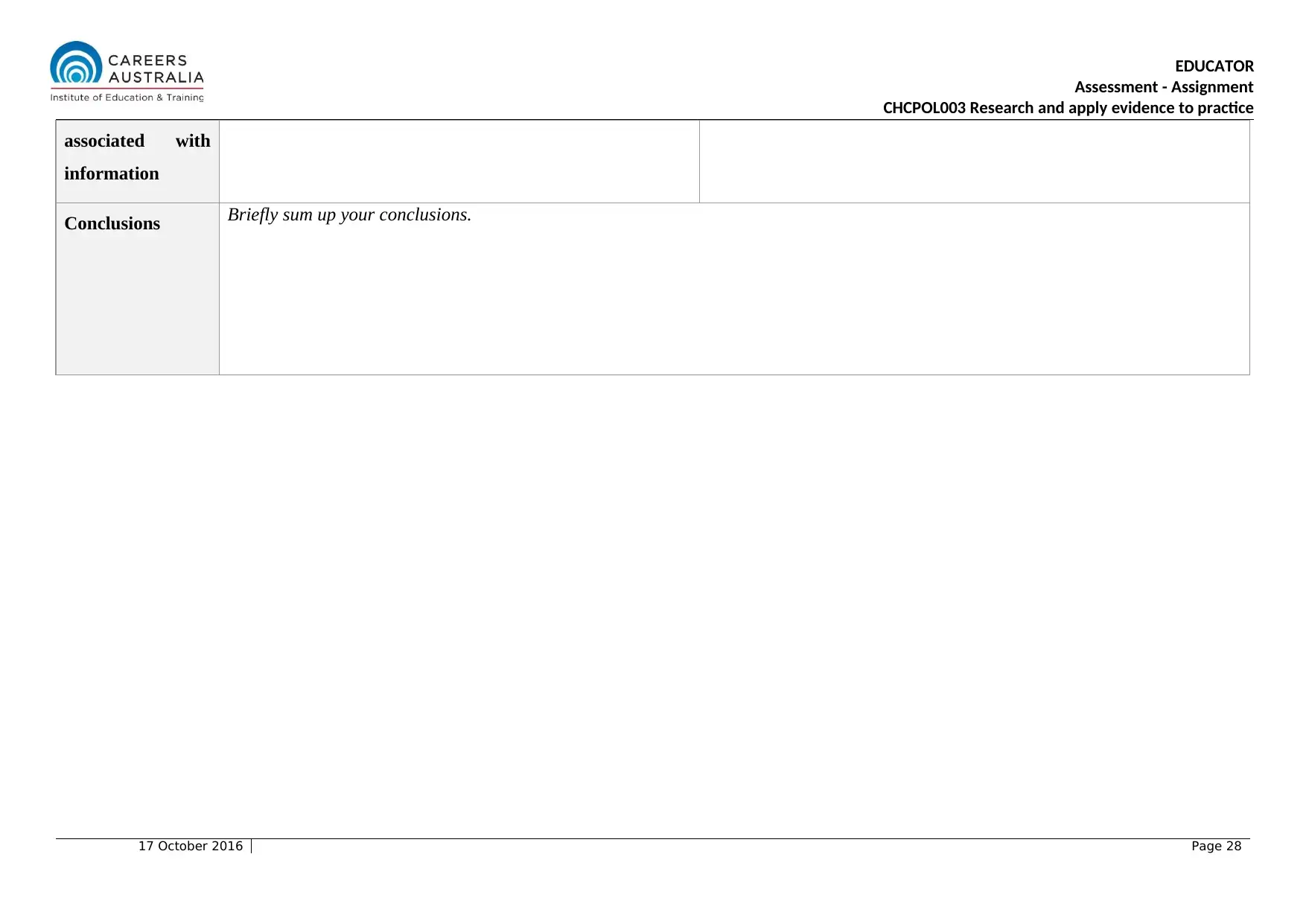
EDUCATOR
Assessment - Assignment
CHCPOL003 Research and apply evidence to practice
associated with
information
Conclusions Briefly sum up your conclusions.
17 October 2016 Page 28
Assessment - Assignment
CHCPOL003 Research and apply evidence to practice
associated with
information
Conclusions Briefly sum up your conclusions.
17 October 2016 Page 28
Secure Best Marks with AI Grader
Need help grading? Try our AI Grader for instant feedback on your assignments.
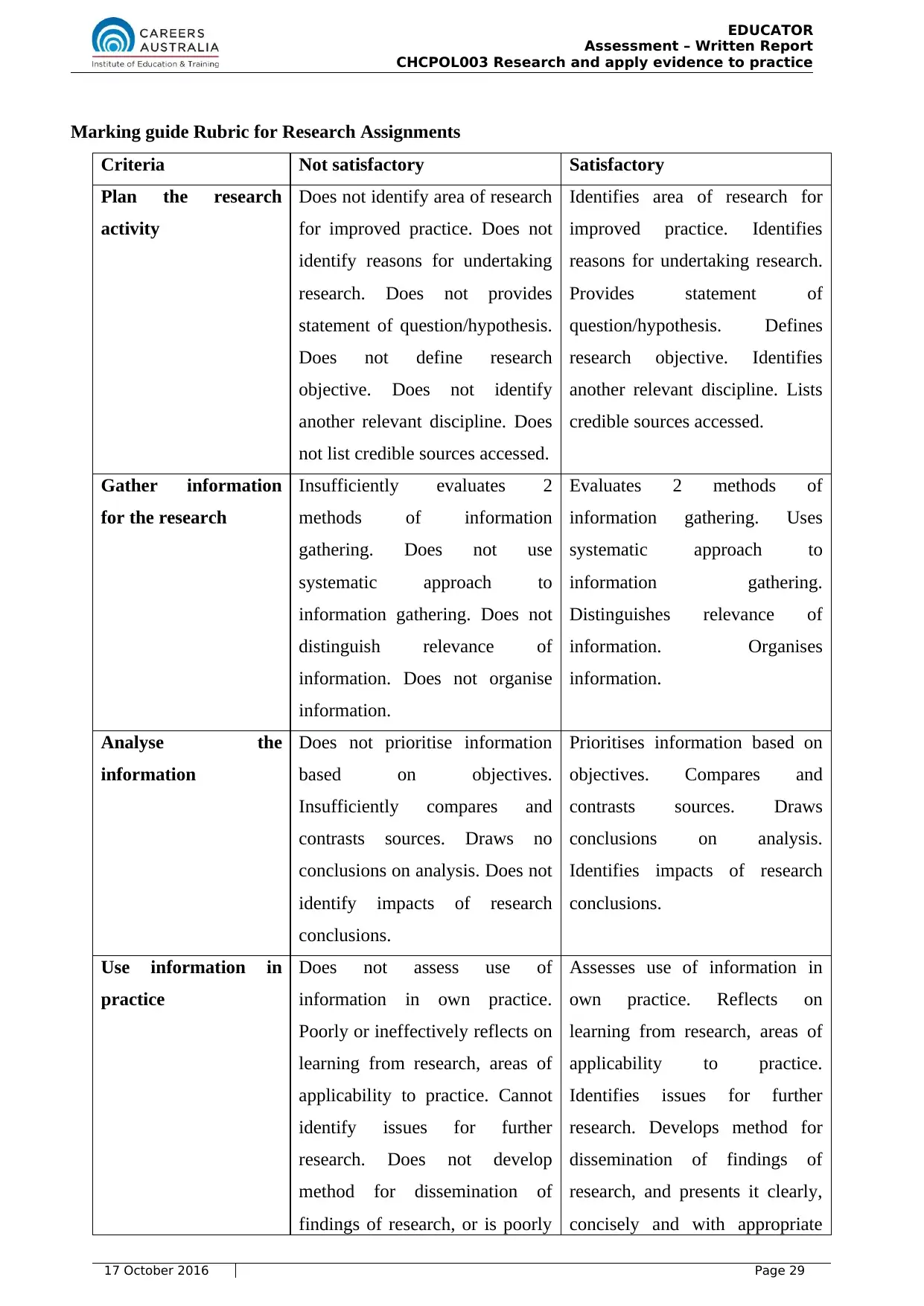
EDUCATOR
Assessment – Written Report
CHCPOL003 Research and apply evidence to practice
Marking guide Rubric for Research Assignments
Criteria Not satisfactory Satisfactory
Plan the research
activity
Does not identify area of research
for improved practice. Does not
identify reasons for undertaking
research. Does not provides
statement of question/hypothesis.
Does not define research
objective. Does not identify
another relevant discipline. Does
not list credible sources accessed.
Identifies area of research for
improved practice. Identifies
reasons for undertaking research.
Provides statement of
question/hypothesis. Defines
research objective. Identifies
another relevant discipline. Lists
credible sources accessed.
Gather information
for the research
Insufficiently evaluates 2
methods of information
gathering. Does not use
systematic approach to
information gathering. Does not
distinguish relevance of
information. Does not organise
information.
Evaluates 2 methods of
information gathering. Uses
systematic approach to
information gathering.
Distinguishes relevance of
information. Organises
information.
Analyse the
information
Does not prioritise information
based on objectives.
Insufficiently compares and
contrasts sources. Draws no
conclusions on analysis. Does not
identify impacts of research
conclusions.
Prioritises information based on
objectives. Compares and
contrasts sources. Draws
conclusions on analysis.
Identifies impacts of research
conclusions.
Use information in
practice
Does not assess use of
information in own practice.
Poorly or ineffectively reflects on
learning from research, areas of
applicability to practice. Cannot
identify issues for further
research. Does not develop
method for dissemination of
findings of research, or is poorly
Assesses use of information in
own practice. Reflects on
learning from research, areas of
applicability to practice.
Identifies issues for further
research. Develops method for
dissemination of findings of
research, and presents it clearly,
concisely and with appropriate
17 October 2016 Page 29
Assessment – Written Report
CHCPOL003 Research and apply evidence to practice
Marking guide Rubric for Research Assignments
Criteria Not satisfactory Satisfactory
Plan the research
activity
Does not identify area of research
for improved practice. Does not
identify reasons for undertaking
research. Does not provides
statement of question/hypothesis.
Does not define research
objective. Does not identify
another relevant discipline. Does
not list credible sources accessed.
Identifies area of research for
improved practice. Identifies
reasons for undertaking research.
Provides statement of
question/hypothesis. Defines
research objective. Identifies
another relevant discipline. Lists
credible sources accessed.
Gather information
for the research
Insufficiently evaluates 2
methods of information
gathering. Does not use
systematic approach to
information gathering. Does not
distinguish relevance of
information. Does not organise
information.
Evaluates 2 methods of
information gathering. Uses
systematic approach to
information gathering.
Distinguishes relevance of
information. Organises
information.
Analyse the
information
Does not prioritise information
based on objectives.
Insufficiently compares and
contrasts sources. Draws no
conclusions on analysis. Does not
identify impacts of research
conclusions.
Prioritises information based on
objectives. Compares and
contrasts sources. Draws
conclusions on analysis.
Identifies impacts of research
conclusions.
Use information in
practice
Does not assess use of
information in own practice.
Poorly or ineffectively reflects on
learning from research, areas of
applicability to practice. Cannot
identify issues for further
research. Does not develop
method for dissemination of
findings of research, or is poorly
Assesses use of information in
own practice. Reflects on
learning from research, areas of
applicability to practice.
Identifies issues for further
research. Develops method for
dissemination of findings of
research, and presents it clearly,
concisely and with appropriate
17 October 2016 Page 29
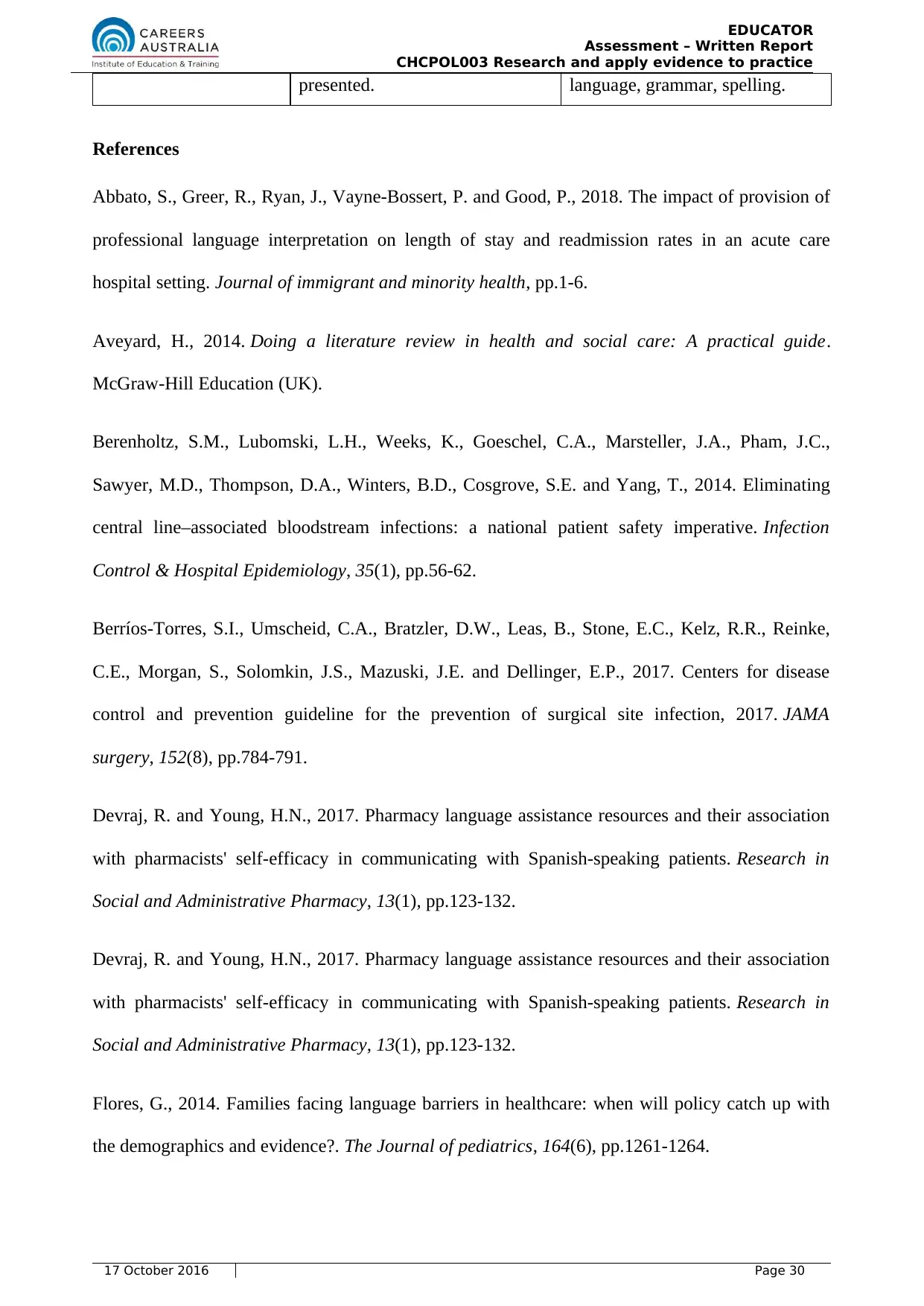
EDUCATOR
Assessment – Written Report
CHCPOL003 Research and apply evidence to practice
presented. language, grammar, spelling.
References
Abbato, S., Greer, R., Ryan, J., Vayne-Bossert, P. and Good, P., 2018. The impact of provision of
professional language interpretation on length of stay and readmission rates in an acute care
hospital setting. Journal of immigrant and minority health, pp.1-6.
Aveyard, H., 2014. Doing a literature review in health and social care: A practical guide.
McGraw-Hill Education (UK).
Berenholtz, S.M., Lubomski, L.H., Weeks, K., Goeschel, C.A., Marsteller, J.A., Pham, J.C.,
Sawyer, M.D., Thompson, D.A., Winters, B.D., Cosgrove, S.E. and Yang, T., 2014. Eliminating
central line–associated bloodstream infections: a national patient safety imperative. Infection
Control & Hospital Epidemiology, 35(1), pp.56-62.
Berríos-Torres, S.I., Umscheid, C.A., Bratzler, D.W., Leas, B., Stone, E.C., Kelz, R.R., Reinke,
C.E., Morgan, S., Solomkin, J.S., Mazuski, J.E. and Dellinger, E.P., 2017. Centers for disease
control and prevention guideline for the prevention of surgical site infection, 2017. JAMA
surgery, 152(8), pp.784-791.
Devraj, R. and Young, H.N., 2017. Pharmacy language assistance resources and their association
with pharmacists' self-efficacy in communicating with Spanish-speaking patients. Research in
Social and Administrative Pharmacy, 13(1), pp.123-132.
Devraj, R. and Young, H.N., 2017. Pharmacy language assistance resources and their association
with pharmacists' self-efficacy in communicating with Spanish-speaking patients. Research in
Social and Administrative Pharmacy, 13(1), pp.123-132.
Flores, G., 2014. Families facing language barriers in healthcare: when will policy catch up with
the demographics and evidence?. The Journal of pediatrics, 164(6), pp.1261-1264.
17 October 2016 Page 30
Assessment – Written Report
CHCPOL003 Research and apply evidence to practice
presented. language, grammar, spelling.
References
Abbato, S., Greer, R., Ryan, J., Vayne-Bossert, P. and Good, P., 2018. The impact of provision of
professional language interpretation on length of stay and readmission rates in an acute care
hospital setting. Journal of immigrant and minority health, pp.1-6.
Aveyard, H., 2014. Doing a literature review in health and social care: A practical guide.
McGraw-Hill Education (UK).
Berenholtz, S.M., Lubomski, L.H., Weeks, K., Goeschel, C.A., Marsteller, J.A., Pham, J.C.,
Sawyer, M.D., Thompson, D.A., Winters, B.D., Cosgrove, S.E. and Yang, T., 2014. Eliminating
central line–associated bloodstream infections: a national patient safety imperative. Infection
Control & Hospital Epidemiology, 35(1), pp.56-62.
Berríos-Torres, S.I., Umscheid, C.A., Bratzler, D.W., Leas, B., Stone, E.C., Kelz, R.R., Reinke,
C.E., Morgan, S., Solomkin, J.S., Mazuski, J.E. and Dellinger, E.P., 2017. Centers for disease
control and prevention guideline for the prevention of surgical site infection, 2017. JAMA
surgery, 152(8), pp.784-791.
Devraj, R. and Young, H.N., 2017. Pharmacy language assistance resources and their association
with pharmacists' self-efficacy in communicating with Spanish-speaking patients. Research in
Social and Administrative Pharmacy, 13(1), pp.123-132.
Devraj, R. and Young, H.N., 2017. Pharmacy language assistance resources and their association
with pharmacists' self-efficacy in communicating with Spanish-speaking patients. Research in
Social and Administrative Pharmacy, 13(1), pp.123-132.
Flores, G., 2014. Families facing language barriers in healthcare: when will policy catch up with
the demographics and evidence?. The Journal of pediatrics, 164(6), pp.1261-1264.
17 October 2016 Page 30
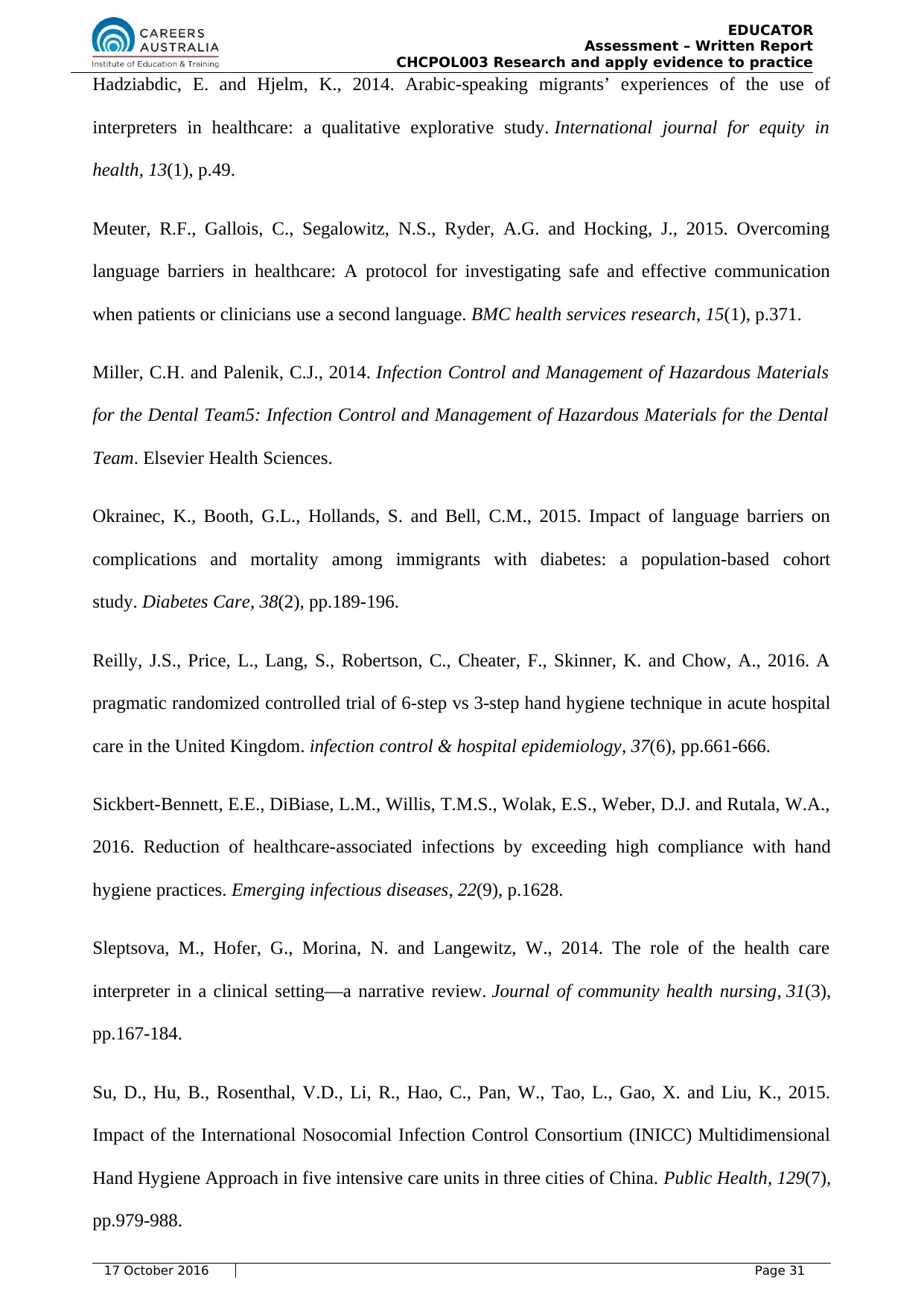
EDUCATOR
Assessment – Written Report
CHCPOL003 Research and apply evidence to practice
Hadziabdic, E. and Hjelm, K., 2014. Arabic-speaking migrants’ experiences of the use of
interpreters in healthcare: a qualitative explorative study. International journal for equity in
health, 13(1), p.49.
Meuter, R.F., Gallois, C., Segalowitz, N.S., Ryder, A.G. and Hocking, J., 2015. Overcoming
language barriers in healthcare: A protocol for investigating safe and effective communication
when patients or clinicians use a second language. BMC health services research, 15(1), p.371.
Miller, C.H. and Palenik, C.J., 2014. Infection Control and Management of Hazardous Materials
for the Dental Team5: Infection Control and Management of Hazardous Materials for the Dental
Team. Elsevier Health Sciences.
Okrainec, K., Booth, G.L., Hollands, S. and Bell, C.M., 2015. Impact of language barriers on
complications and mortality among immigrants with diabetes: a population-based cohort
study. Diabetes Care, 38(2), pp.189-196.
Reilly, J.S., Price, L., Lang, S., Robertson, C., Cheater, F., Skinner, K. and Chow, A., 2016. A
pragmatic randomized controlled trial of 6-step vs 3-step hand hygiene technique in acute hospital
care in the United Kingdom. infection control & hospital epidemiology, 37(6), pp.661-666.
Sickbert-Bennett, E.E., DiBiase, L.M., Willis, T.M.S., Wolak, E.S., Weber, D.J. and Rutala, W.A.,
2016. Reduction of healthcare-associated infections by exceeding high compliance with hand
hygiene practices. Emerging infectious diseases, 22(9), p.1628.
Sleptsova, M., Hofer, G., Morina, N. and Langewitz, W., 2014. The role of the health care
interpreter in a clinical setting—a narrative review. Journal of community health nursing, 31(3),
pp.167-184.
Su, D., Hu, B., Rosenthal, V.D., Li, R., Hao, C., Pan, W., Tao, L., Gao, X. and Liu, K., 2015.
Impact of the International Nosocomial Infection Control Consortium (INICC) Multidimensional
Hand Hygiene Approach in five intensive care units in three cities of China. Public Health, 129(7),
pp.979-988.
17 October 2016 Page 31
Assessment – Written Report
CHCPOL003 Research and apply evidence to practice
Hadziabdic, E. and Hjelm, K., 2014. Arabic-speaking migrants’ experiences of the use of
interpreters in healthcare: a qualitative explorative study. International journal for equity in
health, 13(1), p.49.
Meuter, R.F., Gallois, C., Segalowitz, N.S., Ryder, A.G. and Hocking, J., 2015. Overcoming
language barriers in healthcare: A protocol for investigating safe and effective communication
when patients or clinicians use a second language. BMC health services research, 15(1), p.371.
Miller, C.H. and Palenik, C.J., 2014. Infection Control and Management of Hazardous Materials
for the Dental Team5: Infection Control and Management of Hazardous Materials for the Dental
Team. Elsevier Health Sciences.
Okrainec, K., Booth, G.L., Hollands, S. and Bell, C.M., 2015. Impact of language barriers on
complications and mortality among immigrants with diabetes: a population-based cohort
study. Diabetes Care, 38(2), pp.189-196.
Reilly, J.S., Price, L., Lang, S., Robertson, C., Cheater, F., Skinner, K. and Chow, A., 2016. A
pragmatic randomized controlled trial of 6-step vs 3-step hand hygiene technique in acute hospital
care in the United Kingdom. infection control & hospital epidemiology, 37(6), pp.661-666.
Sickbert-Bennett, E.E., DiBiase, L.M., Willis, T.M.S., Wolak, E.S., Weber, D.J. and Rutala, W.A.,
2016. Reduction of healthcare-associated infections by exceeding high compliance with hand
hygiene practices. Emerging infectious diseases, 22(9), p.1628.
Sleptsova, M., Hofer, G., Morina, N. and Langewitz, W., 2014. The role of the health care
interpreter in a clinical setting—a narrative review. Journal of community health nursing, 31(3),
pp.167-184.
Su, D., Hu, B., Rosenthal, V.D., Li, R., Hao, C., Pan, W., Tao, L., Gao, X. and Liu, K., 2015.
Impact of the International Nosocomial Infection Control Consortium (INICC) Multidimensional
Hand Hygiene Approach in five intensive care units in three cities of China. Public Health, 129(7),
pp.979-988.
17 October 2016 Page 31
Paraphrase This Document
Need a fresh take? Get an instant paraphrase of this document with our AI Paraphraser
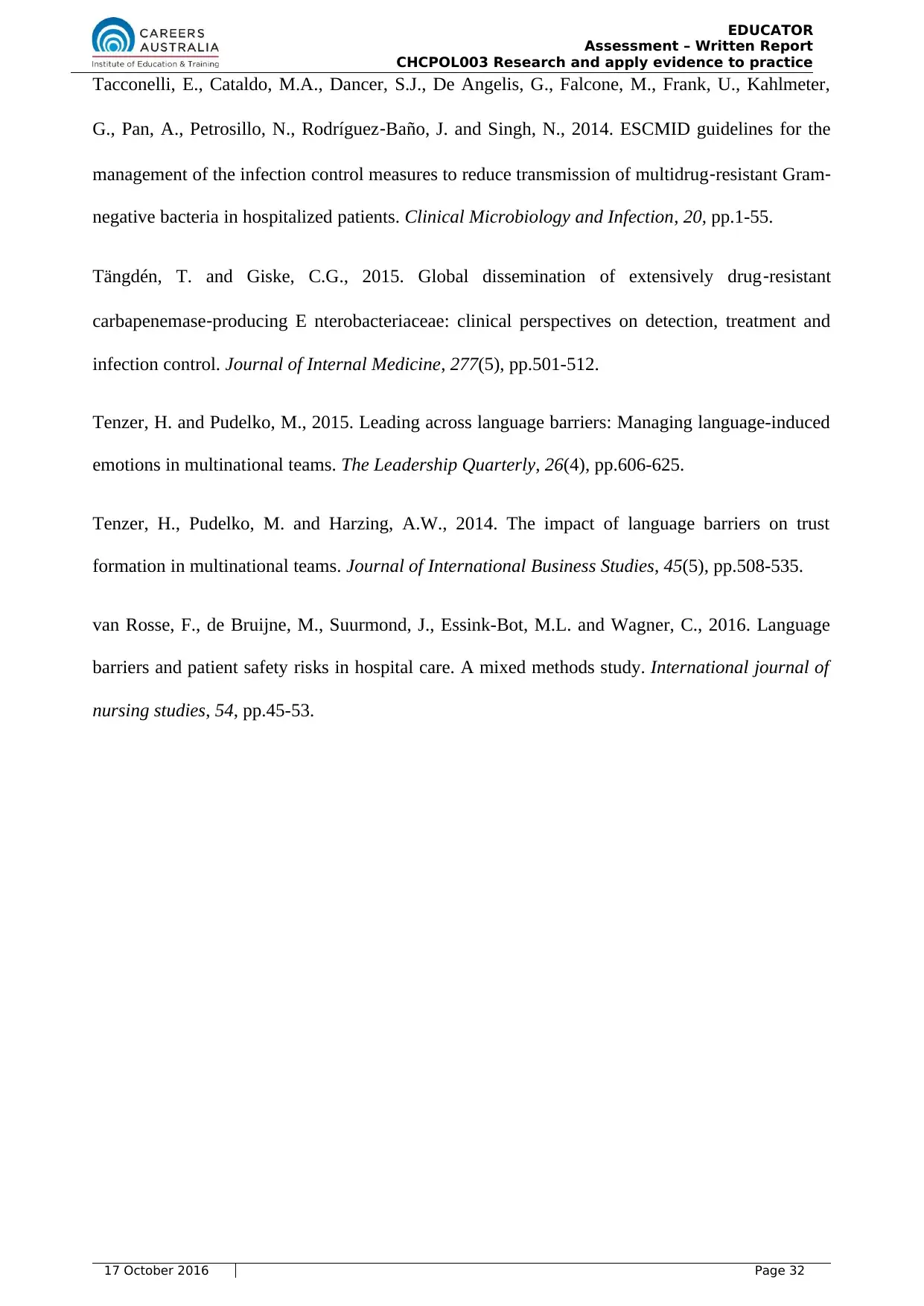
EDUCATOR
Assessment – Written Report
CHCPOL003 Research and apply evidence to practice
Tacconelli, E., Cataldo, M.A., Dancer, S.J., De Angelis, G., Falcone, M., Frank, U., Kahlmeter,
G., Pan, A., Petrosillo, N., Rodríguez‐Baño, J. and Singh, N., 2014. ESCMID guidelines for the
management of the infection control measures to reduce transmission of multidrug‐resistant Gram‐
negative bacteria in hospitalized patients. Clinical Microbiology and Infection, 20, pp.1-55.
Tängdén, T. and Giske, C.G., 2015. Global dissemination of extensively drug‐resistant
carbapenemase‐producing E nterobacteriaceae: clinical perspectives on detection, treatment and
infection control. Journal of Internal Medicine, 277(5), pp.501-512.
Tenzer, H. and Pudelko, M., 2015. Leading across language barriers: Managing language-induced
emotions in multinational teams. The Leadership Quarterly, 26(4), pp.606-625.
Tenzer, H., Pudelko, M. and Harzing, A.W., 2014. The impact of language barriers on trust
formation in multinational teams. Journal of International Business Studies, 45(5), pp.508-535.
van Rosse, F., de Bruijne, M., Suurmond, J., Essink-Bot, M.L. and Wagner, C., 2016. Language
barriers and patient safety risks in hospital care. A mixed methods study. International journal of
nursing studies, 54, pp.45-53.
17 October 2016 Page 32
Assessment – Written Report
CHCPOL003 Research and apply evidence to practice
Tacconelli, E., Cataldo, M.A., Dancer, S.J., De Angelis, G., Falcone, M., Frank, U., Kahlmeter,
G., Pan, A., Petrosillo, N., Rodríguez‐Baño, J. and Singh, N., 2014. ESCMID guidelines for the
management of the infection control measures to reduce transmission of multidrug‐resistant Gram‐
negative bacteria in hospitalized patients. Clinical Microbiology and Infection, 20, pp.1-55.
Tängdén, T. and Giske, C.G., 2015. Global dissemination of extensively drug‐resistant
carbapenemase‐producing E nterobacteriaceae: clinical perspectives on detection, treatment and
infection control. Journal of Internal Medicine, 277(5), pp.501-512.
Tenzer, H. and Pudelko, M., 2015. Leading across language barriers: Managing language-induced
emotions in multinational teams. The Leadership Quarterly, 26(4), pp.606-625.
Tenzer, H., Pudelko, M. and Harzing, A.W., 2014. The impact of language barriers on trust
formation in multinational teams. Journal of International Business Studies, 45(5), pp.508-535.
van Rosse, F., de Bruijne, M., Suurmond, J., Essink-Bot, M.L. and Wagner, C., 2016. Language
barriers and patient safety risks in hospital care. A mixed methods study. International journal of
nursing studies, 54, pp.45-53.
17 October 2016 Page 32
1 out of 32
Related Documents
Your All-in-One AI-Powered Toolkit for Academic Success.
+13062052269
info@desklib.com
Available 24*7 on WhatsApp / Email
![[object Object]](/_next/static/media/star-bottom.7253800d.svg)
Unlock your academic potential
© 2024 | Zucol Services PVT LTD | All rights reserved.





